“Yes, We Have No Bananas”: It’s All Greek to Me
Roaming the web recently, I made a discovery, one that sheds light on the marriage between immigrants and fruit peddling. I had always assumed that the popular song, “Yes, We Have No Bananas,” was written about an Italian hawking fruit. I was wrong.
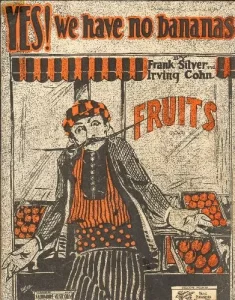
Sheet Music for “Yes, We Have No Bananas”
Thanks to Harry Karapalides and the Philly Greek-Style Blog for the revelation that the line came from a hit song released on March 23, 1933. The song, titled with that inimitable line, was composed by Frank Silver and Irving Cohn and later recorded by Benny Goodman, Jimmy Durante, Louis Prima, and
Spike Jones and his City Slickers. The peddler celebrated in the song was actually Greek.
Silver got the idea for the song from an encounter with a Greek fruit vendor. Silver, whose orchestra was playing at the Long Island Hotel, passed his stand every night. When the musician asked if he had bananas, his response was invariably, “Yessss, we have no bananas.” (Bananas were scarce because the Central American fruit then was riddled with disease.)
The line was so catchy that Silver felt impelled to write a song. “The jingle of his idiom haunted me,” the song writer recalled. The song’s first verse went like this:
There’s a fruit store on our street,
It’s run by a Greek,
And he keeps good things to eat,
But you should hear him speak!
When you ask him anything, he never answers “no.”
He just “yes”es you to death, and as he takes your dough,
He tells you,
Yes, we have no bananas.
Its chorus is memorable:
Yes, we have no bananas. We have-a no bananas today.
We’ve string beans, and onions, cabbageses and scallions,
And all sorts of fruit and say
We have an old fashioned to-mah-to. A Long Island po-tah-to,
But yes, we have no bananas. We have no bananas today.
Street vending, especially peddling fruit, was a handy occupation for the immigrant greenhorn. According to some estimates, 2,000 Greeks in Chicago were peddling produce in 1911. Looking for help, a fruit merchant would take on a kinsman for a job that required little English and required short encounters with customers.
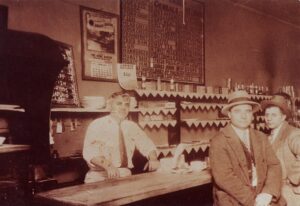
Greek Diner Owner
Peddling was also a stepping stone, a way to climb the job ladder. With savings, experience, and a sponsor, the vendor might improve his lot. He might move up, starting a small business—perhaps a hot dog stand, a lunchroom, or a shoeshine parlor. Many Greek newcomers chose this route.
Peter Bonduris, a New York City fruit peddler, funneled his kinsmen into jobs in Birmingham, Alabama, which had a large Greek enclave, after they had learned the ropes of his business.
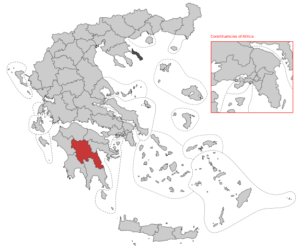
The Arcadian Region of Greece, Where the Village of Pelata Is Located
Over time, the new hand would pick up many of the habits, idiosyncrasies, and cultural nuances that could be learned in no other way. One of Peter Bonduris’s hires was John N. Bonduris, who came from Pelata, the same village in the Peloponnesus. John, who knew few words of English, had the same response to every customer’s question: “I don’t know and 10 cents a bunch.”
The Greek vendor was the purveyor of a fruit that was still novel and even forbidding. Some Americans worried that the fruit might be hard to digest and might upset their stomach. People also worried about a fruit sold on the street. The Literary Digest assured its readers that the fruit’s wrapper kept them “uncontaminated by dirt and germs, even if purchased from the pushcart in our congested streets.”
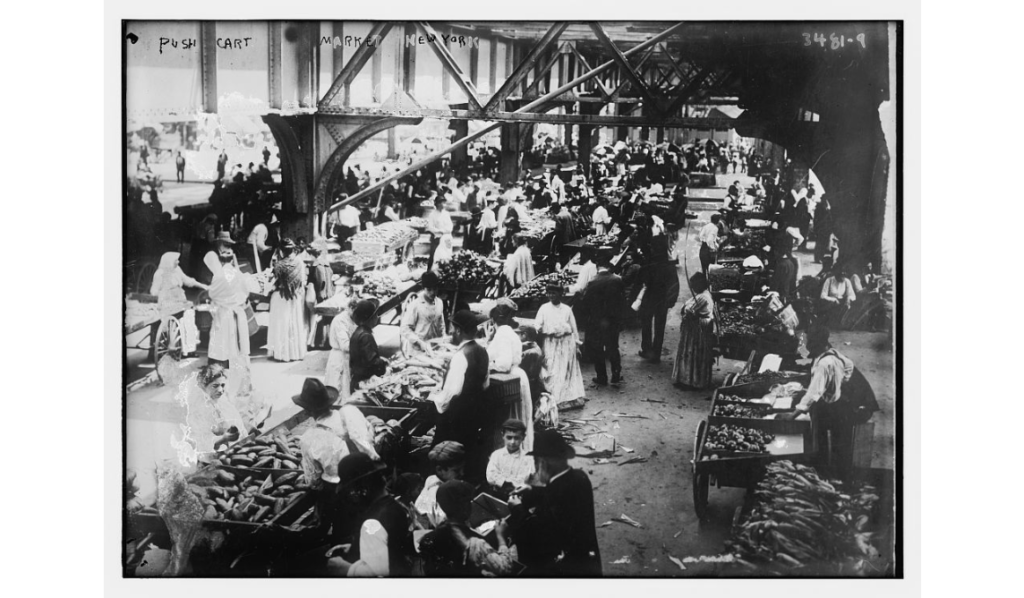
Push Cart Market, New York, Circa 1910-1915. Bain News Service
The immigrant peddler secured a place in American folklore. The mirth of “Yes, We Have No Bananas,” however, obscured the harshness of the vocation.
The peddler was often the victim of hostile prejudice. The Chicago Tribune heaped scorn on them: “Nearly every banana peddler in this city is a Greek. They herd together by the dozen, and have a head man who does all the buying, and usually drives a close bargain for a few banana bunches. The Greeks are of a very jealous disposition and believe all women are faithless. So they never marry in this country. They are filthy, shrewd, and of a low order intellectually. The profits of the day’s peddling are always divided equally among the company, and in this way they may be said to operate a small sized banana trust. They are born traders and carry on a profitable business, considering their daily expenses do not average more than 10 cents a day.”
Business groups pressed the city to stop the threat. In 1904, the Chicago Grocers Association urged the City Council to prohibit hawkers from peddling in alleys and streets.

Bananas
The Greeks also had to fend off rivals bent on stealing their business. In Chicago, Greeks and Italians battled for control: “… the Greeks have almost run the Italians out of the fruit business not only in a small retail way, but as wholesalers as well,” the Chicago Tribune declared in 1895. “As a result, there is a bitter feud between these two races, as deeply seated as the enmity that engendered the Graeco-Roman Wars.”
Despite the animosity, the immigrants were admired for their ambition and entrepreneurial drive: “… the Greek will not work at hard manual labor like digging sewers, carrying the hod, or building railways,” the same newspaper observed two years later. “He is either an artist or a merchant, generally the latter.”
Frustrated with their lowly status, the Greeks yearned for economic independence. These were not idle dreams. Many Greek street merchants pulled themselves up. In Chicago and other cities, they carved out a niche in the restaurant business. By 1913, according to sociologist Charles Moskos, there were at least 600 Greek-owned eateries in Chicago. Instead of peddling bananas, they were taking orders for coffee, hot dogs, and pie.
Lemon Tree, Very Pretty: Sicilian Immigrants and the Citrus Trade
It is thrilling to uncover nuggets buried in America’s ethnic history. Even before I started seriously writing about ethnic food, I was drawn to New Orleans. Its mix of cultures was fodder for my imagination. The port city I fixated on was an ensemble of African, Latin, French, and Creole flavors. In the beginning, these features, however exciting, were blurry. Their contours and details need filling in.
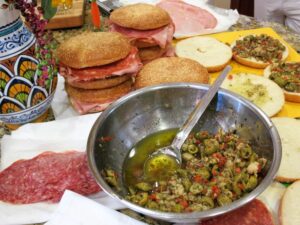
Muffuletta Sandwiches Being Prepared, with Their Signature Olive Relish
Calvin Trillin’s ode to New Orleans in the New Yorker, an account of his gastronomic expedition to the city, enticed me. My wife and I spent our honeymoon there, following Trillin’s lead and that of other writers. We snacked on red beans and rice at Buster Holmes’, a hole-in- the-wall in the French Quarter, celebrated by Trillin. We must have looked out of place when we asked for a menu and were given a barely legible list of items scrawled on butcher paper. On another day, I put on a required jacket and stood in line to dine at Galatoire’s, an institution of understated elegance, which paid homage to the city’s French and Creole culinary traditions. One late evening, we sat in the courtyard of the Napoleon House, a historic French Quarter establishment, savoring a muffuletta, one of New Orleans’s heralded sandwiches. We brought home a container of giardiniera, a mixture of olives, pickled carrots, celery, and tomatoes, from the Central Grocery Store. This relish frequently dressed the muffuletta.
For all this early immersion, I had just grazed the surface of the many layered city. When I began my investigation of America’s immigrant food, I chanced on a brief reference, a passing glance, in a New Orleans guidebook, to Progresso, a food business born in New Orleans. I knew Progresso mostly for its line of soups. I dug further and discovered that the company had been an early marketer of chickpeas, artichokes, roasted red peppers, and other Italian specialties that would later be displayed in the ethnic sections of supermarkets.
My curiosity whetted, I looked for more details. Progresso grew out of a peddling venture of Giuseppe Uddo, a young, adventurous Sicilian immigrant, who arrived in New Orleans in 1907 with his wife, Elenora. As a young boy, Giuseppe worked as a venditor, hawking olives and cheeses in his home town of Salemi and other nearby villages. After several false starts in New Orleans, he began vending cans of tomato paste, olives, and cheeses imported from his homeland. He carried them by horse and wagon to Italian truck farmers living on the outskirts of the city. Since Giuseppe refused to learn English, he depended on his horse, Sal, to guide him there. This was the beginning of Progresso, his son, Frank, told me. “The horse started the business.”
Uddo would team up with the Taorminos, another Sicilian clan who had opened an import business in New York City. The business marketed pomidori pelati (Italian peeled tomatoes), olives, and caponata, a favorite Sicilian appetizer, largely to small ethnic groceries. During World War II, Progresso shifted from imports to domestic production. The group bought a small factory in Vineland, in South Jersey, a heartland of Italian immigrant farmers. They canned and bottled roasted red peppers, hot cherry peppers, crushed tomatoes, and similar items. After the war, Progresso began searching for a year-round producer. They started making the country’s early ready-to-serve soups like minestrone and pasta e fagioli (pasta fazool), a mixture of broken-up pasta and beans in a tomato and salt pork sauce. Chain supermarkets now bought a larger share of the company’s products.
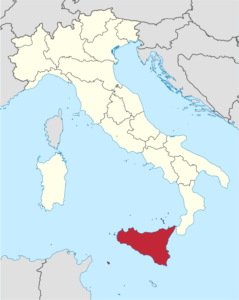
Map of Italy, with Sicily Shown in Red
Uddo’s voyage to New Orleans was part of a larger migration that would reshape the Crescent City. By 1850, the town boasted the largest Italian community in America. The Italian population, with its predominantly Sicilian element, surged. Between 1880 and 1910, 50,000 of these immigrants streamed into New Orleans. Its semi-tropical climate, Mediterranean tempo, and Catholic traditions made them comfortable. They “recreated their world,” historian Joseph Logsdon observed, in this American Nice. The newcomers enhanced Creole cuisine with dishes like stuffed eggplant and artichokes and infused dishes with garlic and tomato sauce.
My image of New Orleans was also changing. This was not the town I had first encountered. I had largely missed the Sicilian influence in my early research. Why, I wondered, did this Sicilian bastion develop?
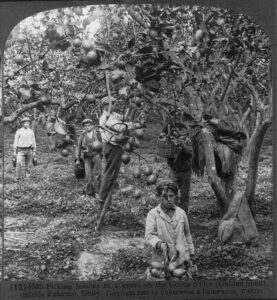
Sicilians Picking Lemons in a Grove Outside of Palermo, Sicily, at the End of the 19th Century
The boom in Sicilian immigration, I learned, was a result of the citrus trade, the transatlantic commerce in lemons and oranges. As early as the 1830s, the fruits were unloaded on the New Orleans levee across from the Mississippi River. Citrus, a much coveted commodity, was arriving in ships from the Sicilian ports of Palermo and Messina. Lemons bought and consumed in America before 1900, historian Justin A. Nystrom points out, were likely not grown in California but to have “come from Sicily and that a prosperous Sicilian immigrant had had something to do with it.”
I was familiar with the outlines of the trade from my earlier research. Nystrom’s book, Creole Italian, filled in its absorbing details. Nystrom tells the hidden story of the Sicilian passage to New Orleans. It was the pursuit of simple citrus fruit—not a quest for something grander, like riches, spices, or glory—that bound the Crescent City and Sicily together. The lemon not only propelled the trade but also the waves of Sicilian immigrants who settled in the port city.
The lemon was the “ideal trading perishable commodity,” historian Nystrom points out. The fruit could be picked while green and gradually ripen without spoiling on the long ocean voyage. Demand for the lemon in America was also strong. Countless recipes required lemon juice. Citrate, or citric acid, manufactured from the fruit, was indispensable to the canning process until a synthetic substitute was devised.
Anglo-American auction houses, Nystrom points out, controlled the early citrus business in New Orleans. It was not long, however, before savvy Sicilian merchants, capitalizing on their ties to the source of the fruit, began unseating the established traders.
After the Civil War, large cargoes of citrus were arriving in New Orleans, Nystrom notes. A load of fruit—6,855 boxes of lemons and 13,727 boxes of oranges—filled the ship Bessarabia, which docked in 1882. The Sicilian connection to the goods was obvious in the names of the commission merchants—Le Secco, Trapani, Randazzo—who ordered them. One Sicilian magnate, Angelo Cusimano, took the lion’s share of the fruit. Cusimano, who was also in the pasta business, purchased 5,849 boxes of lemons, 94 boxes of oranges, and 102 boxes of macaroni.
Other merchants concentrated on the retail side of the business. An 1860 ad for a grocery run by R. Tramontana, uncovered by Nystrom, advertised his stock. He was selling “creole oranges,” bananas, pineapples, along with other nuts and fruits.
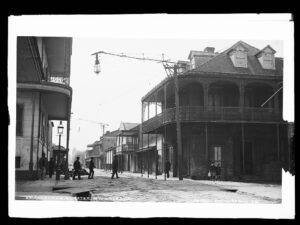
The New Orleans French Quarter at the End of the 19th Century
By 1890, the Sicilians had finally pushed aside the older merchant families in the trade. The ethnics now held sway over the importing, wholesaling, and retailing of the business. Profitable opportunities abounded. Peddlers selling fruit often moved to higher rungs on the ladder.
An Italian colony sprang up in New Orleans. Ships carried fruit, and sometimes passengers eager to make their way into the citrus business. Like the Uddo family, Sicilians clustered in an area near today’s French Market. In “little Palermo,” Italian purveyors were increasingly selling their wares at its stalls. “A riot of smells,” writer Richard Gambino observed, the market was fragrant with “musty vegetables, pungent fruits, sweet flowers.” The citrus trade put New Orleans on the map for Sicilians eager to strike out on their own. Ships loaded with fruit often carried passengers who wanted to try their luck in the burgeoning industry. Many of the Sicilians getting off the S.S. Utopia, scholar Jean Ann Scarpaci points out, toted small containers of lemons.
The ambition of the Sicilians stirred resentment among fearful locals. Joseph Shakespeare, the New Orleans mayor, castigated the immigrants in June of 1891: “They monopolize the fruit, oyster and fish trades and are nearly all peddlers, tinkers or cobblers…. They are filthy in their persons and homes and our epidemics nearly always break out in their quarter. They are without courage, honor, truth, pride, religion or any quality that goes to make a good citizen.”
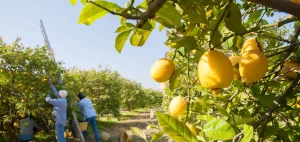
Lemons Growing on a Tree in Sicily
America’s partner in the citrus trade, Sicily, had been building a thriving lemon industry. Not native to Sicily, the lemon had actually begun its journey in the foothills of the Himalayas, where the trees grew, as one authority put it, “under the sheltering umbrellas of bigger trees.” The lemon was probably first cultivated in India. In the 9th century A.D., the Arabs on their imperial march colonized Sicily. They transplanted lemons and other crops like eggplant, spinach, and sugarcane to their possessions. The terrain in Sicily was hostile to a fruit that flourished in hot, steamy, and rainy conditions. Undaunted, ingenious Arab farmers set out to turn the arid land into a veritable oasis.
An intricate system of irrigation, based on aqueducts, ditches, and canals, channeled an abundant supply of water year-round for the soil. Author Helena Attlee describes the remarkable transformation of the land around the city of Palermo, the capital of the Arabs’ Italian colony, through the eyes of a Muslim traveler, John Hawqal, a Baghdad merchant. Spellbound, “he was moved by … the streams descending from the mountains to east and west, the water wheels lining their banks, and the land to either side of them planted with fruit trees, sugar cane, papyrus, and pumpkins.”
The lemon’s commercial breakthrough was hastened by the discovery of an English naval officer, James Lind. In a Treatise on the Scurvy, published in 1753, he argued that lemons were a cure for the illness, “the most effectual remedy for this distemper.” Fifty years later, the British navy required sailors to take an ounce of lemon juice sweetened with an ounce of sugar every day after two weeks at sea. Lord Nelson championed Sicily as a citrus source. “Some people remark,” Attlee notes, “that Nelson had transformed Sicily into a vast lemon juice factory.”
A contract to provide lemons to the British navy followed. Growers soon cast their eyes on America as a market for their produce. By 1857, over 19 million kilos of fruit, Attlee says, were shipped from Sicilian shores. In 1860, the wealth created by citrus farming in Sicily made it the most profitable agricultural business in Europe.
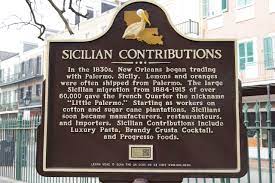
Marker Celebrating the Sicilian Contribution to New Orleans
Tempted by the riches to be gained, farmers with more modest wealth started investing in a crop that had once been largely the domain of aristocrats. Speculators spotted easy opportunities to take advantage of unwary citrus growers. Mafiosi organized a protection racket to rob growers worried by the costs of their risky endeavor. Gangsters offered to help, supplying water and erecting water pumps. For those who feared for the safety of their valuable crops, the crime lords provided guards. Of course, there was always a price to be paid.
Failure to pay pizzo, the protection money, was risky and sometimes fatal. Offenders were met with violence. It was “exercised openly, calmly, regularly and as part of the normal course of events,” according to an 1876 report cited by Attlee. The curtain of citrus barely concealed places where savagery prevailed. A visitor “will see the place where a garden owner who wanted to follow his own plans for renting out his lemon groves felt a bullet passing just above his head by way of friendly warning.” The report said “the perfume of orange and lemon blossom begins to smell like corpses.”
Shipping fruit across the Atlantic was expensive. Steam-powered shipping in the late 19th and early 20th centuries came to the industry’s rescue. Speedier, more fuel-efficient “lemon boats” now carried heftier cargoes. “The most valuable fruit,” Attlee points out, “was carefully arranged in wooden “American-style boxes and wrapped in colored tissue paper.” The citrus cargo between Sicily and the U.S. soared to new heights. Between 1892 and 1894, Nystrom notes, 400,000 boxes of citrus fruit were unloaded in New Orleans.
Many of the ships were now carrying fruit as well as large numbers of Italian immigrants bound for labor in the sugar cane fields outside New Orleans. Pliant hands, the peasants were replacing a recalcitrant black work force. Their work was back-breaking toil, cutting cane with their machetes during the day and, at night, grinding, boiling, and refining their product. Unlike earlier immigrants, many of whom were prominenti, notables and men of means, these recruits were typically downtrodden commoners. According to a press account, one shipload arriving in 1896 was “laden with 34,000 boxes of lemons and 600 tons of sulphur with a supplemental immigrant cargo of 121 souls.” The labor bosses, the padrones, who corralled the workers, were often one time fruit traders with close ties to the island.
Shipping companies synchronized their schedules with the sugar cane season in Louisiana. Boats left Sicilian ports just in time for them to unload passengers in early October for the zuccarata, the sugar harvest, which ran from October to January, the “immigrant season.” The citrus trade, Nystrom concludes, paved the way for the massive immigration of Sicilians: “The Sicily lemon, not only brought the original Sicilians to New Orleans but established the trade routes that nearly all of their subsequent countrymen followed.”
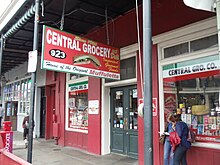
New Orleans’ Central Grocery Store, Known for Its Muffuletta Sandwich
The citrus bonanza would not last forever. Initially, there was no contest between the Sicilian lemon and the lemon grown in California. Vendors in a San Diego market in 1888, Nystrom notes, were almost uniformly dismissive of the American product. “The Sicily lemon is good, the California lemon is good—for nothing,” they told one observer. American growers did not surrender. They battled their Mediterranean rivals for supremacy in the market. A tough levy on imported lemons, the industry calculated, would knock the greedy Sicilians off their pedestal. The journal of the American Tariff League, Nystrom points out, sneered at the “competition.” “Among all the importers none are more persistent and vicious in their assaults on American industry than the firms, nearly all with Italian names, which are engaged in importing Sicily lemons.” By 1937, a crippling tariff on imported lemons achieved its objective. The California lemon had toppled the Sicilian.
The loss of the citrus business did not hinder the Sicilians. Businessmen, many of whom had prospered in the fruit trade, threw themselves into a new field, marketing tropical fruit from Central America. Two families, the Vaccaros and the D’Antonis led the way. They banded together, first opening a small general store in Baton Rouge and then, after a flood in 1897 destroyed it, embarking on a new venture. They transported oranges, picked down river, in luggers, small boats, to New Orleans, for sale at the French Market. The clans again suffered another misfortune. A ferocious winter storm devastated the orange trees on which the business depended.
They decided to change course. “If we are to achieve our ambitions in life, there is not much left for us here,” Joseph Vaccaro said to his son-in-law, Salvador D’Antoni. “I understand that there are coconuts and bananas in Honduras.”
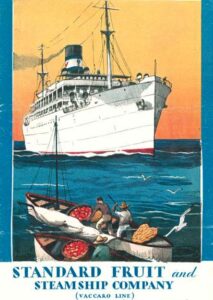
Poster for the Standard Fruit Company
After some early forays to Honduras, they brought back coconuts, small loads of oranges, but only a few parcels of bananas. They soon got luckier, using steamboats to transport the more lucrative product, often carrying more than 200,000 banana stems a trip. The company rapidly captured the Honduras market. The enterprise expanded, acquiring and building its own railroad line, from the port to the fruit groves. The import trade took off. The small firm grew into a shipping colossus that became the Standard Fruit and Steamship Company in 1923.
The New Orleans elite, perhaps reluctantly, praised Standard’s success. The company helped make New Orleans the world’s largest importer of fruit in the early twentieth century. Over 600 notables gathered at the Roosevelt Hotel in New Orleans on October 5, 1925, to salute Standard’s contributions to the economy. St. Clair Adams, the president of the Louisiana Bar Association, lauded the owners for lifting New Orleans “out of the mud,” and transforming it into a “beehive of useful activity.” Once considered disreputable, Sicilians were at last given their due.
Notes
Justin A. Nystrom’s book, Creole Italian, was a treasure house of illuminating details about the New Orleans-Sicily connection. Helena Attlee recounts an absorbing history of the lemon, which is especially informative about the development of the fruit crop in Sicily. Jean Ann Scarpaci’s dissertation, Italian Immigrants in Louisiana’s Sugar Parishes, is a pioneering study of the ethnic labor force. My own book, The World on a Plate, tells the story of Progresso and examines the development of the Italian colony in New Orleans.
The Truth about Finocchio: The Wonders of Fennel

A field of fennel
A small plane, something like a crop duster, landed in a southern New Jersey field on a culinary mission. In 1975, New York Times food critic, Craig Claiborne, had decided to observe firsthand a plant that he had grown increasingly curious about. The writer had come to a farm owned by the Formisano family, whose four generations have been growing fennel since 1908. Gazing at the bountiful fields of this unique vegetable, prized by Italians and now gradually being discovered by inquisitive non-ethnics, Claiborne was captivated. The crop, he wrote in an article for the Times, was “caressed by a late autumn wind.” It “resembled a vast and undulating sea of green feathers.”
Claiborne watched intently as the workmen harvested the plant. “Ten workmen … are equipped with constantly sharpened carbon steel knives called cabbage knives. The fennel is lifted from the soil and, with one quick swoop of the knife to the underside of the plant, … the fennel is ready to be crated and labeled.” The family treated the visitor to a dish of sea bass baked in fennel. Claiborne relished the plate. He dubbed Ralph Formisano, the senior member of the family, the “fennel king.” The Times writer recounted his visit in the newspaper and his 1976 book, Claiborne’s Favorites. The Claiborne story paid dividends. “That put us on the map,” Ralph Formisano, the senior member of the family, told journalist Eileen Stilwell. (More on the Formisanos later.)
Claiborne had wanted to write about fennel after noticing how few Americans were acquainted with it. Writing in 1961, he spotted a customer mystified by an unusual item in a grocery’s vegetable counter:
It had a solid root end and its leaves were somewhat feathery. Timorously she asked a near-by clerk what it was and he answered “Fennel.” “How do you eat it?” she asked. “Raw.” It is regrettable that so few of the city’s inhabitants know of the vegetable and even fewer know its virtues.

A fennel bulb with stalks and fronds untrimmed.
The variety of the fennel plant the Formisanos grow was first cultivated in Florence, Italy in the 17th Century. Florence fennel, the type most shoppers are familiar with, is distinguished by feathery fronds that spill out from its celery-like stalks and by the buxom bulb at its base. This feature makes it look like “pregnant celery,” as writer Maggie Stuckey describes it.
A versatile ingredient, fennel lends itself to a variety of tasty dishes. It goes particularly well with fish, as Claiborne discovered. It can be braised, steamed, or grilled. Paired with olives and oranges, and dressed with olive oil, fennel makes a piquant salad. Laced with fennel seeds, sausages and salamis are invigorated.

Fennel flowering.
Native to the Mediterranean, fennel, like carrot’s ancestor Queen Anne’s Lace, grows wild in meadows and country roads. A cluster of brilliant yellow flowers, which yield aromatic seeds, form a parasol, or umbel, over the plant. Fennel shares this umbrella with other members of the umbelliferae family, like coriander, dill, and anise. Fennel, like some of its relatives, is infused with anethiole, an oil that produces a licorice-like fragrance.
Of ancient lineage, the plant was dear to the Greeks and Romans. Its name derives from the Latin foeniculum, or fresh hay, probably because of fennel’s lively scent. The Romans delighted in young shoots marinated in brine and vinegar. Fennel seeds were sprinkled in cakes and bread. Its licorice flavor, the Roman naturalist Pliny points out, was excellent for “seasoning a great many dishes.”
In the ancient world, the fragrant plant was more than a valued spice. Fennel, it was felt, made you lean and fit. The Greek name for the plant, marathon, has its roots in the word, maraino, to “grow thin.” Marathon, the location of the celebrated battle between the Greeks and Persians, food scholar Raymond Sokolov explains, got its name from the plant, which covered its fields.

Fennel plants.
Fennel was reputed to help soothe the stomach. Eating a stalk of fennel, Socrates recommended, could alleviate the upset. In India, fennel seeds were prized for similar reasons. After eating, many Indians today chew the seeds to settle their insides.
Fennel, it was claimed, was also especially helpful for the eyes. It sharpened eyesight and cured blindness, Pliny wrote. Snakes, he observed, rubbed up against the plant after shedding their skin. They were trying, he surmised, to regain their sight by getting the plant’s juice in their eyes.
In later years, medical commentators echoed Greek and Roman lore. “Both the seeds, roots, and leaves of our Garden fennel are much useful in drinks and broth for those who have grown fat,” the 17th Century English naturalist, William Cole, wrote.
In a similar vein, 17th Century English gastronomer John Evelyn urged his readers to eat the vegetable peeled like celery. The benefits: it “expels wind, sharpens the sight, and recreates the brain.”
The modern pairing of fennel with fish has earlier antecedents. Europeans, herbal scholar Maude Grieve observed, enjoyed it as a “condiment to accompany salt fish during Lent.” Botanist John Parkinson praised fennel’s gifts to both “meal and medicine.” It “helpeth to digest the crude quality of fish and other viscous meats.”
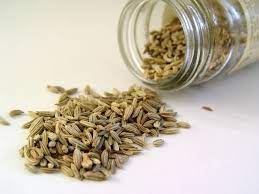
Fennel seeds.
Chewing fennel seeds also alleviated hunger, according to other authorities. A godsend to the poor, English garden historian Alicia Amherst pointed out, the destitute considered fennel as “a relish to unpalatable food.” In North America, Puritans turned to “meeting seeds,” dill and fennel, to endure long sermons and aching stomachs at church.
In Italy, the name for the plant, finocchio, recalled the ancients’ trust in its vision improving qualities. Food historian Raymond Sokolov offers a translation of the word. It is a “contraction” for “dainty eye.” The word, he says, gradually became Italian slang for “homosexual.” Trading on the slang term, a late night club in San Francisco’s North Beach, famous for its female impersonators, called itself Finocchios.
Finocchio was linked to flattery and dissembling. The expression, “dare finocchio,” means to “give fennel” or flatter.
In Shakespeare’s England, fennel took on a similar allusion. In playwright Ben Johnson’s play, The Case Altered, Christopher and the Count have this exchange:
Christopher: No, my good lord.
Count: Your good lord! Oh! How this smells of fennel!
The Italians grew increasingly passionate about this fragrant vegetable. Giacomo Castelvetro, the 17th Century culinary writer, spoke of the verve it brought to social gatherings:
We preserve quantities of fresh fennel in good white wine vinegar and eat in summer and in winter when offering drinks to friends between meals. We also serve this pickle with fruit in special occasions, when fresh fennel is not to be had.
Fennel’s fame spread throughout the English-speaking world. In the U.S., the poet Henry Wadsworth Longfellow wrote rapturously about it:
Above the lowly plants it towers,
The fennel, with its yellow flowers,
And in an earlier age than ours
Was gifted with the wondrous powers
Lost vision to restore.
It gave new strength, and fearless mood.
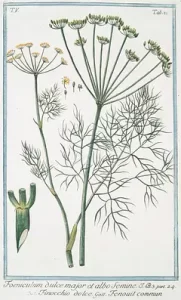
18th Century illustration of sweet fennel.
In America, Jefferson was an early admirer of the plant. Thomas Appleton, an American consul in Naples, Italy, sent the Virginia planter some fennel seeds in 1834. Thomas Jefferson wrote a lyrical letter in response:
[The] fennel is, beyond every other vegetable, delicious. It greatly resembles in appearance the largest size celery, perfectly white, and there is no vegetable that equals it in flavor. It is eaten at dessert, crude (raw), and with or without, dry salt. Indeed, I preferred it to every other vegetable or to any fruit.
Still, for many years, fennel was unknown to most Americans. If recognized at all, it was regarded as an ethnic vegetable, the province of Italians. Before it graced sophisticated dining tables, it was grown by Italian immigrant farmers. In the early 1900s, Giovanni Formisano, one such pioneer, left his village near Naples, where his family grew the plant. Arriving in New York City, he landed a job on the railroad. He labored long hours for a dollar a day, his grandson John Formisano, Sr. recalls. Tiring of the toil, he searched for more fulfilling work. Pursuing his love for tilling the soil, he was a hired hand for several New Jersey farmers. By 1908, he had saved enough from his meager earnings to buy his own piece of land in Carlstadt, a North Jersey town.

Label for Formisano Farms.
Drawing on childhood memories of his homeland, Giovanni started cultivating Swiss chard, romaine lettuce, celery, and, of course, fennel, to name a few of his crops. He brought his goods to sell at the 14th Street market in Manhattan. As John tells it, Giovanni drove his horse and wagon to Hoboken, New Jersey, where he took the ferry to the city. The wagon was loaded with barrels of cabbage and flats of fennel stacked three feet high, crammed in with other vegetables. His prime customers were small, ethnic vendors who arrived at the market with their pushcarts. Each group had its own preferences—Germans for cabbage, Italians for escarole, dandelions, endives, and fennel. Some shoppers came home with bushelfuls of plum tomatoes. After an exhausting day, John says, Giovanni would take the ferry back and quickly fall asleep in his wagon, trusting his horse to get him home. Over time, Giovanni sold his wares at markets in Newark, Paterson, and other cities.
As his business prospered, the budding farmer could afford new vehicles. A tractor replaced the horse and wagon. In the late ’twenties, he bought a Mack truck and a Model T. His repertoire expanded. During the ’twenties, John points out, he started selling basil for a quarter a bunch. The plant, loved by Italians, came in one pound coffee cans.

A trimmed bulb of fennel.
Formisano’s, which moved first to Moonachie in North Jersey and then to its present location in Buena, a South Jersey town, is in the heartland of Italian farmers. Early settlers from southern Italy got their start as strawberry or raspberry pickers or as railroad workers in the late 19th Century. Many immigrants also took jobs as farm laborers. Whatever route they took, their goal was to save enough to own their own land. They were not stymied by the sandy soil of the Pinelands region of South Jersey. As older farmers retired, Italians replaced them. Two substantial colonies of the immigrants sprang up, one in Vineland, the other in Hammonton, two towns not far from the Formisano farm.
Emily Meade, a sociologist and mother of anthropologist Margaret Mead, visited Hammonton in 1907 and marveled at the novel produce the farmers were harvesting: “Italians have popularized the sweet pepper and introduced … a peculiarly shaped squash, okra, Italian greens and various kinds of mint.” Hammonton often claims to be the “most Italian” community in the U.S. (Emily Meade’s name is often spelled this way in publications, but in other instances it is spelled Mead.)
Most of the farmers in the area are still of Italian heritage. The people in Vineland keep their culture alive with an annual Spring festival featuring a Dandelion dinner where an array of foods and drinks made from the plant are enjoyed. The menu might include a salad with dandelion greens, dandelion ravioli, and ice cream with dandelion brandy. The town, where dandelion wine is a not uncommon refreshment, calls itself the “Dandelion Capital of the World.”

John Formisano with fennel ready to go to market.
Formisano Farms, one of the oldest in the area, has burgeoned into a full-scale enterprise purveying a wide variety of produce. Food brokers and wholesalers, supermarket chains, and gourmet shops snap up their wares. “We don’t have to knock on doors anymore. We’ve got enough business,” John Formisano, Sr. who grew up chopping celery in the fields, told reporter Stilwell.
Formisano’s, Richard Vanvranken, the Rutgers University agricultural extension director for Atlantic County, observes, is a groundbreaking enterprise, “introducing specialty herbs and fresh market herbs to the Vineland region of South Jersey.” “When the Formisanos arrived, production in the region was mostly of summer/fall staples like peppers, tomatoes, sweet corn and sweet potatoes. Spring and fall greens opened new markets and extended the production season for the region’s small farmers.”
Formisano’s accommodates both older generation ethnics and customers with more contemporary tastes. To please stalwart Italians, the farm offers them escarole, dandelions, and endives. Some of these buyers ask for finocchio, not fennel.
Always alert to culinary trends, “they like to try anything new and different to open new markets,” Vanvranken points out. Parsley, he adds, was a “multi-million dollar crop when I arrived forty years ago … but by the late ‘80s, cilantro, that no one had a clue about, was being grown just as much.” Cilantro joined basil and arugula as a Formisano staple.
Their renowned fennel crop has its peak season during the fall. The greatest demand is from September through Thanksgiving and sometimes, if it isn’t too cold, till Christmas. During this period, the tempo at the farm is especially brisk. That is “when it moves,” John Formisano, Sr. says.

Assorted Formisano produce.
Never complacent, the partners are keenly attuned to the changing tastes new immigrants are bringing to the marketplace. Indian shopkeepers who first came looking for eggplant began seeking more unusual plants. Fenugreek, or methi, was at the top of the list for the “Indian people,” John notes. The herb, used in a variety of ways in the country’s regional cuisines, is especially treasured for its leaf. When harvested, John points out, fenugreek should only be picked when it “sports a nice green leaf.”
The Formisanos rode the wave of fennel’s rising popularity. Once considered exotic or simply as an Italian delicacy, it now has cachet. Upmarket hotels and restaurants are enlivening their menus with fennel dishes. The Atlantic City Borgata Hotel, 30 miles away, began ordering fennel and other unique items like candy-striped beets and Sicilian oregano from them. The Borgata’s dining room created a fennel tempura, sprinkled with lime juice and sea salt.
However, there is still more marketing to be done. The uninitiated sometimes confuse fennel with anise, which has a somewhat similar taste. To prevent confusion, the Formisanos label some cartons of fennel as “anise.”
Fennel is savored in the Formisano household. John, Sr.’s wife Mary often makes a carrot and fennel soup. More than anything, John enjoys the simple pleasure of a snack Italians call pentimento. He nibbles slices of fennel cut from the bulb, dipped in olive oil. It’s something to relish, he says, “while watching a ballgame.”
Acknowledgments
Anita Formisano, who runs the Formisano office, was very helpful. I am grateful to John Formisano, Sr. for taking time away from his labors to talk with me. Thanks to Richard Vanvranken, the Rutgers Agricultural Extension Director for Atlantic County for facilitating my introduction to Mr. Formisano and for sharing with me his insights and observations about farming in the Garden State.
Feeding a Boom Town: Greek Immigrants in Birmingham, Alabama

The Peloponnesian peninsula, in red, at the south of Greece
A young man from a small village in Greece’s rugged Peloponnesian peninsula set out on a journey in 1902. The 14-year-old Tom Bonduris was on a trek to improve his fortunes. Opportunities were few in Peleta, a mountainous community that sat on a plateau 2300 feet above sea level. “A farming village of traditional stone houses,” writer Niki Sepsas pictures it, it was “dotted with stately fir and cedar trees…. The pastoral setting was peaceful and idyllic.” For all its beauty, Peleta was a place where farmers labored to eke out a living from the soil. Farmers milled grain with the help of their horses and donkeys. Many owned goats and sheep. Wild greens were dried and saved to be consumed during the winter.
When Sam Bonduris, Tom’s nephew, visited Peleta many years later, he was struck by the harshness of the place. This village, once part of the Ottoman Empire, was “impoverished.” In 1971, Sam said, Peleta was still without electricity.

The village of Peleta, Greece
Peleta was blessed with a tight-knit family network. It was almost “tribal,” Sam observed. Tom Bonduris relied on these kinship ties during his journey. In New York City, Tom’s destination, the helping hand of a family member eased his arrival.
Tom got off the boat at Ellis Island and soon joined an uncle, Peter T. Bonduris, who ran a fruit stand in Manhattan. Peter had left Peleta in 1895 and took up a business that was a foothold for many early Greek immigrants. Peter put Tom to work. Part of the job’s appeal was that it required little English. John N. Bonduris, Tom’s first cousin, whom Peter took under his wing a few years later, discovered that hawking fruit demanded just a few words. He was taught to give the same answer to every customer’s question. His stock response, Sam says, was “I don’t know and 10 cents a bunch.”
After two years of learning the ropes at the fruit stand, Tom went home to Greece after catching pneumonia. Returning to America in 1906, he disembarked in Savannah, Georgia. He left there for Birmingham, Alabama for reasons that are somewhat murky. But, as Sam Bonduris guesses, his uncle had probably heard through the family grapevine that Birmingham was “booming” and that some Greeks, possibly relatives, had already settled there. That was enough enticement.
Tom’s journey took an intriguing twist. He began baking pies at a Greek-owned restaurant in Birmingham. A year later, Tom would found the Bright Star Café, now a 100-year-old establishment and the longest continuous restaurant in Alabama. The Bright Star is a monument, a testament to the achievement of Greek immigrants in building a flourishing food industry in the Birmingham area. (More about Tom later.)
Birmingham might seem an unlikely place for Greek immigrants to settle. Bonduris had actually arrived in a city where a Greek colony was already springing up. The deep South town was a community, no longer slumbering, but one energized by a budding industrialism that was attracting newcomers. In 1900, historian of Birmingham’s Greek immigrants Niki Sepsas notes, there were already 100 Hellenic pioneers. In ten years, the number would rise to 500.
In his book, Hellenic Heartbeat in the Deep South, Sepsas points to George Cassimus, a Greek seaman, as the first arrival. Cassimus had been working for the British navy running guns for the Confederacy out of the Alabama port of Mobile. After the war, George began looking for new pursuits. He moved to Birmingham in 1884, where he “found a brash young boomtown barely thirteen years old that was developing around what had just been a mud-spattered railroad crossing,” Sepsas writes.
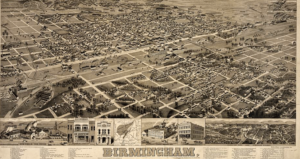
Birmingham, Alabama in 1885
Birmingham, named for England’s industrial powerhouse, was in the midst of a radical transformation, Sepsas says. “By the early 1870s … glowing blast furnaces had begun lighting the night sky, and coal and iron mines were offering employment to hundreds of former plantation workers and immigrants from other states and many foreign countries.”
Cassimus took a job with the city’s fire department. He put aside enough money to start a short-order eatery. Details about the business are thin, although the enterprise was known as a “fish eating place.”
Greek immigration to Birmingham was part of a larger stream of voyagers uprooted by economic hard times and propelled by the limited opportunities of their villages. Many were single men from farming families, often from the Peloponnesus. Initially, they envisioned their journey as a short-term sojourn, only long enough to accumulate a nest egg to bring home.
Some were motivated to earn money to fulfill family obligations. One such immigrant was Triantaffillos Balabanos, who left his village of Tsitalia in the early 1900s. He booked passage on the steamship Athinai, which was bound for New York from the Greek port of Piraeus. After a 13-day trip, he disembarked on September 29, 1909. He was not greeted with a welcome mat. According to writer Philip Ratliff, officials required him to swear that he could read, did not practice polygamy, and was not an anarchist. He listed his destination as the Reliance Hotel in Birmingham, one of whose owners was a kinsman, T. N. Balabanos.
Triantaffillos was on a mission. He wanted to work long enough to pay for a dowry for each of his five daughters. He returned home five times with the funds to meet his goal. He made money in restaurant jobs and at his relative’s hotel.
Triantaffillos, who went home in 1939 and never returned, left a legacy. George Sarris, a Birmingham food titan who founded the Fish Market food business, was his great grandson. Generations of Greeks in the restaurant industry carried the Sarris name.
“You weren’t here to change
the culture of America. You
were here to make a living.”
Every immigrant group in Birmingham followed a different path. The Italians captured the grocery business while the Jews, writer Sepsas observes, gravitated to “mercantile” occupations, like dry goods. In the early days, the Greeks ran a host of enterprises, lunchrooms, soda fountains, candy shops, meat markets.
Greeks shared a disdain for the factory jobs that abounded in the “Pittsburgh of the South.” Although some signed on as hired hands in factories, they were reluctant recruits. “You’re not going to work in steel mills or mines” over the long term, Sepsas, who himself had worked in several Greek hot dog businesses, observes. The Greeks dreamed of economic independence, of self-employment.
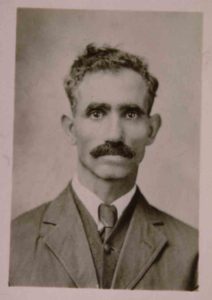
Greek immigrant and factory worker Constantinos Sfakianos
Industrial labor was not only grueling but dangerous. Constantinos Nicholas Sfakianos suffered through a perilous job. In 1907, the immigrant joined ten other countrymen at a steel plant in Ensley, a community in greater Birmingham. In an interview with a Birmingham research group, he recounted his ordeal:
“I stayed on that job fifty-three years, painting smoke stacks. There were no lights to work by so we burned wood for light for ten or fifteen years.
“I lost my hand in that plant in 1941. A crane in the blast furnace crossed my hand. Cut part of it right off. After six months, I went back to work. The company, the big boss liked me. He knew me because I worked there all my life.” (Source hereafter referred to as Patrida.)
Fruit vending was an early launching pad for the settlers. It was a good fit. Little English was required. Moreover, Sepsas points out, the immigrants had worked on farms back home and possessed a “pretty good knowledge of fruits and vegetables.” Sofia Petrou, a scholar who studied Birmingham’s Greek colony, suggests another inducement:
“The majority of the early Greek immigrants in Birmingham found a lucrative business in sidewalk fruit stands …. This type of small business allowed the Greek immigrant to assert the economic independence that had eluded him in Greece. All he needed was a small capital investment, usually acquired from his former homeland, and knowledge of the product he was selling.”
The immigrants’ commercial instincts served them well. In 1902, the Birmingham newspaper, The Herald, reported that the Greeks had acquired a monopoly of the fruit business. Christine Grammas describes one such operation run by her father, Sam Derzis:
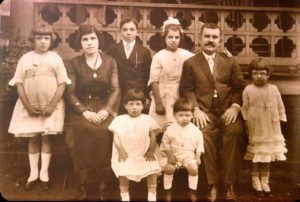
Sam Derzis and his family
“My daddy’s stand didn’t have a front door. It had counters with fruit stacked up just as pretty as you could see and then in the back he had an ice box where he would slice the watermelons and sell them by the slice. On one side he had candy counters where he sold Hershey bars, peanut brittle, and coconut crisp—and there was a cigar counter.” (Patrida)
Vending fruit might lead to more profitable ventures. Alex Kontos, who arrived in Birmingham in 1889, started out selling fruit from his horse and wagon. Later, he teamed up with a Mobile, Alabama wholesaler to market bananas, which were being shipped to the port. He introduced the then-strange, exotic fruit to Birmingham. Transporting bananas in box cars to the city, the “Banana King” soon controlled the sales of the fruit. Kontos later parlayed his enterprise into a full produce wholesale business.
The fruit dealers’ success bred resentment in the city’s business establishment. The vendors posed a public health threat, some claimed. One vehement opponent of the ethnic trade compared the Greeks to “Chinamen.” “They do not build up a town but send their earnings to the old country.” His tirade continued: “Which should we encourage, our home merchants … or these foreigners? It is a case of choosing between John Smith and Harry Williams or Demosthenes, Thucydides and Aristotle.” (Patrida) The Greek merchants won the fight. In a vote of 13-4, the city council permitted the vendors to continue their sidewalk trade.
The restaurant business, as it did in small towns and cities across America, exerted a strong attraction for Birmingham’s Greeks. It was their niche of choice. The savvy entrepreneurs spotted a gap in the market and decided to move quickly to fill it. The growing urban population hungered for inexpensive, quick, and filling fare. “Those industrial workers, many of whom arrived without spouses or children, clamored to wolf down lunch break sandwiches from portable canteens, to dine in cafés, to drink and carouse in taverns,” Southern food historian John T. Edge explains. The bold immigrants ventured into a field where old-line merchants were hesitant to tread.
In the process, the Greeks built a moderately priced food industry, one which had not previously existed. The culinary transformation of Birmingham was stunning. In 1912, a traveling salesman, Sepsas notes, heaped praise on the immigrants’ contribution: “The Greek-owned restaurant relieved a well-nigh intolerable gastronomical situation.”
Over the years, the Greeks in Birmingham plunged into a wide variety of pursuits. The hot dog business was an early favorite. In 1919, Tom Kandilas opened what was reputed to be the first or one of the earliest hot dog stands. Tom, who had previously worked in the fruit and vegetable trade, promoted the “Birmingham dog.” Tom’s Coneys, his shop, sold a “hot beef” frank, similar to the one that Greek vendors hawked in many locales across the country. It was spicy and was topped with mustard, onions, and sauerkraut. The piece de resistance of the dog was the “special sauce,” whose secret ingredients Greek merchants guarded zealously. It was probably flavored with cinnamon, allspice, and other tangy Greek spices.
The stories of colorful ethnic vendors became part of Birmingham lore. Emily Brown, a local food writer, relates one such tale about Kandilas. As his granddaughter, Tasia, tells it, Tom kept a half pint of liquor next to his cash register. For special customers, he might pour a bit into their coke bottles.
The roster of hot dog peddlers in Birmingham included such names as Pasisis, Koutroulakis, Graphos, and Gerontakis. “Forty years ago, hot dog merchant Lee Pantazis told writer Bob Carlton, “you couldn’t throw a stone without hitting a Greek hot dog stand, whether it was a little restaurant like this or a cart on the side of the road.”
The business was well suited for early Greek immigrants. “You have to remember,” Birmingham restaurateur George C. Sarris told an interviewer, “when [the Greek immigrants] first came here, they had no language, no nothing. Hot dogs were easy. There was little cooking. A hot dog and a sauce, that’s pretty much it.”
Other innovators branched into a great variety of enterprises. During the decades, Greeks launched barbecue, “meat and three” (more about that later), and even white tablecloth dining rooms. Blanketing the city with their eateries, Greeks came to dominate Birmingham’s food business. “We laugh and say, if it hadn’t been for the Greeks in the ’60s and ’70s, the people of Birmingham would have starved,” Tim Hontzas, owner of Johnny’s restaurant, told correspondent Bryan Roof.
The restaurant owners had a keen feel for the tastes of their customers. In the beginning, they played down their heritage and instead offered familiar, inoffensive dishes. “You didn’t see Greek people serving spanakopita and tiropita and keftedes and this and that,” Hontzas explained to journalist Georgia Clarke. “They served barbecue and they served hot dogs and they served meat and three—Southern cuisine.”
On the road to success, the Greek restaurant journey could sometimes be a rocky one. Birmingham natives might cast a suspicious look or toss an epithet at the “aliens.” Some might sneer at the “dagoes,” an offensive term usually applied to Italians. “Greeks were sometimes asked to sit in the black sections of restaurant establishments and were discouraged from housing in certain parts of Birmingham,” historian Petrou points out.
Greeks often modified or changed their names to appear less conspicuous. Writer Sepsas tells the story of a Greek immigrant, Chris Mitchell, who felt impelled to do this: “My father, Nicholas Mitchinikos, came to America in 1898 and settled in Birmingham. He was twelve years old at the time. A man took him to find work. ‘No speak English,’ my father said. The employer asked him his name and he answered ‘Mitchinikos.’ ‘Too hard,’ the man replied. ‘Let’s make it Mitchell.’ That became the family name.”
The xenophobic climate strengthened the already powerful determination of these immigrants to earn acceptance and recognition. For restaurant owners, the food business became a pathway to belonging and moving up in a foreign land.
For Greeks with an entrepreneurial drive, there was also plenty of fertile soil to plough near Birmingham. After a year in Birmingham, the pioneering Greek immigrant Tom Bonduris was restless. Eager to work for himself, he struck out for Bessemer, a town 15 miles west of Birmingham. The boom town was the brainchild of Henry Fairchild DeBardeleben, a go-getter born on a cotton farm, who had tried his hand as a teamster boss, a lumberyard foreman, and in other occupations. With two partners, he began laying plans to create a city that would take advantage of the region’s rich veins of coal, iron ore, and limestone.
The visionary imagined a city built around eight blast furnaces and fed by eight railway lines. He laid out his boundless dream, Sepsis notes, to the Birmingham Age journal in 1886: “We are going to build a city solid from the bottom and establish it on a rock financial basis. No stockholder will be allowed in who can’t make smoke. It will take $100,000 to come in and the man who can make the most smoke can have the most stock.”
A year later DeBardeleben’s dreams were realized. Originally called Brooklyn, the city’s name was aptly changed to Bessemer, after the British inventor of the process of transforming molten iron into steel. The Bessemer technique, a boon to the city’s industry, made steel production more efficient and less costly. Before long, Bessemer would burgeon, rising to become the state’s fourth largest city by 1890. The city now throbbed with blast furnaces, iron works, and steel mills.
For a young man with his eye on the main chance like Tom Bonduris, Bessemer offered alluring possibilities. The teeming city was drawing miners, mill workers, and office employees, all potential customers for a lunchroom. Several trains roared through the city each day, bursting with miners, sometimes hanging on the side.

The Bright Star’s neon sign
Tom opened the Bright Star Café in 1907. A neon sign, star-shaped, with the business’s name proclaimed the young man’s aspirations. Tom must have been thrilled about this venture. “He came to this country as a young thing. He worked as a waiter,” future Bright Star owner Jimmy Koikos told Amy Evans from the Southern Foodways Alliance (hereafter as SFA). “And he heard about Bessemer being the young, mining, progressive town, so he came here and … opened up the Bright Star.”
The Bright Star was conceived as a working people’s café. The setting was simple, functional. A horseshoe-shaped bar sat probably 35 patrons on its stools. There were no tables or booths. The counter contained a glass case full of cigar boxes.
During its infancy, the Bright Star fed its customers basic unadorned fare. “Blue collar workers,” historian Sepsas says, were its bread and butter. To serve workers as they came off their shifts, the eatery ran 24 hours a day. The atmosphere of the Bright Star mirrored that of the city. “The town of Bessemer was booming,” Jimmy Koikos said in an oral history. “It was just people coming from mining towns—coffee, donuts, chili.” “Maybe about … four-thirty or five [in the morning] they would clean up and getget ready. And then there’d come breakfast and people going.” (SFA)
As the business caught on, the menu evolved. Honoring Southern tradition, the Bright Star began offering a “meat and three” or a “plate lunch,” as it was originally called. For hard-to-beat prices, patrons could choose among chicken-fried steak, catfish, or other main dishes and select three from an array of fresh vegetables like okra, pole beans, and fried green tomatoes. Long before “farm to table” became a fashionable culinary trend, Greek merchants, many of whom came from rural families themselves, were purveyors of the country food that Southerners cherished.
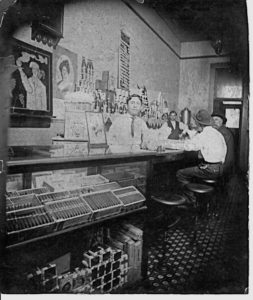
Counter in the Bright Star Cafe
Tommy Bonduris, another member of the restaurant clan, who worked as a bus boy at the Bright Star, described its fare: “A plate lunch at the restaurant in those days went for twenty-five cents. You got meat, three vegetables, a dessert and a drink. Coffee and doughnuts were a nickel.”
The “meat and three,” the eminent Southern food writer John T. Edge told journalist Adam Rhew, was “the foundational Southern meal.” This plate, the “bedrock of Southern culture,” had deeper roots than either fried chicken or barbecue. Country migrants to the city, Edge observes, brought their culinary affections with them. “As the Southern worker transitioned from farm to city, you see this meal arise…. It was food for people who plowed the back forty (side of the farm) …. Reinterpreted for people who work at desks and in factories, catching lunch breaks in the city instead of returning home for lunch.”
Serving this plate paid dividends. “Southern food was a way to assimilate,” Beba Touloupis, an owner of Ted’s Restaurant in Birmingham, told a trade publication. Pete Hontzas, who helped run Niki’s, another eatery in the city, offered a blunter explanation for this practice. “They did serve some Greek dishes, but you had to serve what people would buy,” he explained to writer Jennifer Kornegay. “You weren’t here to change the culture of America. You were here to make a living.”
The Bright Star went through several incarnations, moving from location to location as the restaurant grew. Its fourth and final address in 1915 was in the heart of Bessemer’s thriving central business district. The choice of the site was deliberate. Hoping that the Bright Star would be imbued with the city’s vibrant energy, Tom Bonduris placed it in the center of commerce.
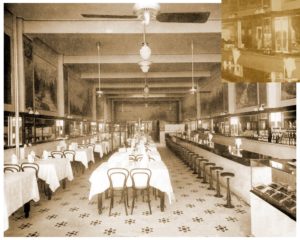
Inside the Bright Star Cafe
The Bright Star’s decor enhanced its appeal. Ceiling fans, hand-tiled floors, mirrored and marble walls, and marble countertops were highlights of the establishment. It had the feel, some observers felt, of a French café in New Orleans.
Hand-painted murals done by an itinerant German artist stood out. The story behind these paintings is part of Bright Star lore. As later owner of the restaurant Jimmy Koikos tells it, this footloose artist was “kind of just really like a wino, but he had talent.” Owner Tom Bonduris liked his work. “So he painted a European thing. And then he painted these murals one by one. Put them up. Then they fed him and wined him and he just wandered on through. He never dreamed they’d be up ninety years later.”
The interviewer probed further. “So did he just do it for trade?” “For trade and maybe we talk—talked to Mr. Bonduris a little bit—maybe a little money,” Jimmy said. (SFA)
Years later, seeing the “nicotine-patinaed murals” and eating a meal at the Bright Star was a moving experience for writer John Edge. He “realized that restaurant is its own kind of working man’s cathedral,” he told journalist Bob Carlton. “It’s an impressive place in which to sit, and yet is still mundane enough for people to have lunch there.”
(To Be Continued)
ACKNOWLEDGEMENTS & THANKS
I am indebted to Niki Sepsas, a Birmingham-based writer, for sharing his extensive knowledge of the area’s Greek community. Sepsas’s books, Hellenic Heartbeat in the Deep South and A Centennial Celebration of the Bright Star Restaurant, whose contents he assembled for the business, are invaluable guides to the history of Greek immigrants to the city. They are among the few works that provide a detailed account of Greek settlers in a major American city, let alone in the deep South. For readers interested in the development of the Greek food business, the book on the Bright Star tells the absorbing story of the 100+ year restaurant in Bessemer, a town close to Birmingham. The book pulls together appreciative statements by Bright Star customers on their experience at the venerable institution.
I am grateful for the assistance of Sam Bonduris, the nephew of Tom Bonduris, the restaurant’s founder. Sam took time out to fill in crucial gaps in Bright star’s saga.
The oral history interviews conducted by the Southern Foodways Alliance with key figures in the Greek food business were of enormous help.
The New Patrida, the Story of Birmingham’s Greeks, contains compelling portraits of pioneering ethnic entrepreneurs in the city.
Sofia Petrou’s A History of the Greeks in Birmingham is a ground-breaking study.
Birmingham Food: A Magic City Menu by Emily Brown skillfully covers the city’s culinary landscape.
Meet Me at the Bodega
“Yes, AOC, DC Does Have a Bodega Culture…,” the Washington Post proclaimed. The New York City representative had been lamenting the absence of these New York City corner shops in her new home. Increasing references to bodegas in Washington were getting tiresome. Wasn’t this neighborhood gathering place a quintessentially New York City institution? Why did DC even have to lay claim to it? Was the Capital City developing an inferiority complex?

A New York City Bodega
Bodega had filtered into the popular lexicon. People were using it casually as a catchall term for quick food convenience stores, whatever their lineage. What sense did it make, for example, to dub a Korean grocery store a bodega? Using the expression conveyed a certain worldly acquaintance with what had once been a marginal outlet—at least marginal to these onlookers.
New York politicians now must pay homage to the bodega, just as previous campaigners had paid mandatory visits to a knish bakery. God forbid that a vote seeker would mistake another type of store for the real thing. During the recent New York City Mayor’s race, Andrew Yang committed this blunder. He saluted a grocery, more like a sanitized Whole Foods, where he bought a banana and a bottled tea as a “bodega.” He was roundly chastised for his error.

Lin-Manuel Miranda, Creator of “In the Heights.”
The bodega was coming out of the shadows. The HBO adaptation of “In the Heights,” a Broadway musical created by Lin-Manuel Miranda, celebrated this neighborhood fixture. Set in Washington Heights, a predominantly Dominican section in New York City, the show revolved around a Latin store and its young Dominican owner, torn between his ties to his community and his longing to return home. The mock bodega featured props like the red and yellow cans of Café Bustelo, the strong Cuban coffee, which had become popular in hip circles.

The Popular Cuban Coffee, Cafe Bustelo, Often Sold in Bodegas.
The bodegas I knew were shops, owned largely by Dominicans. First established in Latin immigrant neighborhoods, they now dotted many corners of the New York metropolitan area. They still serve Hispanic regulars, cash their checks, give credit and share news and gossip. As young urbanites moved into the city, they discovered the bodega. It is a handy place to buy egg and cheese rolls, coffee, and other daily necessities.
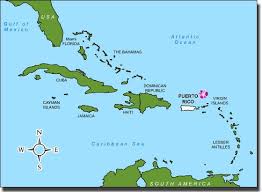
Map of Puerto Rico.
Immigrants from Puerto Rico pioneered the bodegas in New York City. The proprietors were part of a large wave of islanders who descended on the city after World War II. They built a colony in East Harlem, the barrio, as it was known, a neighborhood that had previously been settled by Irish, Germans, and Italians. Corner stores or bodegas, a name borrowed from the Spanish word for tavern or wine cellar, were haunts for immigrants first in East Harlem and later in the Bronx or Brooklyn. Owners sometimes set up a table outside for the locals to play dominos. The owner, or bodegerio, cared for customers’ everyday needs. “People come to a bodega when they want something small or quickthat’s our secret,” Albert Sabater, an owner told The New York Times’ Mariane Howe.
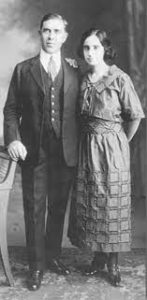
Prudencio Unanue with His Wife.
The owners needed business advice: what goods to stock and where to get them cheaply. A young go-getter, Prudencio Unanue, stepped in to help the budding enterprises. A native of Spain, who had migrated to Puerto Rico, he moved to New York City in 1918. Ten years later, he opened a small import business to bring food products from his homeland. His target was Spain’s large émigré community centered in the Manhattan neighborhood of Chelsea. The influx of Puerto Ricans convinced him that there was a larger market to tap. Unanue called his venture Goya.
The new arrivals were a different breed from the Iberians. They were “one of the first groups to migrate in masses,” Gerard Colon, Goya’s marketing director, recounted. The company built a food packing plant in Puerto Rico. The island pipeline provided the immigrants with products that “reminded them of home,” Unanue’s son, Joseph, recalled.
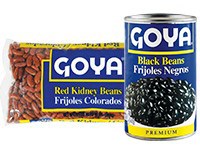
Goya Beans and Grains.
Goya cultivated the bodegas. “In the ’50s, we sold only to bodegas. The bodegas created us,” Joseph Unanue said. Goya’s wide array of goods filled the stores’ shelves: rice and beans, boxes of dried salt cod, amber bottles of guava, coconut, and tamarind syrups to make tropical drinks, papaya and guava preserves, and glass jars of black pepper, cumin, sesame seeds, and other spices.
The bodega would change hands. A new immigrant group, the Dominicans, was streaming into “Nuevo Yorko,” as they called it. The more than 500,000 Caribbeans became one of the city’s fastest growing groups. As the Puerto Ricans left their businesses, Dominicans, from the early sixties to the eighties, filled the void. “They started retiring and their kids were going into the professional world,” Luis Salcedo, the Dominican-born director of the National Supermarket Association, said. The Dominicans modeled their businesses after their homeland’s convivial markets, or colmadas.
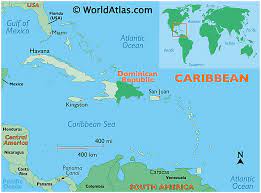
Map showing the Dominican Republic.
Government workers, cab drivers, cooks, and factory hands from the island provided a strong customer base for the Dominican bodega’s wares. Goya’s salesmen again provided wise counsel. “They are very loyal customers to our products,” Goya executive Conrad Colon pointed out.
Both the Puerto Ricans and the Dominicans shared common tastes. “The basic thing is the olive oil, garlic, and oregano,” Colon noted. Each group also had particular preferences, and Goya tailored its product line accordingly. Puerto Ricans favored pink (rosada) and kidney (marca diabla) beans, while the Dominicans were enamored of the red roman or cranberry bean.
The bodegas spread out to Massachusetts, Connecticut, and Pennsylvania. The entrepreneurs, for example, found an opening for their businesses in Waterbury, an old industrial town in Connecticut’s Brass Valley, where the Irish, Italians, and other early immigrants had settled.
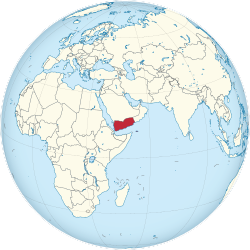
Map of Yemen.
The bodega business in now in flux. Even though Dominicans still hold a commanding position in the market, new ethnics have been attracted by the business opportunities. Yemeni immigrants are now the most visible of the new recruits in New York City. In Brooklyn, where they have taken the helm of many corner shops, the change is striking. “Lamb over rice is on offer at my local Yemeni owned bodega,” writer Quizayra Gonzalez observes.
Yemenis have a long immigrant history in America. They initially labored in auto plants in Detroit and steel mills in Buffalo. Weary of toiling in declining industries, they turned to small business. “By culture, we are traders,” Abdul Nashir, principal of an Islamic school in Lackawanna, a town next to Buffalo, remarked. On Buffalo’s east side, the Buffalo News reports, Yemeni shops have sprung up “to sell everything from frozen meats and bread to scented body oils and winter jackets and gloves.” The immigrants have followed a similar route in other cities. Yemenis control Oakland, California’s liquor business and operate many convenience stores in the Detroit area.
Yemenis, some of whom fled Buffalo’s steel mills, have joined a community of Arab merchants in downtown Brooklyn. “Every kid back in our town in Yemen knows the names ‘Court Street’ and ‘Atlantic Avenue,’” Ibrahim Qatabi, a Yemeni activist, told Christina Goldbaum of The New York Times. Owners often hired relatives who, after learning the ropes, were eager to start their own shops.

Nasim Almuntaser at His Family’s Bodega in Brighton Beach.
The tight kinship ties in the Arab state encouraged the patronage relationship. “Yemeni society as a whole is structured far more along clan society- and clan-based lines than any of the other Arab countries, Moustafa Bayoumi, a Brooklyn College professor, told Kiran Sury, a City Limits writer. Proprietors maintain their family connections in Yemen, sending back funds. “They also want to keep very much a foundation within Yemen because it’s a very remittance based economy,” Bayoumi added. “And so people tend to go back and forth a lot.”
The storekeepers, who prefer to call their shops delis or convenience stores rather than bodegas, carry products similar to those in Latin stores. The stores, however, may have a prayer room in the basement, and only sell halal meats, not pork.
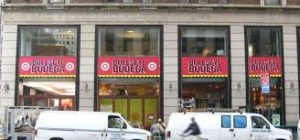
A Bodega Mini-Mart in New York City.
The owners have banded together to form the Yemeni American Merchant Association. The organization caught The New York Times’ attention in 2019, when it protested President Trump’s travel ban by closing their shops and gathering for a rally in downtown Brooklyn. The President’s order hit home. It threatened to stop Yemeni wives and children from reuniting with their families.
The owners are picking up American merchandising techniques. Ahmed Alwan, a bodega merchant, made a Tik Tok video showing him playing a math game with a customer. As reporter Quizayra Gonzalez tells it, the owner offered a prize, any item in the store, for a correct answer. The patron guesses right and reaches out to grab the one indispensable item in any bodega. Alwan quips, “Not my cat.” Some second generation Yemenis are eager to remake their parents’ bodega. One owner’s sons, The Los Angeles Times reports, prodded him to expand his wares to include “fresh squeezed juices, fruit shakes and organic breads.” Their father was adamant. He was comfortable with the store as is.
“Why Are All the Pete’s Restaurants Named Pete’s?”
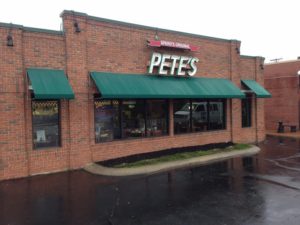
Pete’s Restaurant, Greenville, South Carolina
“Why are all the Pete’s restaurants named Pete’s?” the headline of a story in the January 9, 2000 Greenville News asked. The reporter, Mike Foley, observed that these eateries in the South Carolina textile town and the surrounding upcountry area were more likely to be run by owners with Greek names like Spiros and Georges. But “that doesn’t stop customers asking for Pete when they walk in the door, sit at a Formica-top table and get a whiff of hamburgers grilling and onion rings frying,” Foley writes. “Everybody says, ‘Where’s Pete? Where’s Pete?’ said George Mastorakis, owner of Pete’s Drive No. 7 in Greek,” the article continues. “But there’s no Pete.”

Pete’s Diner, Greenvile, South Carolina
The common names can cause confusion among customers, Foley notes. People forget where they had dinner or ordered takeout. “I’ll have people call here and complain,” one operator told him. “I’ll have people call here and complain. They’ll say they just came in here and got an order of jumbo shrimp here. They just pick the wrong number out of the book.”
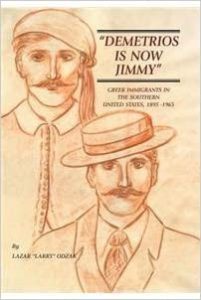
Lazar Odzalc’s book about the Americanization of Greek immigrants
Eager to fit in, Greek businessmen were afraid to call attention to themselves. Foreign names, even serving ethnic food, were roadblocks to Americanization. In Southern towns, the newcomers were easy targets for the xenophobic. In the early 20th Century, the Atlanta Constitution, scholar Marni Davis reports, frequently tarred Greek merchants as “dagoes.” A name change was a characteristic response. “Demetrios Is Now Jimmy,” historian Lazar “Larry” Odzalc titles his book on Greeks in the South.
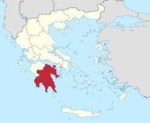
Map of Greece with Peloponnese shown in red
Fleeing the rugged, unforgiving land of the Peloponnese peninsula at the turn of the twentieth century, Greeks journeyed to South Carolina. Although we associate Greek immigrants with big cities like New York, Boston, and Chicago, the South was also a popular destination. Mostly bachelors, the pioneers sought out Southern cities whose economies were expanding. The “New South” was advancing, growing into a commercial and industrial region bursting with employees needed to run the factories, insurance companies, and sales offices. Entrepreneurially minded Greeks spotted an opening for their talents. The workers were consumers and the immigrants saw themselves as providers for their wants. They built food businesses to cater to the working and middle classes. The innovators were breaking new ground in the South, creating a niche where none existed.

Food Offerings from Pete’s Clock Restaurant, Greenville, SC
The early ventures in South Carolina suited the Greek temperament. Averse to toiling as hired hands in mills and factories, the newcomers yearned to be their own bosses. Selling produce from pushcarts was a common starting point. Candy shops, a favorite business of Greek immigrants throughout America, were another stepping stone. These businesses often sold ice cream, sandwiches, and other quick fare. Three such stores, historian Judy Bainbridge points out, had opened by 1907 in downtown Greenville. From sweet shops, Greeks often embarked on the restaurant or, more specifically, the quick lunch business. By the middle of the 1920s, Bainbridge says, the budding ethnic merchant class dominated Greenville’s food business. By that time, 14 Greek lunchrooms were serving hot dogs, sandwiches, and similar items that did not offend Southern tastes.
Storefronts with comforting names like Tom’s Nickel-Up, Post Office Café, and Quick Lunch betrayed little of their owners’ origins. Their locations were shrewdly chosen. In Greenville and other South Carolina towns, the Greeks set up shop on the main commercial downtown streets.
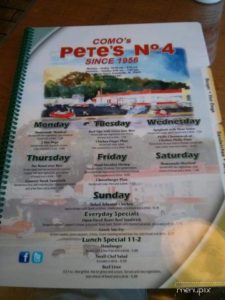
Menu from Pete’s No. 4, Greenville, South Carolina
News of the alluring opportunities in South Carolina spread. Eager to replicate their success, kinfolk of the owners headed for South Carolina. “An immigration chain led family members and others from the same village to settle here,” historian Bainbridge writes. The new arrivals capitalized on these connections. Finding a job in a kinsman’s restaurant and learning the ropes was excellent preparation for opening one’s own business. Journalist Foley describes a Greenville eatery, owned by Spero Contis, where new immigrants apprenticed. “Pete’s Original served as a makeshift training school for restaurant owners. Most all the Greeks who work in the business have worked here,” Contis said. A constant stream of immigrants thus replenished the Greek food trade.

St. George’s Greek Orthodox Church, Greenville, South Carolina
The entrepreneurs gradually put down roots. The early colony of bachelors blossomed into a settlement of families. More and more Greeks left the city for homes in the suburbs. Craving acceptance, Bainbridge notes, owners joined the Masons, Odd Fellows, and other societies. The immigrants were assimilating but still clung tenaciously to their traditions. During the Thirties, families joined together to build the St. George’s Greek Orthodox Church. During World War II, congregants demonstrated a patriotic spirit. They bought war bonds and raised money to purchase a plane. The women of the church, Bainbridge recounts, put on a “spaghetti dinner Greek style” to raise money. St. George’s would organize regular festivals featuring Greek food, music, and dancing, which won friends among the locals. Nick Theodore, an insurance executive active in the church, personified the Greek ascent into the mainstream. “Uncle Nick,” whose parents emigrated from Sparta, was the first American of Greek ancestry elected to the South Carolina state legislature. Theodore went on to serve as the state’s lieutenant governor from 1987 to 1995.
The new generation of Greek restaurant owners is bolder than the lunchroom pioneers. More Greek food is on offer in the Greenville area, even if it is sometimes altered for the Southern palate. Tzatziki, souvlaki, spanakopita, pasticcio, and other Greek standards attract a curious and adventurous clientele. No longer reticent, the merchants broadcast their ethnicity with restaurant names like Ji-Roz, Kaires Mediterranean, and Greektown Grill. Old school owners would have been proud of their successors.
A Greek-American Odyssey:
New Hampshire’s Puritan Backroom Restaurant

Arthur Pappas and his sister Pamela Goode in front of the Puritan. Photo by Kendal J. Bush
It’s a ritual. Candidates for the presidential primary in New Hampshire head for the Puritan Backroom restaurant in Manchester to shake hands and greet customers who crowd the establishment. The Puritan is an unlikely name for a business two Greek immigrants started more than 100 years ago as an ice cream and candy shop. Through several incarnations, it blossomed into today’s spacious dining rooms. U.S. Congressman Chris Pappas, whose father, Arthur, runs the Puritan, is the fourth generation family member to be a partner in the Manchester landmark.
Without ignoring Greek food tradition, the Puritan unabashedly courts mainstream diners. “They come for the chicken tenders and stay for the politics,” writer Eunice Panetta aptly observed. (Chicken tenders are a wildly popular menu item—more about that later.) The story of the Puritan’s rise is a chapter in a larger saga. It is the tale of an immigrant community, once reviled as alien and its climb to a fully integrated and highly esteemed part of the fabric of Manchester.
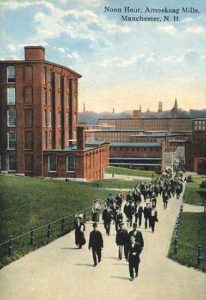
The noon hour at Amoskeag Mills.
New England mill towns like Manchester were a magnet for Greek immigrants, who streamed in during the late nineteenth and early twentieth centuries. Companies in towns like Lynn, Lawrence, and Peabody needed factory hands and a succession of newcomers provided cheap labor. Manchester was founded as a textile town by a group of businessmen attracted by the abundant water power of the Amoskeag Falls along the Merrimack River. Patrician investors, like the Cabots, Lawrences, and Lowells, poured money into the project. The early industrialists, who had built textile mills in Lowell, Massachusetts, started constructing a vast complex that, by the 1900s, boasted 30 buildings and 17,000 workers. The Amoskeag Manufacturing Company rose to the heights of American industry. By the early 1900s, the 137-acre company was the world’s largest textile mill. (Amoskeag was a corruption of the Pennacook Indian word for this “place of many fish.”)
The magnates systematically planned the city to serve the requirements of their business. They planned its streets and parks around the axis of the factory. They imagined the city in paternalistic fashion. The company provided housing, playgrounds, and other municipal services for its charges. From the beginning, since skilled workers were in short supply, the textile colossus had to go abroad to procure them. Amoskeag, which specialized in gingham, flannel, and other cotton fabrics, recruited skilled workers who knew the tasks of the trade. Ezekiel Straw, the company agent, organized efforts to hire dye masters and weavers from England and Scotland, as scholar Aurore Eaton tells it. The mill placed ads in newspapers and circulated leaflets touting the bountiful opportunities in America: “Wonderful conditions at Amoskeag in Manchester, New Hampshire.” The ads pictured a mill worker leaving the yard with a wallet stuffed with cash, heading to the bank.

Amoskeag Manufacturing Company.
Not only craftsmen, but unskilled workers were vital for the mills. The employers brought in the Irish to build the mills and then to labor in them. French Canadians, fleeing rural hardship in Quebec, were signed up. The Irish feared that the French, who detractors called the “Chinese of the East,” would pull down wages. In time, the French, who by 1900 made up 60 percent of the work force, settled down in Manchester. They established their own parish church, credit union, and other institutions.
By the early 20th century, Amoskeag was hiring workers from southern and eastern Europe and the Middle East to cut costs. Greeks, Poles, Lithuanians, and Syrians joined the workforce. By 1910, the polyglot laborers spoke 28 languages. This suited the employers perfectly. The bosses often exacerbated the differences between the nationalities and ethnic groups by assigning them to separate work rooms. The divisions discouraged unified protest.
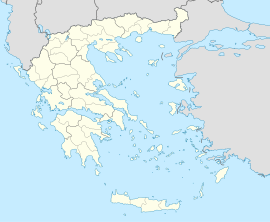
Map of Greece.
The Greeks, a large share of whom came from the rugged northern region of Macedonia, put up with harsh conditions and prejudice as the price of a path to opportunity. Many of the early immigrants were single men who left their peasant villages behind. Giorgios Kalampalis was one such greenhorn. As his uncle Spiros recounts in his book, The Dreams Come True in America, the 28-year-old was hired at Amoskeag in 1915 as a “greaser.” He was similar to other fresh recruits: They were “industrious, they weren’t lazy at all. When they looked for a job, they wouldn’t ask how much the pay was or how many hours they would be working.” The Greeks were taunted, Kalampalis recounts, especially by the Irish: “In the morning, as the Greeks were walking to work, the Irish would throw eggs at them through the windows and shout at them that they should go back to their home country.”
A Greek colony gradually was taking shape in downtown Manchester. The sojourners, who often dreamed of returning home with savings to buy property or to finance a sister’s dowry, were putting down roots. The Greek population was surging. The pocket of 300 immigrants in 1905 had burgeoned into a settlement of 1330 by 1910. By 1920, there were 3,000 new arrivals. The attractive opportunities in New Hampshire gave the small state a larger number of Greeks in proportion to the total population than any other, according to scholar A. Reed Carver.
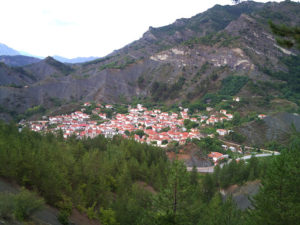
Eptahori village in Greece.
The pioneers sent glowing letters home. The result was what researcher George B. Collins called “chain letter” migration. “Patriotis,” friends and relatives, joined fellow villagers in Manchester. Greeks identified with their village first and their country second. In 1903, people from Eptahori, an area in Macedonia that sent many residents to Manchester, founded a village association in their new home. They were not alone. Several village communities were “transplanted” to the Queen City, historian Tadeusz Piotrowski observes.
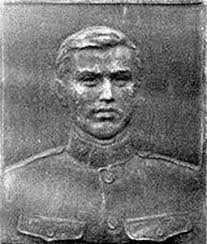
Likeness of Christos Kalivas from his monument in Kalivas Park, Manchester.
The Greeks clustered in the ten-block area downtown around Park Common (now known as Kalivas Park, named for the first Greek soldier from Manchester killed in World War I). Irish factory workers, who called the section Carrot Field, had settled earlier in the neighborhood’s tenements and boardinghouses. Although other ethnics, Poles and Syrians, dwelled nearby, Greeks were increasingly becoming the majority. Conveniently located a short walking distance from the mills and a cheap place to live, the area around Park Common was inviting. Most important, the Greeks were seeking security by huddling together. “Greektown,” as scholar Collins puts it, “was a refuge for immigrants from the alien and sometimes hostile society around them.”
The immigrants shaped their settlement in the image of their ancestral homeland. To the Greeks, Park Common was their “mesochori,” the village square. It was the focal point of their ethnic enclave, a place to congregate, catch up on news, and relax from the stresses of the daily toil.

Assumption Greek Orthodox Church, Manchester, NH.
Nearby ethnic businesses and cultural institutions created a cohesive community—agoras (markets), butcher shops, and grocery stores sprang up. The immigrants banded together to buy the land for the Assumption Orthodox Church. Several coffee shops (kafenia) provided a refuge for homesick men seeking companionship and solace in an often unwelcoming city. “Spruce Street lined with coffee houses in which men from Land of Homer gather; here proud of their race and industrious as a whole,” the Manchester Union newspaper recorded in 1910. They came to talk, dance, and drink strong dark coffee in these gathering places. The kafenia offered their customers practical help, long-time Manchester journalist and now executive director of the Manchester Historic Association, John Clayton, remarks: “You could play a couple hands of xeri or pick up a copy of Spiros Cateras’s local Greek newspaper but a coffee house also served as a vital employment office where George Copadis (The Elder) helped immigrants.”
Bridling at the thought of a lifetime of factory jobs, many Greeks launched their own businesses. They worked as coffee grinders, confectioners, produce merchants, plumbers, tailors, and billiard hall owners, among other occupations.

WPA Guide to the Granite State, New Hampshire.
Purveyors of traditional foods nourished the neighborhood’s denizens with memories of home. “[We] remembered a simpler time when there were … lambs hanging in Nassika’s butcher shop, black olives at the Tyrna market, and freshly baked bread at Copadis’ bakery,” Spiros Plentzas and Chris P. Kehas, the authors of The Spirit of Kalivas Park, remembered the district during World War I. The exotic sight of “Greek and Oriental pastry displayed in sweet shops” fascinated a writer in the WPA book on the “Granite State.”
Greeks in Manchester clung to village customs and traditions. Simple repasts were enriched with age-old techniques. Evanthea Keriazes followed her mother’s practices when making her children “grass pies.” The “leaves” (filo pastry) were filled with eggs, cheese, and spinach, she recalled in an interview with the WPA during the 1930s. In Manchester, she said, families carry on “our gaieties in our homes,” lacking “village squares to dance in.”

Tradition of Cracking Dyed Eggs at Greek Easter Celebrations.
After the Easter church service, Keriazes joined with friends and relatives “exchanging Easter eggs dyed red to symbolize joy and by crying ‘Christ is risen’ and ‘He is risen, indeed.’” On Decoration Day, 49 days after Easter, “wheat cakes … large cakes made from sugar and beautifully designed,” were carried to the church.
The day before Christmas was a festive occasion. A pig was slaughtered and the remaining lard was preserved so that it would last through the year. “We children do not like pastry made from ‘store’ lard and often refuse to eat it.” In Greece, pies required shortening “of the right consistency to make the rich, flaky crust we needed.”
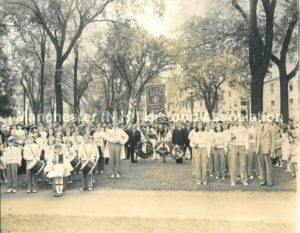
Greek American Progressive Association at Kalivas Park, Manchester.
The tight-knit community was all too frequently greeted with suspicion and anger. A 1910 Manchester Union article that writer John Clayton uncovered depicted the Greeks with xenophobic glee. “The most foreign of the foreigners now in this city in large numbers are the Greeks,” the anonymous author put it. “The average citizen knows the Greeks here in Manchester as the man who blacks his boots … or who makes and sells confectionery and ice cream soda cheaper than the ordinary white man in the business,” the writer continued. “The police say that a Greek is industrious, energetic, and generally useful except when he lingers too long in a Spruce Street coffee house or indulges too freely in the wine that is red.”
Antagonism between the Greeks, the newcomers to the mills, and more established groups like the French and especially the Irish was intense. They blamed the Greeks for working more cheaply in the textile and shoe factories and for stealing their jobs. When Greeks in 1903 were recruited to break a shoe strike, the incident reinforced fears of the newcomers. Their neighbors complained that the outsiders harassed their wives and daughters. “They tell of women held up on the street and vile insults offered,” The Manchester paper, the Mirror, reported.
Ethnic animosity was not new to Manchester. The Irish, who poured into the mills after the potato famine of the 1840s, faced hostility. On July 3, 1854, anti-Catholic marauders were bent on burning the St. Anne parish church. Journalist Clayton carries on the story: John Maynard, “the city’s leading contractor at the time, was able to disperse the crowd, partly because he held the working future of many Protestants in the palm of his hand. Perhaps more importantly, he held a gun in the palm of his other hand.” The Know-Nothings, a fiercely anti-Catholic political party, had a large enough following in Manchester to elect Theodore T. Abbot, one of their own, as mayor in 1855.
Park Common, the heart of the Greek community, was the scene of ethnic battles between “warring races,” as the Mirror indelicately put it. The Greeks considered the common as their turf. The Irish thought otherwise. “The Greeks who swarm so thickly in the boarding houses down Spruce street and elsewhere in the vicinity would like the common as their own backyard,” a Mirror reporter observed.
Clashes were inevitable. On July 11, 1905, a fracas on the Common exploded in violence. Although accounts differ, a common thread involves a Greek who was hit by an errant baseball thrown by a group playing catch. Tempers flared. Greeks were chased in a melee in which some of their assailants drew knives and threw brickbats.
The press painted the battle as a “race war.” The Mirror headline read, “Riot of Races Broke Out Last Night on Park Common.” Although the Greeks suffered most from the fighting, they made up the majority of those arrested. There was a definite ethnic tinge to the riot. Two of three men ultimately charged in the case, John Sullivan and William Sweeney, had distinctly Irish names.
The Manchester police, operating like an arm of the Amoskeag company, kept a sharp eye out for immigrant misbehavior, especially by the Greeks. Ireland-born Michael J. Healy, the city’s first police chief, appointed in 1895, kept detailed records of lawlessness, historian Scott Roper reveals. Although the English, Irish, and French committed offenses, the police log book highlighted the ethnicity of other miscreants. Greeks, Roper notes, were suspected of “stealing wood and coal.” Theft of bottles of milk, or, in one case, a saucer of milk, were blamed on the aliens.
Authorities, like Chief Healy, were especially fearful of Southern and Eastern European immigrants, in their eyes a particularly truculent group. Rattled by the 1905 “race riot,” he worried that these workers would be receptive to a radical labor message. The Wobblies, the Industrial Workers of the World, or I.W.W., had spearheaded a militant strike among the widely diverse immigrants in Lawrence, Massachusetts, a nearby mill town.
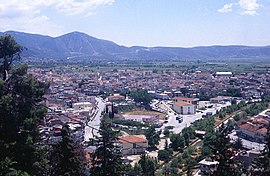
Elassona, Greece.
Undeterred by the hostile climate, entrepreneurially minded Greeks pushed ahead. Two friends from Northern Greece, Arthur C. Pappas and Louis K. Canotas, who had worked together at a remnant store in Elassona, arrived in Manchester in 1906. They took jobs in the city’s mighty industries—textiles and shoes. Pappas found work in an Amoskeag mill, while Canotas was hired at a factory owned by the McElwain Shoe Company. (The firm, in the second largest industry in Manchester after textiles, became famous for its Thom McAn line of shoes.) They were eager to strike out on their own. Canotas opened a shoeshine parlor, a frequent launching pad for Greek immigrants. Pappas left Manchester to operate a fruit and candy shop in Natick, Massachusetts. The friends soon launched a series of shops from which today’s Puritan Back Room is descended.
The Puritan Confectionary Company was their first venture in Manchester. It opened on April 5, 1917. Making homemade candy and ice cream, the founders joined a legion of countrymen whose shops dotted the corners of small towns and big cities in the early 20th Century America. The name Puritan appealed to them. Congressman Chris Pappas, Arthur’s great grandson, thinks he knows why they chose it. “I think they wanted a name that grounded them in New England and sounded very American,” he said in an interview on New Hampshire Public Radio. The early shop, established on the eve of America’s entry into World War I, faced hurdles but overcame them. Because of rationing, Chris’s father Arthur told writer Jack Kenny, “They had to buy sugar on the black market. How do you make money without sugar?” Their products were popular because the owners stuck to the basics, the chocolates and vanillas. The two businesses nicely meshed—peppermint and maple walnut were equally good for candy and ice cream.
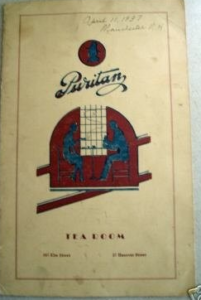
1937 Menu from the Puritan Tea Room.
Two years later, the compatriots went into the restaurant business. They landed a perfect location, across from City Hall. “It was a kind of favorite spot,” former Mayor Sylvio Dupuis tells journalist Kenny. “For people working or doing business in Manchester, it was at the top of the list of places for having lunch.” At this time, people thronged downtown, Arthur Pappas added. “Monday and Thursday nights were the busiest. That’s when all the stores stayed open at night.” Thursday, he pointed out, was the day mill workers were paid. “People did their shopping downtown, their banking, you went to the movies downtown, everything was downtown.”
A young newspaperman in post-World War II Manchester became a Puritan regular. Ben Bradlee, the late executive editor of The Washington Post, writes in his memoir, A Good Life, of a “Greek greasy spoon joint where the hamburgers were cheap and the waitresses were pretty. (Where are you now, Jo?)”
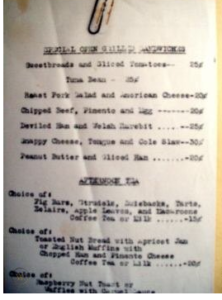
Sandwiches and Afternoon Tea from Puritan Menu.
The Puritan also offered customers a more sedate setting. A 1937-38 menu listed an array of open grilled sandwiches, like Deviled Ham and Welsh Rarebit, Chipped Beef, Pimento, and Egg, and Peanut Butter and Sliced Ham, priced at 20 and 30 cents. The restaurant served an Afternoon Tea. Among the choices were Toasted Nut Bread with Apricot Jam and English Muffins with Chopped Ham and Pimento Cheese. The Puritan called itself a Restaurant and Tea Room, a name with a New England ring.
The Greek merchants would leave the once-bustling downtown behind. Shops were departing for the suburbs and new businesses were avoiding the city center. Seeing the writing on the wall, Pappas and Canotas decided to move. In the late sixties, the partners moved their operations to Daniel Webster Highway, where they already were operating an ice cream stand.
The Puritan concentrated on quick items for the carry out trade. Hot dogs, lobster rolls, and pizza pulled in customers. Ice cream, the eatery’s hallmark, continued to tantalize patrons. The sweet is “what got a lot of our customers coming in the first place,” Plato Canotas, son of founder Louis, told journalist John Clayton.
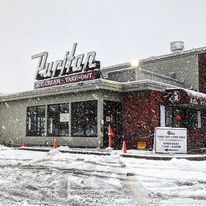
The Puritan in Winter.
In 1974, the owners opened a full-service restaurant, which they called the Puritan Backroom, because the entrance was in the back. (The Front Room was the section devoted to takeout.) The vast, sprawling 240-seat restaurant housed several dining rooms and a bar. The Puritan also added a conference center to bring in more business.
The Puritan sold itself as a family dining room with ample helpings, reasonable prices, and familiar food. Like the diner and many other Greek food businesses, it offered a wealth of choices, from roast turkey to lasagna. Giving a nod to its own culinary traditions, the Puritan sells spanakopita, tzatziki, and fried feta, in addition to other items, like nachos, buffalo wings, potato skins, and shrimp cocktails, to snack on. Another specialty is mac n’ cheese with a Greek accent. The touch of cinnamon in the dish signals its debt to pastitsio, a classic Greek casserole. New England standbys like haddock, clam chowder, and lobster pie share the menu with lamb kebabs.
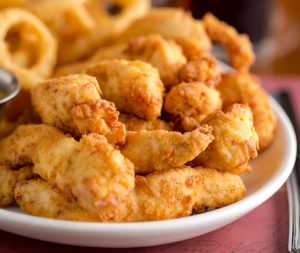
The Puritan’s famous Chicken Tenders.
One dish with no specific Greek connection has become a crowd pleaser. Chicken tenders, grilled or fried, as a salad feature or pizza topping, are a menu centerpiece. (Chicken tender parmigiana or cacciatore are other alternatives.) Charlie Pappas created them in 1974, according to son Arthur. “We were selling boneless breasts of chicken, and our supplier was ending up with a lot of little pieces he didn’t know what to do with. So my dad … said I will come up with an idea, and we started selling Chicken Tenders,” he told New Hampshire Public Radio. Instead of discarding the strips left over from preparing a boneless chicken breast, the Puritan, after marinating, seasoning, and frying them, fashioned a singular plate. Arthur’s son Chris also admired Charlie’s inventiveness. “My grandfather considered himself a pioneer when it came to fried chicken…. It turns out that the byproduct of something else became the focus of the menu,” he said to journalist Nik DeCosta-Klipa.
The tenders can be perked up with one of several flavorings—coconut, buffalo, or spicy sauces. The Puritan conjured up its own “special sauce” for the dish that combines soy, olive oil, and unenumerated spices. Many patrons dub the condiment duck sauce. Chris Pappas calls it “sweet and sour” sauce.
The ingredients in the flavoring remain cloaked in mystery. The secrecy surrounding it is reminiscent of another confection, the “Coney Island” sauce draped on hot dogs in Greek eateries. Arthur Pappas guards it vigilantly. “It’s written down in the safe, so if something happens to me—if I go—if I go away on vacation, I try to make a little extra, just in case the plane crashes,” he told the NPR station. “They can still bury me, and I can have my special sauce at my funeral.”
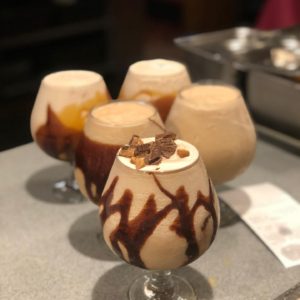
An array of Mudslides from the Puritan.
Another Puritan calling card, frozen mud slides, highlight a meal. The drink that some have called called a “booze infused” cocktail is typically made with vodka, Kahlua, and Baileys Irish Cream. Slides come with different flavors—Almond Joy, Snickers, and even Churro. The appetite for the drinks was so insatiable that, in 2011, the Puritan was the country’s largest purchaser of Baileys.
Homemade ice cream tops off a dinner. The Puritan markets such New England treats as maple walnut and grape nut and wows customers with novel flavors like baklava, Cherry Seinfeld, and Moose Tracks.
The proprietors have assiduously built up a loyal clientele hosting birthdays, anniversaries, and family functions. The Puritan lavishes attention on customers. “We all need repeat customers. When you meet a customer for the first time, you treat them like your favorite relative,” Arthur Pappas commented to journalist Kenny.
Employees also required special attention. Younger workers often found their job at what writer John Clayton called “Puritan Prep.” The restaurant fostered loyalty among its workers by encouraging their education. Puritan employees chalked up their success to its tutelage, journalist Kenny discovered. “I had to maintain a B average to be able to work here,” Sheila Macdonald, a former worker, said. Another hire, Moises Montes, a Salvadoran, enrolled at Central High School, at owner Plato Canotas’s urging. Puritan paid for his English classes at University of New Hampshire, Manchester.

U.S. Rep. Chris Pappas (D-NH)
The combination of political electricity and hearty food has enhanced the Puritan’s fame. Ever since the advent of the New Hampshire primary, the Puritan has grown into a mandatory stop for candidates, Democrat and Republican. The opportunity to meet and great locals in a family restaurant that exudes hospitality has been hard for vote seekers to refuse. Mingling with “regular” people, reporter John DiStasio, a veteran New England journalist, observes, is a major draw. “It’s not like some white table cloth sort of place,” DiStasio told writer Nick DeCosta-Klipa. “They have really good food, and the place is really crowded.”
The Puritan was a unique restaurant. “Right from the beginning, politics was infused into the business,” co-owner and Congressman Pappas remarked to political reporter Chris Cilizza.

Mike Dukakis, former Governor of Mass. and candidate for the presidency.
From an early age, politics pulsed through Chris Pappas’s life. He was an early fan of Mike Dukakis: “I remember being at school, and Dukakis and Tsongas [former Senator from Massachusetts] were there,” he reminisced to writer Panetta. “In my second grade class, people were lining up outside the windows, and I literally made several paper airplanes that said ‘Dukakis’ on them, and threw them out the window at the people down below, probably violating all election laws.”

Paul Tsongas, former Senator from Massachusetts.
He worked as a youngster at the Puritan, where he sharpened his political antennae: “You get a sense of people in an environment like this, you get a sense of who is genuine and who is a politician,” Chris explained to Panetta. “People in New Hampshire understand how to deconstruct candidates and get to the core of who they are.” His restaurant apprenticeship prepared him for campaigns for elected office. He won a contest for New Hampshire State Representative and secured a position on the state’s Executive Council. His state jobs were a springboard into national politics. Chris, who is openly gay and a liberal Democrat, was elected in 2018 to represent New Hampshire’s 1st Congressional District in the U.S. House of Representatives.
Stories of suitors for national office, Democratic and Republican, are part of Puritan folklore. Customers recall candidate Joe Biden sampling the restaurant’s popular ice cream on February 8, 2020. Sargent Shriver typically ended a day of campaigning tucking into a plate of lamb kebabs. Hillary Clinton made frequent pilgrimages to the Manchester restaurant. Her husband arrived one late evening in 1992 and ended up bantering with the cooking staff and watching a basketball game on TV. President George H.W. Bush descended on the Puritan in 1992 with his Secret Service entourage.

Hillary Clinton with Chris Spirou.
Hillary Clinton did more than woo customers at the restaurant. She used its facilities for her political operation during the 2008 primary. The candidate transformed the restaurant conference center into a call center, journalist Cilizza notes. She organized a get-out-the-vote rally in the restaurant’s parking lot. “I like to think all the chicken tenders and coffee for her volunteers fueled her upset victory,” Chris Pappas told the reporter.
The Puritan story provides important lessons about American politics, Cilizza believes: “The Puritan and its political history and chicken tenders speaks to the centrality of retail politics in running a presidential campaign.”
Greeks have played an influential role in New Hampshire politics. Chris Spirou, a former New Hampshire minority leader in the state senate and former chairman of the state Democratic Party, credits Hillary Clinton’s New Hampshire primary victory to Greek voters. Spirou, who once washed dishes at the Puritan, argues that Greeks voted 9-1 for Hillary. Her campaign manager, he notes, was Greek, and Chris Pappas was her top delegate. Speaking to writer Apostolus Zoupaniotis, Spirou remarks that Clinton told him that “the community played an important if not a decisive role in this election.” Greeks looked to politics as a route to advancement in America. Just as it had been for the Irish, writer Clayton observes, politics was a “tool of assimilation.”

Ted Gatsas, former mayor of Manchester, NH.
The owners of the Puritan achieved recognition not only as restaurateurs, but also as civic leaders. They have promoted local nonprofits, backed civic clubs, and supported baseball teams. The Puritan’s achievements paved the way for the wider acceptance of the Greek community. Other prominent Greeks in Manchester have raised its standing. Among the notables are the aforementioned politician Chris Spirou and his brother Stan, the former coach of the Southern New Hampshire University men’s basketball team, former Manchester mayor Ted Gatsas, and George Capodas, the state Commissioner of Employment Security. Greek sports heroes like Gus Zitrides, John Kilonis, Spike Papageorge, and Andy Prutsalis have won friends for the ethnics.
Manchester, like other factory towns, is in the throes of change. Older ethnic groups are moving out of the center city. Department stores and modern apartments supplanted the aging housing of Park Common. Greeks have dispersed, leaving their once-vibrant Manchester neighborhood behind.
An influx of new immigrants has introduced the Queen City to unfamiliar cultures. Ethnic eateries from Cuba, Mexico, and the Dominican Republic have set up shop. Adventurous diners can sample Nepali fare and buy Bulgarian and Bosnian foods at a downtown grocery. One of these businesses, although marginal now, may develop into a welcoming city institution, a future Puritan.
ACKNOWLEDGMENTS
John Clayton, executive director of the Manchester Historic Association, was an invaluable source of information and anecdotes about his hometown. His writing sparked my interest in the subject. Arthur Pappas took time away from his business to relate the story of the Puritan. Theresa Kimsey, Information and Technology Librarian at the Manchester City Library, generously aided this writer in his quest for often hard-to-find materials. Daniel Peters, Research and Facilities Manager at the Historic Association, gave me valuable background. Meletios Pouliopoulos, who directs the nonprofit Greek Cultural Resources, offered help and support.
“The Right Man, The Right Coffee”: A Greek Family’s Gift to New York Diners

Campaign Poster for Vassilaros for Mayor
“The Right Man, The Right Coffee.” An unconventional campaign slogan in the New York City race for Mayor in 2013. John Vassilaros, the third-generation Greek American to lead the family business, was the standard bearer. Posters, a web site, videos, and social media heralded his run. “Wake up with us for the next four years,” one poster declared. Founded in 1918, Vassilaros & Sons Coffee Company’s product became a staple of many Greek-owned diners and coffee shops, but its name was largely unknown.
To broaden its audience, to reach consumers directly, Johnny, as he was affectionately known, hired an advertising agency to orchestrate the mock campaign. The goal of the publicity was to identify the product more closely with its home town. Other earlier brands, like Chock Full o’ Nuts and Savarin, had marketed themselves that way. The panel on company trucks would read “NYC Dept. of Coffee.” “Vassilaros & Sons needs to own ‘New York City Coffee … there isn’t a brand identified as the city’s own,’ advertising executive Richard Kirshenbaum commented to The New York Times.

Salesman JJ Papalas Stands Next to Vassilaros Coffee Truck
Mr. Vassilaros enlisted a friend, the comedian Lewis Black, to help in the promotion. The comic praised the brand as “the finest cup of coffee ever served in the city of New York.” Black, the joke went, did two video takes, one on caffeine, the other not. The campaign let its audience in on the truth behind its whimsical strategy: “Unfortunately, Johnny Vassilaros has decided not to run for New York City’s mayor,” the web site said. “He is too busy running New York City’s best coffee company.”
The founder of the company, John’s grandfather John Anthony Vassilaros, arrived in New York City as a young man, with his wife and young child, penniless, from Ikaria, the rocky Greek island in the Aegean Sea. Looking back, Alexandra Vassilaros, the wife of his grandson, remarked to an interviewer from EdibleLongIsland.com, “He left to mine possibilities in America. He was a true immigrant seeking a better life. He was very dynamic and entrepreneurial.” To put food on the table, he took two jobs as a waiter, a lunch shift on Wall Street and a dinner one in the Bronx. In his spare time, Vassilaros, who had no formal education, spent time at the New York Public Library struggling to learn English. He moved on to work as a salesman for a Greek-owned coffee company, but the restless young man bridled at laboring for someone else.
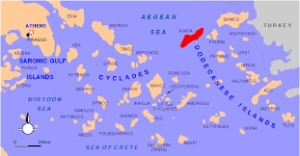
Map Showing Greek Island of Ikaria in Red
Convinced that he could produce a better product, John, his wife Sofia, and his sister Frosini got to work. They roasted beans in their kitchen and gradually improvised their own blend. Carrying 40-pound bags of coffee on the subway, he and Sofia set out to sign up customers. His personal touch when visiting restaurants was a key to John’s success. “He used to hand out cigars to all the dishwashers, thinking that one day all these guys are going to own all of their own businesses, and I’m going to supply them coffee,” Alexandra related in the interview. He soon opened his own storefront business and the enterprise took off.
The family patriarch cut a distinguished figure. He was a dapper man, granddaughter Ann Vassilaros told Estiator, a Greek food trade publication. The merchant was “larger than life; always well dressed with a carnation in his lapel.”

Tin Sign Promoting Vassilaros Coffee
Vassilaros spotted an opening in the market for his coffee. Greek immigrants would soon be operating an increasing share of New York’s lunchrooms and other small eateries. Winning them over, he calculated, would be crucial to the success of his product. He began loaning money and coffee equipment to help existing and aspiring owners get on their feet. The businesses he assisted would naturally carry his brand. Many of the restaurants remained reliable customers for decades. “He was probably the cornerstone of the diner business,” his great granddaughter Stefanie Kasselakis Kyles told Aaron Elstein, a reporter for Crain’s New York Business.
The restaurant patron forged personal ties with his client’s families. Known affectionately as the “godfather” of the Greek diner industry, he was literally one to their owners’ children. So many children received his baptismal blessing, the story goes, that a trip from New York to Florida took six months: Stops had to be scheduled to tend to his flock.
The Vassilaros home became a place to nurture “relationships,” an important word in the family’s vocabulary. John’s wife and relatives prepared Sunday dinners to entertain his followers. “If you have an open house on Sunday, they cannot owe you money on Monday,” was her great grandfather’s precept, Stefanie observed in an interview with the National Herald, a paper aimed at the Greek community.
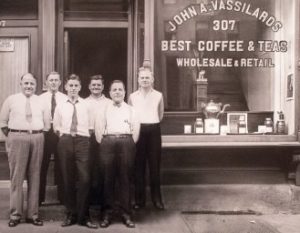
The First Vassilaros Storefront in NYC
Ethnic ties bolstered the new enterprise. John sponsored newcomers from Greece, Erin Meister, the author of New York City Coffee: A Caffeinated History, noted. Company employees took pride in their birthplace. “Our families are from Ikaria,” former salesman John Joseph Papalas introduced himself and his partner Gianni Pastis to the Queens Gazette. Mr. Vassilaros was the founder of the Pan-Icarian Brotherhood, a society of islanders from his homeland. The first Icarian clubhouse in New York City was located in the 3rd Avenue building that the company owned. Generous philanthropists, the family donated money to benefit their Ikarian compatriots. Their donations built the island’s first hospital.
These connections were good for business. In an interview with the Queens Gazette, writer Catherine Tsounis explained why her father, a Queens luncheonette owner, was loyal to the Vassilaros brand: “I use Vassilaros coffee from my patrioti John.” George Vlassios Tsounis hailed from Lemnos, an island close to Ikaria.
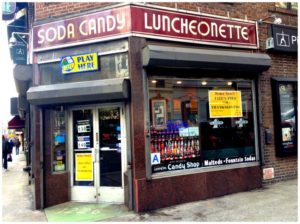
New York’s Greek-Owned Lexington Candy Shop Serves Vassilaros Coffee
John’s son, Adonis, expanded the family coffee business. Its headquarters moved to Queens, a large multi-ethnic borough with a sizable Greek community. Vassilaros started churning out coffee from a modern roasting plant, 25,000 square feet. Adonis carried on the firm with the same no-nonsense attitude as his father did. His attraction to the business was simple, Stefanie Kasselakis Kyles put it in the National Herald interview. “There are thousands of restaurants in New York,” she remembered him saying. “If you think of something to sell them for a few hundred dollars a week, you’re going to make a lot of money.”
John, the “mayoral candidate,” took the reins of the company from his father in 1972. The third generation president was a forceful, innovative leader and one with a winning personality. He almost effortlessly courted potential customers. “I’ve been a salesman all my life,” he remarked to Sara Costello from The New York Times. His technique—walk behind the counter and brew the coffee for his prospective client to sample. “The trick to selling is don’t talk too much. . . . Just let them taste it.” “Johnny” didn’t idolize coffee, as was increasingly the fashion. “Everyone’s so serious about the pour,” he told Costello. “Save your money and put down a payment on a house.” In the same spirit, his buddy, comedian Black, praised Vassilaros’ drink as “not a hipster’s cup of coffee.”
John was not afraid to visit competitors and strike up conversations. He did just that with Donald Schoenholt, president of Gillies Coffee Company, the country’s oldest roaster and wholesaler operating today. The businessman became an admirer. During his “campaign,” Schoenholt called John and promised his vote. The candidate thanked him and reminded Donald that he lived in Nassau County, Long Island, not New York City.
Mr. Schoenholt, the first president of the Specialty Coffee Association of America and a keen observer of New York’s coffee landscape, marveled at the visible signs of the Vassilaros success story. He envied its fleet of 15-16 trucks plying their sales routes. The Vassilaros roasting operation impressed him. Throughout the city, he said, lunch carts all seemed to be vending Vassilaros coffee, a tribute to the helping hand the veteran business had extended them. Johnny, Donald felt, lived and breathed his product. He had “ground coffee under his fingernails.”
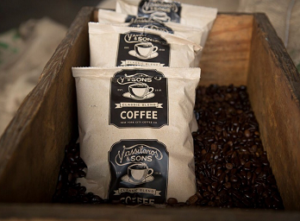
Bags of Vassilaros Coffee
New waves of immigrants revitalized the Greek food business, bringing in potential new recruits. The lifting of government restrictions on immigration opened the door to 70,000 Greeks between 1945 and 1965. Some arrived in unconventional ways. Over 80,000 jumped ship in American ports between 1957 and 1974, sociologist Charles Moskos notes. When the newcomers took the helm of New York City’s diners and coffee shops (kind of mini-diners), Vassilaros’ early foothold in the industry gave the company an advantage in selling its product.
Risk takers, like Peter Zanikos, a fisherman’s son from the island of Kyos, typified the new breed of diner operators. He started as a seaman making $30 a month. “As soon as the boat comes to America, I jump off,” he said in One on Every Corner, a film directed by Doreen Moses and Andrea Hull. “I jump off like crazy.” In the early 1960s, he took a job washing dishes and ultimately saved enough money to buy his own coffee shop. From this building block, he assembled the Argo restaurant group, which at its peak consisted of 12 shops. For Zanikos, establishing a restaurant was a matter of pride: “So I told my wife. You’re going to help me. I want to be somebody. I’m tired to be poor.” Through the new immigration law, he sponsored his mother, sister, and two brothers “from the other side.” He installed his kin in the businesses and crowed about his achievement. “These people 90 percent is here because of me.”
From lunch carts and hot dog stands, the immigrants climbed the ladder to short order grills and luncheonettes. From “starter diners,” Harold Kullman, a New Jersey diner builder pointed out, they graduated to larger, more spacious establishments. In their heyday, diners were an irresistible bargain, Kullman observed. “When I started, diners were sold by the running foot, like boats,” he told journalist Peter Genovese. “For sixteen thousand dollars, you could buy a diner.”
The success of Greek immigrants in the diner trade was contagious. New arrivals were eager to follow their example. Owners provided jobs to friends and relations. Lowly dining jobs, as dishwashers and countermen, were stepping stones to better paying positions. “I can’t tell you the number of times the dishwasher ends up owning the place,” diner consultant Richard Gutman remarked.
The eateries catered to American tastes while downplaying the owners’ ethnic heritage. Moussaka, Greek salad, and rice pudding might be on the menu, but the mainstays were comfort foods like meat loaf, Salisbury steak, and liver and onions. “Where else do you go to get mashed potatoes and gravy?” asks George Vallianos, who ran the Elgin Diner in Camden, New Jersey. Over time, diners concocted more extensive, almost encyclopedic, multipage menus ranging from abundant breakfast items to pasta and seafood. No dish was too unusual for a diner to carry. “If you wanted to order an elephant,” coffee merchant Schoenholt quipped, “you could get it.” Always willing to oblige, operators were attuned to the changing favorites of their clientele. Blintzes might be included to appeal to Jewish regulars, or grits for Black customers homesick for Southern pleasures. Danny Pappas, a diner operator whose 14-page menu listed Irish sausages, Romanian tenderloin, Hawaiian chicken, and German potato salad among its 439 offerings, summed up the diner strategy: “We Greeks believe in volume. If somebody wants something, we don’t want to send them away,” he told The New York Times’ John Tierney.
Greek diners and coffee shops endeared themselves to the American public. A diner get together was a regular feature of the Seinfeld television show. The familiar clatter, rapid-fire order taking, and the wise cracking banter of these joints was parodied in popular culture. The Greek counterman’s patter—“Cheezborga, cheezborga, no Coke, Pepsi”—was featured on Saturday Night Live. The skit had updated an older lunch room chant, “Stamberry pie, peacha pie, happula pie, pinehappula pie,” in Chicago novelist Harry Petrakis’ rendition.
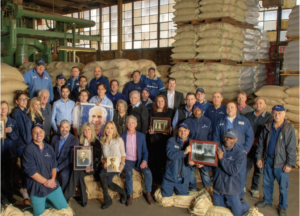
Celebration of 100 Years of Vassilaros & Sons Operation
A network of suppliers fed off the diner business. Wholesalers, many Greeks themselves, supplied the shops with baked goods, fish, paper products, and such vital accessories as the “show off” cases for displaying desserts. Like Vassilaros, these businesses were more than willing to lend the diners a hand. In the film by Doreen Moses and Andrea Hull, Marcos Kalogeros, owner of the Astro restaurant, reminisces about how wholesalers eased his way: “You go to the coffee man, he loan you 5,000 . . . the jukebox 5,000. You go put 1,000 down and you have your own restaurant.”
Vassilaros had hitched its fortunes to a booming market that is now eroding. The company’s major customers, diners and coffee shops, have been losing ground. Rents and operating costs are skyrocketing. Franchises like Dunkin’ Donuts are stealing customers. More and more, they were having trouble attracting a clientele with their something-for-everybody formula. “Halfway between fine dining and fast food,” reporter Aaron Elstein suggests, the diner didn’t fit neatly into an increasingly variegated industry. Customers were also searching for lighter, healthier repasts. Equally important, operators who were aging had no obvious successors. “The next generation has opportunities their parents and grandparents didn’t have,” Stefanie Kasselakis Kyles explained to Elstein.
Vassilaros & Sons, which had billed its brand as the everyday New Yorker’s cup of coffee, was now competing with purveyors of “specialty” products. Consumers were enticed by the tempting array of distinctive varieties available, coffee authority Meister points out. The new product was “not just coffee but something that was differentiated.” Its grade, unique aroma, national origin, and “free trade” commitment were now selling points. Vassilaros, an “ethnic-oriented” enterprise, as Schoenholt describes it, would have to break into unfamiliar terrain. His own company targeted “boutique hotels, specialty food stores, and white table cloth restaurants,” along with other select clients.
Vassilaros chief Stefanie Kasselakis Kyles closely followed these trends. A lawyer with a career in investment banking, Ms. Kyles took on a leadership role in the company after her Uncle John’s death in 2015. While acknowledging to the National Herald that “the Greek community was still a sentimental part of our business,” she was urging her firm to court more discerning customers. “Now there is a new appreciation for the bean,” the executive said in a web site interview. Savvy shoppers looked for “premium,” “quality,” “fine cup,” and “locally sourced brands.” John Moore, Vassilaros’s chief executive, echoed her views in an interview with EdibleLongIsland.com. “Millions of cups of coffee are consumed in the New York region, and yet barely anyone knows they’re drinking our coffee.” Besides “celebrating our past,” he emphasized the importance of “also looking to the future and changing how we look at the marketplace.”
A dilemma confronted the venerable coffee business. How can a company whose success was built on marketing a humble, anonymous product to diners refashion itself? Can Vassilaros acquire cachet and still retain its prized authenticity?
Meat Pies and Milk Shakes: Greek Cafés in Australia

Greeks Celebrate in Melbourne’s Australia Day Parade
The cafés in Australia were not serving gyros or tzatziki. In their heyday, between the mid-1930s and the late 1960s, they resembled the diners, coffee shops, and quick lunch places Greek immigrants established in the U.S. The Greek-owned eateries courted customers with steak and eggs and milk shakes. In the city or countryside, these gathering places offered up hospitality and familiar food.
Outsiders, Greeks and other Southern European newcomers, descended on a predominantly English culture. Their presence was jarring to locals, who were predominantly British. Australians remained British subjects until 1949 and fervently sang “God Save the Queen.” Along with the U.S., Australia was a favorite refuge for the Greeks. (Melbourne today boasts the largest Greek-speaking population outside Greece.) The immigrants had a proclivity for self-employment, especially in the food business—85% of first-generation Greeks, demographer Charles Price notes, landed in the catering trade, either as owners or employees.
The first significant wave of Greeks arrived in Australia during the Gold Rush, often jumping ship, just as many immigrants to America from their homeland did. In addition to mining, they worked as cane cutters, tobacco farmers, factory hands, and in other low-paying employment. The “Golden Greeks” of the 1850s-1890s soon tired of the “diggings” and looked for more entrepreneurial vocations. They opened stores, taverns, and small hotels to serve the miners. Driving through the minefields in horse and wagon, some hawked provisions.
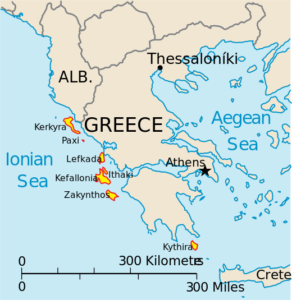
Map of Greece, with Island of Kythera at Bottom
By the 1870s, more voyagers from Greece were venturing to Australia. Many of them hailed from the island of Kythera, located between Crete and the southern tip of the Peloponnesus. For shepherds, farmers, and other young men struggling to eke out a living in this rugged land, Australia’s vibrant economy made it a magnet.
Athanasios Comino was one such wayfarer in search of a better chance. The son of a farmer, the Kytherian worked on a ship that in 1873 docked in Sydney. After injuring himself in a mining job, he began looking for another opportunity. After stopping to watch a Welsh shopkeeper dropping fish into boiling fat, the story goes, he imagined himself plying the same trade. Five years after arriving, he opened Sydney’s first Greek-owned fish business.
His success was contagious and other Greeks, many also from Kythera, took up the same trade. By 1911, 70 percent of the 400 Kytherians in New South Wales owned or worked in Sydney oyster shops, scholar Toni Risson reports. Their shops were modeled on the British oyster saloons or parlors, which served beer and shellfish to largely male punters. In the beginning, the unseasoned merchants stumbled while learning the ropes. For an order of fried oysters, it is said, Comino’s shop served them still in their shells. Although oysters, fresh, fried, or bottled, were their main fare, the Greeks added fruit and candy to lure customers. Restless salesmen, they were already eager to expand their commercial horizons.
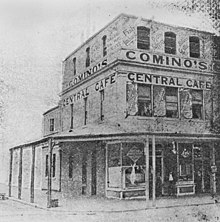
Comino’s Cafe in Brisbane
For fledgling eateries with little capital, oysters—cheap and abundant in Australia—were a tempting product. In the 1890s, they sold for six pence a dozen. “In island towns, you could get fresh Sydney rock oysters,” historian Risson writes. “I believe it was the job of porters along the rail line to keep them wet.” Farming their own oysters, the Comino brothers expanded their mini empire. The immigrants had found a niche. “If there is a single word which summarized the lives of most Greeks in Australia early in the 20th Century, it is shop keeping,” historian Hugh Gilchrist points out.
The success of the “oyster kings,” as Athanasios and his brother Ioannis were dubbed, turned Comino into a brand name. Newcomers adopted it for their business, even if they were not kin. The brothers sponsored other islanders to join their employ. As they gained experience, the recruits often left to build their own enterprises.
The hired hands were mostly young and single. Their families in Kythera pushed them out of their nests to seek their livelihoods abroad. Their destination was typically a kinsman’s shop, where they might board in an upstairs room. In an interview with writers Effy Alexakis and Leonard Janiszewski, Anthony Flaskas recalled a typical migrant story: “The old people [my parents on Kythera] … they were very, very poor…. They pick Australia…. It was a new country and you had more chances. Came with six boys and an old man in [acting as chaperone on the way out]…. I’d never been outside Kythera…. Well, the old man [my father] he sent me here and I had to obey…. He mortgaged his home [to pay for my passage.]”
In order to get ahead, the prospects had to suffer through an arduous and cruel regime. One café worker, Panayiotis Aronis, who spoke no English, arrived In Sydney with three gold sovereigns in his pocket. His brother took the 15-year-old on in his fish shop. Panayiotis “worked from 7:00 a.m. to midnight, six days a week, and on Sundays, when the shop closed, he would scrub the floors and clean the furniture until 3:00 p.m., when he would take his lunch and fall into bed,” historian Gilchrist recounts. “In the evenings, all would be peaceful until 11 o’clock, when the hotels closed and the drunks came in; some louts would put salt in the sugar or refuse to pay for meals, and there would be angry arguments and sometimes damage to the shops.” Panayiotis spoke of his hardship: “We were slaves.” Looking back, he had mellowed. “I began to forget my troubled past and took Australia to my heart, determined to make it my own country and that of my descendants.”

Manual for newly arrived Greeks, entitled “Life in Australia”
A primer for greenhorns financed by John Comino, Life in Australia, advised immigrants on the hurdles they would face. The handbook, ten thousand copies of which were distributed free throughout Greece, warned of rosy hopes that dinner will “fall ready-cooked out of the sky.” It also cautioned, according to one summary, “even to think of migrating without understanding the need for hard work, willpower and persistence was ‘an act of suicide.’” Special care should also be taken not to offend their hosts: “Raising your voice, banging your hand on the table, making gestures, forming groups in the streets, impertinence, scruffy dress are, for the Australians, something strange and unattractive. Such habits are disliked and, anyway, belong to uncivilized peoples.”
From oyster saloons and fish shops, the immigrants moved on to the café business. Cafés serving basic meals spread out throughout the country. Open from early morning to late in the evening, they featured hearty, unadorned, and inexpensive food that catered to Australian tastes. The mixed grill, a stick-to-the-ribs meaty affair—steak, lamb chops, sausages, bacon, two fried eggs, and a grilled tomato—was a café fixture. The “old country tucker” included such items as roast chicken, Irish stew, meat pies, pork fillet, and toasted sandwiches.
Starting in the cities, the eateries spread out to country towns. Word-of-mouth advice from fellow countrymen about opportunities in new places enticed owners to pull up stakes. Gossip in the kaffenia, Greek coffee houses, was a fertile source of tips. Railroad lines pushed into the Australian interior and the entrepreneurs followed them.
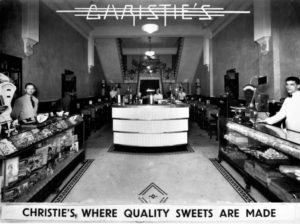
Christie’s Milk Bar, Brisbane
Country cafés were a haven for farm families visiting town for a shopping expedition or for a respite from the daily grind. In a hard-bitten society, they offered a convivial oasis. There were few other outlets in these communities for those in search of a convenient, filling meal. In a conversation with authors Alexakis and Janiszewski, historian Mervyn Campbell captures their vital role: “Many a time you would have gone hungry at night if it hadn’t been for a Greek café. You’d get into a country town after the hotel or dining room had closed and you’d have nowhere to go for a meal. But there was always a Greek ready to serve you a mixed grill…. They’d be open in country towns at seven o’clock in the morning and closing at midnight…. You could have a feed and meet your mates or take your girl for a date.”
The Greeks, a gregarious people, changed the dining culture of Australia. The eating places were imbued with the social atmosphere distinctive to their country’s tavernas. Their cafés “welcomed families from all social strata,” Alexakis and Janiszewski point out: “In Australia, nineteenth century public eating houses were ‘generally’ exclusive, divisions occurring along socio-economic class and/or gender lines—there were well-to-do restaurants usually providing French cuisine, frequented by middle- and upper-class patrons, or drinking and eating establishments with a male working-class clientele.”
For all the affection their patrons offered them, the owners still suffered ethnic taunts. They were tarred as “dagoes.” His family, who owned a café, were called “greasy spoon dagoes,” Peter Veneris recalls. On some non-Greek restaurants, historian Risson points out, signs said, “Shop here before the Day Goes.” To avoid being ostracized, owners sometimes put up posters proclaiming that they were “British subjects.” Although many chose Greek names for their businesses, others were more wary. Cafés were called Britannia, Royal, Empire, and Regal. Greeks also anglicized their names. One merchant, Ioannis Varipatis, became Jack Patty. Customers had nothing to fear from their cafés, owners proclaimed. They promised “cleanliness, civility, quick service.”
Antagonism might explode in violent attacks on foreigners. During the Depression, two days of riots on June 29 and June 30, 1934, targeted Greek-owned cafés, hotels, and homes. Officials gave their blessing to the popular suspicion of the immigrants. In 1928, the Prime Minister of West Australia tagged the Greeks as “that fish and chips crowd.” The immigrants were victims of what the government unapologetically called the “White Australia Policy.”
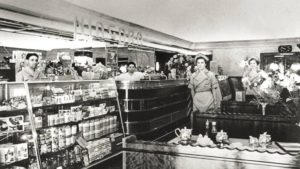
The Niagara Cafe in Gundagai
The hostility spurred the Greeks to embark on the commercial path to success. Shut out of other occupations, they turned to restaurant jobs. “Oh no, Greeks were certainly not allowed to work in factories—you had to work in cafés as cooks or waiters,” Angelo Raftos, who took a job in his uncle’s Sydney café, remarked.
The racial animosity encouraged the newcomers to huddle together, even more than they might have otherwise. The proprietor and his family lived a compartmentalized existence. There was the world of the shop, the long hours spent bowing to the needs and sometimes the whims of their customers. But at home, Greeks managed to create an alternative space of traditional pleasures and entertainment to revel in. Lex Marinos, whose family ran a café in Sydney, described their hidden life to Alexakis and Janiszewski. On Sunday nights, families would gather for jubilant evening at one of their cafés.
“The tables would be pushed back to create some space for dancing. A gramophone would materialize as would a collection of 78s…. Bouncy pop songs and mournful Rembetika [Greek blues]. Komboloi (worry beads) would spin back and forth around chunky fingers. Cards and backgammon….
“And then there was the food. Lamb baked with garlic and oregano. Cabbage rolls. Spinach and beans in olive oil and lemon juice. Fetta. Yoghurt. Rice. Pasta. Sticky sweets. Sugar-coated almonds.”
Because of their fears of rejection, café owners hesitated to share Greek dishes with their customers until the late 1960s and ’70s. “We sold steak and eggs and mixed grills, but never Greek food,” merchant Angelo Pippos remarked. “I tried introducing Greek food a couple of times but people didn’t like it.” Their cuisine, Alexakis and Janiszewski observed, was regarded as “foreign” and as “peasant” food. “Greeks have been eating their own behind closed doors since the 1850s.”
The Anglicized Greek café was refashioned with materials from American popular culture. A new hybrid, a marriage of mixed grills and milk shakes, was born. The Greek businesses, even the oyster saloons, installed soda fountains and ice cream bars. Shops with names like Niagara, Golden Gate, and New York prepared the ingenious menus.
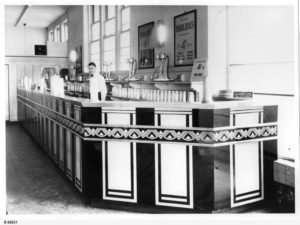
Interior of a Greek milk bar in Adelaide
Greeks in Australia, many of whom had visited the U.S., had relatives there, or had worked in American food businesses, were fascinated with the drug store soda fountain and its creamy and syrupy refreshments. Mick Adams (born Joachin Tavlarides) pioneered the milk bar trend. The budding entrepreneur, who had traveled in the U.S., was taken with the stand-up soda fountains he had seen there. What a perfect complement to the table trade, he figured. He was thrilled by its potential for quick turnaround service.
In November 1932, Adams launched the Black and White Milk Bar, the first in what would be a chain of cafés. A savvy promoter, he invited Lord Mayors to his opening. Five thousand customers, Alexakis and Janiszewski estimated, thronged his establishment on its first day. The crowd was so big that the police were forced to close the road to traffic.
Adams shrewdly marketed his product as a “health food.” Originally prepared with milk, the shake only later added ice cream. Other novelties were also on offer at milk bars. Spiders (ice cream sodas) and fizzy drinks infused with pineapple, lime juice, sarsaparilla, and bananas, were favorites. The businesses enhanced their appeal by making their own syrups and using fresh fruit in the confections.
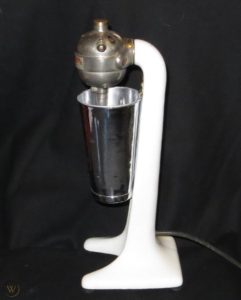
Hamilton Beach milk shake mixer
American know-how revolutionized the milk bar. Adams, a fan of American soda fountain technology, led the way in introducing compressors, pumps, and other machines. The electric Hamilton Beach milk shake maker was an early American import.
The milk bar craze exploded. By the end of 1937, Alexakis and Janiszewski point out, 4,000 milk bars had opened. Alluring sundaes with an American style highlighted the menus. The American Beauty featured a tall glass layered with fruit salad, ice cream, and wafers. Ice cream at the cafés imitated the American sweet’s hallmark smooth and creamy textures and sweet taste.
The allure of American refreshments attracted customers. “Soda water bubbled and hissed into tall glasses with flavoring and ice,” Maria Cominos, who ran a café with her husband, remarks. “Sometimes it was topped with ice cream…. [soda fountains] attracted people from miles around because they were new, they were American, they (soda drinks) were affordable, and only we had them.”
British boiled sweets and lollies were replaced with milk chocolate and hard sugar candies. The shops made many of their own items. (In Chicago, the capital of the Greek immigrant candy business, ice cream was frequently a staple of the candy stores. The Dove bar was conceived in a small Greek-owned candy shop in that city.) The Greek café in Australia stood out, with its window displays of chocolate bars, sugar candies, other sweets, and inviting fruit.
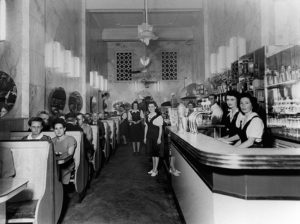
Art Deco counter at Australian milk bar
The café decor had a Hollywood sheen. Art deco designs, often with a California motif, lent glitz and glamour to the interiors. The owner of the Niagara Café, Jack Castrission, described its lavish display: “ … all coloured glass and shiny metal surfaces, large reflective mirrors, polished marble,… a domed ceiling design filled with stars and the night sky…. It was a pleasure palace, and the locals loved it.” The cafés conveyed a mythic image of a faraway land. “Selling a dream,” Alekakis and Janiszewski contend, the cafés were “to a degree, a ‘Trojan horse’ for Americanization.”
The milk bars were hangouts for Australian youth. By the early 1950s, jukeboxes began appearing. They pulsed with tunes from Bill Haley and the Comets and other early American rock bands. Dress and hairstyles often mimicked American fads. Teenagers could dance, gorge on ice cream sundaes, and soon bite down on another American import—the hamburger.
The cinema and the milk bar business were intertwined. Often located near the town cinema or selling refreshments from a counter inside, the cafés depended on the movie trade: “It was a meeting place for young people … a real money spinner,” Julie Canaris described her parents’ milk bar that sat next to a movie theater in the city of Darwin. “It had ice creams…. We also sold milk shakes, lemon and orange squash, scorched almonds, cherry ripes, boxed chocolates, cigarettes, and tobacco…. Our main aim was to serve as many customers as possible during the interval.”
Australia’s Greek cafés have in recent years lost favor as their clients’ tastes changed. The sit-down meal trade lost out to the take-out culture. Both owners and patrons were aging. Television viewing was also weakening the pull of both cafes and their movie theatre partners.
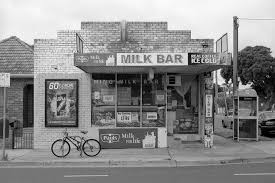
Milk bar in Melbourne
Besha Rodell, a New York Times writer, remembers the milk bars as a “third place,” “one part corner store, one part candy shop, and sometimes a deli or news agent or neighborhood social club.” Revisiting Melbourne, where she grew up, she was saddened by the disappearance of the business where she experienced her “first taste of consumer lust.” Convenience stores and supermarkets, once prohibited from selling on Sundays and even Saturdays, were supplanting the venues of her youth. She spotted the “ghosts of milk bars, which have been replaced by colorless shops, residences, and wine bars.”
There were other forces undermining the café. The children of the shops’ founders were often reluctant to follow in their parents’ footsteps. “There wasn’t the natural passing on of the café to the kids,” café historian Risson explains. “They became doctors, lawyers, pharmacists, and accountants.” Moreover, the shops, she says, were a stepping stone for the pioneers. “They were never meant to be forever. They were a way of forging a new life.” Similarly, many of the children of Greek diner owners in the U.S. have forsaken its backbreaking toil for white collar professions.
Cafés and milk bars may be fading, but their legacy is enduring. Many Australians still remember fondly the cries of “I’ll meet you at the Greeks.”
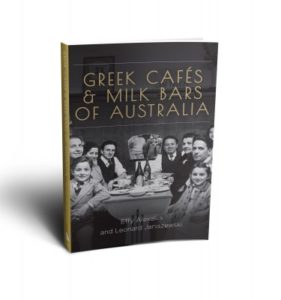
Greek Cafes & Milk Bars: book cover
Note: Greek Cafés & Milk Bars of Australia, a book by Effy Alexakis and Leonard Janiszewski, was a discovery for me. For a writer who had chronicled America’s Greek food business, it was a revelation. The volume, a gold mine of material, was invaluable. Unless otherwise identified, quotations are from this book.
Hibiscus on My Mind: Notes from the Pleasant Pops Café
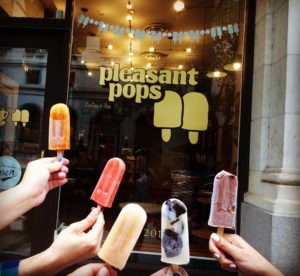
Some of the popsicles offered by Pleasant Pops
Parents pushing strollers, mothers and fathers with their kids in tow, young professionals, students, and neighborhood youth stand in line outside the Florida Avenue café in Washington, DC. Many are lured by Pleasant Pops’ trademark popsicles, which come in inventive, even exotic, flavors. Watermelon Guava Lime, Mexican Chocolate, Strawberry Ginger Lemonade are just a few of the temptations. These iced treats, modeled after the similar Mexican paleta, remind me how pedestrian the orange creamsicle of my youth was. Some are overwhelmed by the choices. Others have made up their minds. A youngster asked by his father what he wanted answered without hesitation, “Blueberry Pancake.”
The customers represent an array of nationalities—Chinese, Indian, French, Bangladeshi, Filipino. Couples often hail from different cultures. One afternoon, I struck up a conversation with two young economists who work for the World Bank. One was from Spain, the other from Kazakhstan. A woman waiting for her order of avocado toast lives across from the shop on Seaton Street and does consulting for the Labor Department. She loves her rental but fears, if she wanted to buy a house, being priced out of DC.

L to R: Nadia Bartholomew, Jordan Tapley, Selina Northey, and Afua Owusu
The young entrepreneurial women who own the business are a diverse lot. Employees before they became proprietors, they have already served their apprenticeship. Nadia Bartholomew, Jordan Tapley, and Afua Owusu come from multi-cultural backgrounds that are emblematic of their enterprise. Nadia’s family has roots in the Caribbean island of Aruba. Nadia, like co-owner Jordan, an African-American who grew up on Long Island, studied at Howard University. Afua’s parents are immigrants from Ghana who work in the health care field. The three are immensely proud of their achievement: A sign on the window proclaims, “100% Black-Owned Business.”

President Obama, with daughters Sasha and Malia, visits Pleasant Pops
Pleasant Pops, a short walk from the intersection of 18th Street and Florida Avenue, is located in a neighborhood I only vaguely recalled from my early days in Washington in the late sixties. Two friends, fellow graduate students from Antioch, lived on Seaton Street, where the aforementioned consultant resides. I bought African dance records from a shop on Florida Avenue run by a disc jockey from Sierra Leone. The street, once off the beaten track, is more alive and is abuzz with new commerce and pedestrian traffic. A training center for the firm Counter Culture, from which Pleasant Pops buys its coffee, is next door. (A visit from President Obama and his two daughters in 2015 gave Pops cachet.)
The surrounding neighborhood has drawn a new population, many from international backgrounds, attracted by the excitement of inner city living. Another asset, parents tell me, is the proximity of the Marie Reed Elementary School, whose program is in high demand. The school sits near the home of its predecessor, the Morgan Community School. Morgan, where my Seaton Street friends taught, was run for several years as a rebellious, experimental school under the auspices of Antioch College.
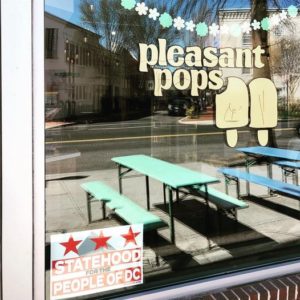
Picnic tables on the sidewalk in front of Pleasant Pops
At Pleasant Pops, the owners are continually experimenting and improvising. Salads like the Naked Burrito Bowl and the Mediterranean Bowl beckon. A recent popsicle that Nadia conceived was a blend of coconut water and tropical fruits like pineapple and mango. The women have an easy familiarity with spices and herbs less common in my era. Their Golden Latte, one of a variety of specialized drinks, is flavored with turmeric and a coconut-ginger spice blend. A lemonade and a latte are redolent with cardamom, another favorite spice. A new dish on the menu provoked me to uncover its story: The piquant coconut curry soup only made sense to me when I learned a mysterious ingredient—roasted sweet potato.

Racks of popsicles await customers
Hibiscus was a favorite of the owners. Jordan, who had traveled in Mexico, recalls the “refreshing, fruity tea.” Their customers could savor hibiscus-pomegranate or hibiscus-peach popsicles and an iced tea that had the tang of lime and brilliant crimson color of the tropical flowers. For some patrons, the items were puzzling. One woman, nibbling on a hibiscus-peach popsicle, wondered how the fruit’s soft orange color could impart such a vivid hue.
She was not alone. Hibiscus is still a novelty for culinary adventurers. The variety used by Pleasant Pops is different from the ornamental flower most are familiar with. I had been exploring the flower over many years in my investigations of ethnic food. It came with different names—sorrel and karkade (prounounced kar-keh-day) are just two—and flourished in a variety of cultures, which were often unaware of its presence elsewhere. I was frequently digging up new nuggets about the plant. Here was an opportunity to reawaken my interest and to examine the twist a new generation had given it.
I started to retrace my own journey. I first encountered the hibiscus drink during my initiation into Caribbean cooking. The Islander Restaurant, a Trinidadian eatery originally on DC’s Sherman Avenue and run by the ebullient Addie Green, offered it as one of their juices, which included ginger beer and mauby, a slightly bitter drink made from the bark of a West Indian tree. Sorrel was the name given to the tart, scarlet-colored drink with a sweet edge. Its taste, West Indians felt, resembled the lemony flavor of the leaves of sorrel plants. The little knowledge I had acquired, though, gave me a false sense of certainty. The story was just beginning.
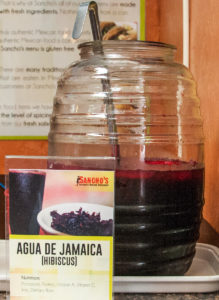
A jug of agua de jamaica
In later years, I stumbled on another piece of the puzzle. At the Tacqueria Distrito Federal in Washington’s Columbia Heights neighborhood, a cooler of jamaica (pronounced huh-mike-uh), the Mexican word for the hibiscus drink, stood on the counter, along with jugs of horchata and tamarindo. Jamaica is one of the aguas frescas, fresh waters, dear to the Mexicans. The name evoked the island where the drink was the toast of festive occasions. In Jamaica, where it was first planted in the early 18th Century, sorrel punch, fragrant with cinnamon and cloves, was essential to Christmas celebrations. Although now available year round, the plant was originally a holiday fixture because it ripened during that season.
Michelle Rousseau, co-author with her sister of a book on Caribbean food, speaks nostalgically of sorrel. “It has notes of warmth, Christmas and of being around people that you love,” she told writer Andrea Y. Henderson. Immigrants carried their fondness for hibiscus to the U.S. Street vendors sold sorrel during Christmas in New York City, historian Adrian Miller found.

The flower of the hibiscus sabdariffa
The range of hibiscus was wider than the Caribbean. It had deep ties to Africa and the Middle East. “The pharaohs used to drink it a lot,” Hassan Aziz, a counterman at the Jolt ’N Bolt coffee house in the District’s Adams Morgan neighborhood, told me. He was effusing about the glories of karkade, the Arabic word for hibiscus. The plant thrives in the blazing heat of upper Egypt, in Aswan and Luxor, the region near the border with Sudan.
When we first talked, my confidante stressed the hot hibiscus drink, not the cooler tonic I knew. He made a large glass of the steaming burgundy-colored tea. Its tart intensity was pleasing. The tea strainer bled vividly on my napkin.
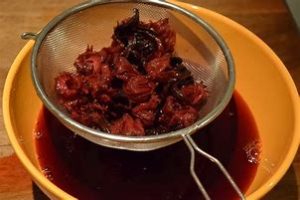
Hibiscus calyces used for making tea
Hot tea, Hassan remarked, was an antidote to warm, sticky weather. Despite the warning of doctors against drinking iced tea in the heat, Egyptians relished chilled karkadeh on torrid days. The sociable refreshment was enjoyed in cafés and tea houses.
Hassan spun more hibiscus lore. Invoking a perhaps legendary past, he recounted how the pharaohs had used the juice of the plant to dye the walls of temples. They liked it because of karkade’s “natural color.” In Egypt today, he remarked, families lay it out in sheets on their roofs to dry, “using the sun’s rays.”
The tea was also part of holiday rituals. “In the holy month of Ramadan all the families are serving this drink to break the fast,” Hassan pointed out.
My interest whetted, I was eager to gain a more detailed understanding. From which part of the plant was the drink extracted? My informants told me variously that the flower, the bud, or the leaf was the source of the ruby-colored punch.

Hibiscus Sabdariffa with calyces on the stem
It’s actually the calyx of the plant that is used to make the hibiscus drink. The calyx is the sheath in which the flower bud is wrapped. The red calyx becomes swollen, bursting with acidic juices. After it is dried, it is steeped in hot water and sweetened for tea or cooled for an invigorating drink.
There is no definitive history of hibiscus, but there are many suggestive theories about its origin. Hibiscus sabdariffa, its technical name, is a member of a large family that includes okra and cotton. Although the plant’s birthplace may have been in Southeast Asia, it was probably first cultivated in Western Sudan, says anthropologist G.P. Murdock. Hibiscus remains a vital export in Sudan’s economy. It arrived in the Americas from Africa with the slave trade, botanist P.M. Smith argues. Hibiscus reached Brazil in the 17th Century and then Jamaica in the 18th Century.
Spain may have been also an important jumping off point for the plant. The country’s Moorish conquerors are likely to have transported it there. The Spaniards, in turn, introduced hibiscus to Europe in the 12th Century. In France, hibiscus still carries the Arabic name, karkade. Spanish colonials possibly took it from Jamaica to Mexico.
I returned to my exploration and ventured to Khartoum, an early cultural outpost for Sudanese and Arabic food on Florida Avenue, not far from Pleasant Pops’ location today. Karkade and apricot juice coursed through the luncheonette’s jet spray machines. I sipped a hibiscus drink, or Sudan tea, as it is known. It was not as sour as I would have liked. But that probably didn’t matter to Khartoum’s patrons, for whom it brought back memories of more carefree days at home.
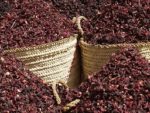
Dried hibiscus in an Aswan souk (market)
The Sudanese also prize the plant’s medicinal virtues, especially as a remedy for high blood pressure. The owner of the Khartoum Grocery, not far from the eatery, extolled his country’s “famous” product. He pulled a bag of dry calyces, a package of powdered tea, and a bottle of Scrumpy Hibiscus Tea, manufactured in Jamaica, from his shelves, crammed with Arabic wares. He touted karkade’s curative powers: “It can help with any problem in the chest. It can give you energy.” Food and drink for Mustafa were elixirs: “All of our things have two sides. One is taste. One is medicine.”
There was still another angle to this alluring flower. In conversations with West Africans, a new name for the hibiscus drink, bissap, kept popping up. It derived from the Wolof language of Senegal. A friend from the Ivory Coast, who also frequented Cosi, a coffee shop near my home, introduced it to me. Carrying containers of the drink with her, she wooed customers in the peddling tradition of her homeland. I bought a jug one day and found its tartness exhilarating.
At her recommendation, my wife, Peggy, two friends and I visited an Ivoirian eatery hidden away in suburban Langley Park. As we walked through the living room of the private home, we passed young Africans sitting watching videos. Our hostess, who had just been in New York searching for a choice guinea hen, served us a dinner of grilled chicken, fried plantains with a sauce of alloco, a fiery red chili sauce, and attiéké, a fermented grain. To cap it off, she presented us with a pitcher of bissap.
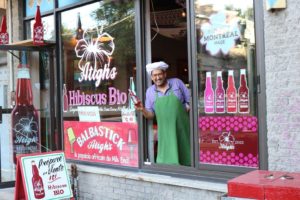
Mohammed Ould Atigh at the window of his Montreal restaurant
Across the border in Canada, I met an enterprising immigrant from Mauritania, who was dreaming up new ways of promoting hibiscus. Mohammed Ould Atigh designed his Montreal restaurant to convey the feel of the nomadic, desert country, which touched both West and North Africa. The ceiling was draped with pieces of cloth to look like a tent whose Arabic name, La Khaima, was the same as the restaurant’s. Low tables, cushions, and colorful North African fabrics created an exotic atmosphere. Atigh himself wore a blue turban. Harira soup, an orange-colored, peppery broth with lentils, pasta, and chickpeas, and a tagine, a Moroccan-style chicken stew accented with olives and sour lemons, were among the delicacies we savored. Bissap, a popular drink of his country, was poured from the side spout of a vase-like glass pitcher. Popsicles infused with hibiscus, Atigh commented, would be a nice supermarket item. He is now marketing both frozen hibiscus popsicles and bottling his own brand of hibiscus juices.

Assorted popsicle flavors
Back in Washington, the innovators at Pleasant Pops are probably conjuring up new menu ideas, perhaps tinkering with new ways of utilizing hibiscus. Maybe a hibiscus-flavored salad dressing?
Pleasant Pops, 1781 Florida Avenue, N.W., 202-558-5224
Speaking Frankly: Greeks and Hot Dogs
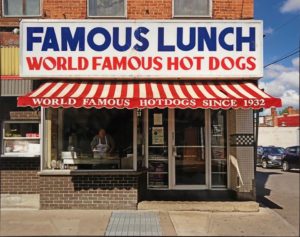
Troy, NY’s Famous Lunch
Mini hot dogs draped in “zippy sauce” entice customers to the Famous Lunch in downtown Troy, a once mighty upstate New York industrial town on the west bank of the Hudson River. The small eatery was founded as the Quick Lunch in 1932, in the midst of the Great Depression. Their signature hot dog comes with all the “works”: onions, mustard, and a pungent dressing. It’s is a “chewy meat sauce,” Scott Vasil, the latest member of this Greek clan to run the place, told me. One can only guess the secret behind the condiment’s flavor. Some may think it redolent of the old world, of Greece and the Ottoman Empire.
In addition to its Greek immigrant lineage, the shop has other ethnic connections. The three-inch franks were originally made for the business by the Troy Pork Store, a German butcher shop near the lunch counter. The hot dogs are nestled in miniature rolls custom-baked by Bella Napoli, a local Italian enterprise. The Famous sits in what food writer Robert Sietsema dubbed “Tiny Frankfurt Territory.” The area, in New York state’s Capital District near Albany, is home to several eateries showcasing this regional favorite. Traveling around the region, a shop window caught Sietsema’s eye. He was captivated by the sight of a “griddle with tiny hot dogs lined up like soldiers.” He had spotted the Famous Lunch Room.

Troy, NY, circa 1909
Once the country’s fourth largest city, Troy was fertile ground for the mini hot dog business. A prosperous manufacturing community in the 19th century, it competed with Pittsburgh and Buffalo in the production of iron and steel. The “collar city,” where the technique of making detachable collars and sleeves originated in 1840, was America’s leading maker of these products. Cluett, Peabody and Co., which would become Troy’s largest industrial company, manufactured the Arrow shirt there. By 1901, the city boasted 26 mills turning out collars, cuffs, and shirts.
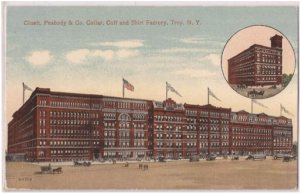
Cluett, Peabody Factory in Troy, NY
Hugging the banks of the Hudson River, factories thrived because of the large supply of sand, charcoal, iron ore, limestone and other raw materials. Troy’s plentiful resources facilitated the manufacturing of a host of metal goods. Nails, spokes, horseshoes, railroad iron, stoves, and bells were assembled in the early factories. During the Civil War, Troy concerns furnished horseshoes for the Union cavalry, plates for the ironclad ship, the Monitor, and clothing for the Union army. The Rensselaer Iron Works was the first American plant to use the efficient Bessemer process to make steel. Metal goods were not the only products manufactured in the factory city. At their height, Famous owner Scott Vasil notes, 19 breweries operated in Troy.
At the juncture of the Hudson and Mohawk Rivers, Troy had a strong advantage. Water powered early industries. The construction of the Erie Canal, with Troy at its terminus, provided the city with a cheaper and faster passageway for raw materials and manufactured goods. The town’s location was a major source of its allure for new businesses and job seekers. “Its rivers go all the way to Canada and New York City,” Scott said.
Burgeoning industry attracted an immigrant working class. The Dutch, English, and Scots led the way. A large Irish influx in the early 19th century supplied willing hands for both the collar and cuff factories. Irish women predominated in the apparel business. Kate Molloney, an Irish woman, organized the country’s first female union, the Collarworkers Union, in 1864. Helen of Troy, a 1923 Broadway musical written by George S. Kaufman and Marc Connelly, celebrated the women of the city’s collar shops.
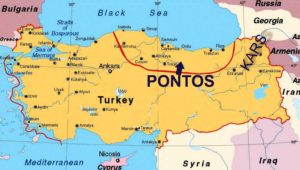
Map showing location of Pontos, a region in the Ottoman Empire where many Greeks lived
In the early 20th century, an influx of immigrants from southern and eastern Europe (Poles, Italians, Jews, Greeks) created a polyglot community. Fleeing harsh economic conditions and driven to improve their lot, the Greeks settled in Troy. A sizeable group of arrivals were refugees escaping brutal oppression by the Ottoman Turks in Asia Minor, the peninsula between the Black Sea and the Mediterranean. Starting in 1914 and culminating in 1922, the Turkish occupiers waged a campaign of persecution and violence against the large colony of Greeks in the region. Their objective, Scott Vasil’s uncle Edward Nicholas points out, was a simple one—to “kill Christians.” Those not slain were to be expelled. Nicholas grew up in Pontos, a Greek name for the area on the southern coast of the Black Sea. Edward, who still gathers with his compatriots in an ethnic society, found refuge in Troy. (Greeks from different regions clustered in different parts of New York State. Those from Peloponnesus, Edward said, were likely to put down roots in Schenectady.)
“Distrustful of government,” Edward’s daughter Despina Nicholas says, the outsiders turned inward, relying on each other to build a new home. In the early days, the Greeks huddled in boarding houses in this city of brick tenements. A kaffenion, the traditional coffee house, offered companionship and entertainment for the uprooted. Over time, immigrants married, formed families, and constructed a tight-knit community. At its height, Despina estimates, there were 200 Greek families in Troy. (In recent decades, many have moved to outlying areas.)
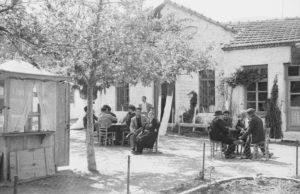
A traditional Greek kaffenion, or coffee house
The Greeks needed an anchor for their settlement. The Pontic emigres provided the “momentum,” Christina says, for founding a church. St. Basil Greek Orthodox Church was established in 1931. The church united the immigrants into a cohesive group, a kinotis. It still “glues the families together,” Scott Vasil says.
The immigrants had a difficult time assimilating. The Greeks, for example, were a “little more exotic” than the Italians, Despina observes. Since they also possessed their own distinct liturgy, the Greeks required their own place of worship. The Italians joined mainstream Catholic churches and hence became “more integrated into American society,” she notes.
Armed with their faith, the Greeks pushed ahead in search of a livelihood. For some, the flourishing factories of the “collar city” beckoned. An aunt of Scott’s found a job at Cluett, Peabody, the shirt collar firm. Troy’s real lure for Greeks, whatever jobs they had to take, was the opportunity the bustling urban economy provided for self-employment.
The new immigrants were particularly adept at creating small businesses. Perhaps the earliest to arrive, Despina Nicholas found from her research, was Tom Valis. Valis, who settled in Troy in 1905, found a room at an Irish boarding house. In 1911, he was joined by his brother and wife. Although many of the details of his career need to be filled in, Valis, Despina discovered, ran a shoeshine shop, an entryway for entrepreneurially minded Greeks all over the country. (A 1909 survey done of New York City bootblack parlors, cited by scholar Charles Moskos, found 151 Greek-owned shops in Manhattan.)
Newcomers established themselves in a wide range of fields. The sponsors of the celebration of Greek Independence at the St. Basil Church on April 19, 1942 included Greeks from the lunchroom, cafeteria, paint store, family restaurant, flower shop, milk delivery, candy store, and gas station businesses.
After stints operating a grocery store and a butcher shop, one enterprising Greek immigrant opened the Quick Lunch in Troy in 1932. Fearful of looming dangers, Chris Seamon, the great uncle of Scott Vasil, the present proprietor, left Pontos in the early 1900s and thus escaped the later massacres. Chris helped newcomers get on their feet, frequently offering them a place to bed down in his house.
The lunchroom, which was passed on through the extended Greek family to Chris’s nephews Steve and Nick Vasil in 1955, “still is very much working class,” Don Rittner, a historian of troy, told me. At its peak, Scott Vasil points out, the shop fed off the city’s commercial energy. “Congress Street was very busy,” Scott commented to writer Amy Halloran. “There was enough business for everybody to go around. Everybody was thriving. The city was real lively . . . you had work—factories, companies, everything was running three shifts, the steel mills, the breweries. You could support local businesseswe were open 24 hours a day.” (Scott took over the shop in 1995.)
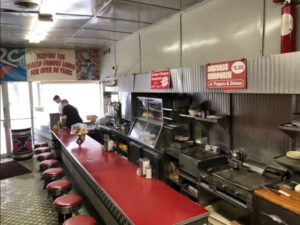
The counter at the Famous Lunch, Troy, NY
Even now, the Famous seems “frozen in time,” author Amy Halloran observes. Its counter stools, formica tables, and booths are a throwback to a simpler, more down-to-earth era. The “walls are still lined in shiny enameled steel,” Halloran observed in an admiring piece. An “eye opener” for Amy, who started going to the Famous in the early ’80s, the lunchroom was the “lair” of construction workers and other ordinary folks. They were bound together by the homey atmosphere and its “super cheap, super fast food.”
The Famous “defied the logic of target demographics,” Scott’s cousin Despina says. It “appealed to every generation, every socio-economic group.” The owners created a setting congenial to “lively political and intellectual debate,” she adds. One of the shop’s regulars, Fire Department Captain Robert Paul echoed her remarks: “I’ve been coming here for 35 years and me and Steve solve the world’s problems, do the Jumble in the newspaper, then talk about the headlines of the day,” he told Bob Gardiner of the Albany Times Union.
The Famous’s stock in trade is filling, American comfort food, and the owners have not tinkered with the fare. The only echo of Greece is the shop’s rice pudding. “Whatever I got at 19 was still on the menu,” Halloran remarks. Besides hot dogs, customers line up for breakfast items like omelettes, pancakes, and French toast.
Writer Rittner cherishes memories of eating there. “As a boy living across the street, I would run over to the Famous and wolf down 8 dogs, French fries, and a Canada Dry,” he writes. Just lingering in the shop heightened his enthusiasm: “I loved sitting in the booths. The wooden backs seemed to go up to the enameled steel ceiling. Each booth had a small ‘Juke Box’ connected to the main player that was sitting by the phone booth at the far end of the eatery. A quarter got you three plays, mostly Elvis. I would sit there for long periods of time, between bites, listening to the debates about everything under the sun.”
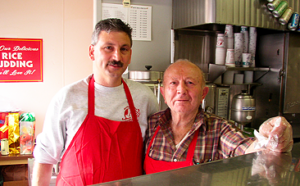
Scott Vasil (left) and father Steve, proprietors of Troy, NY’s Famous Lunch
The Quick Lunch became the Famous Lunch because of a marine stationed in Moscow who craved hot dogs from his hometown eatery. In 1958, Corporal Gordon Gundrum, based at the U.S. Embassy, planned “Operation Hot Dogs,” a mission to bring his favorite mini franks to Russia. The embassy arranged with Royal Dutch Airlines to fly in a few dozen hot dogs for the Ambassador’s 54th birthday. The story was picked up in the media, leading to cachet for the shop and its new name. The business was shocked one day when the Jay Leno show called ordering 250 mini dogs. (After initially thinking the phone call was a hoax, the Famous ended up filling the order.)
Why did mini dogs sprout in Troy? The story is murky. Asked about it by Chuck D’Imperio, the author of A Taste of Upstate New York, Scott Vasil replied: “I really don’t know,” he laughed. “I mean, they sure didn’t eat them in Greece. But for some reason many generations ago, several different Greek families showed up in this area and started the tradition.” All the shops had their own mixture of sauce, Scott’s uncle Edward Nicholas said: They vied with each other, but it was friendly competition, a “my sauce is better than yours” attitude, he added.
D’Imperio is an upstate New York writer, whose book includes a lively guide to these hot dog outposts. His interest in the Greek hot dog business was sparked by Johnny’s Hot Dogs, an Albany joint he “used to haunt” during his college days. The owner was a “big garrulous man with thick Coke-bottle glasses and a hard-to-pronounce Greek last name,” D’Imperio recalls. He was a “friendly-giant sort of guy, despite the small handgun peeking out of his waistband or hidden under the counter.” The shop sold mini dogs accented with a mysterious Greek sauce that filled a large vat. A former employee recounted the attractions of the “colorful place.” “Many of the older customers remembered Legs Diamond, the famous gangster who was shot around the corner at 67 Dove Street back in the 1930s. A couple of bookies frequented the restaurant, too, but as far as I could tell, never ate there.”
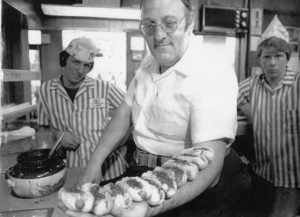
The “hairy arm” serve at Hot Dog Charlie’s in Troy, NY
The first stop on D’Imperio’s tour of mini hot dogs in the Collar City area is “Hot Dog Charlie’s.” Opened in 1922, the business paved the way for similar businesses. Founded by Strates Fentekes, a Greek immigrant, the shop was first called the New Way Lunch. Strates had earlier worked as a bootblack, the U.S. Census reports. He took the name Charlie, D’Imperio points out, because customers had difficulty pronouncing his name. A showman, Fentekes was famous for the “hairy arm serve,” D’Imperio relates. “He would line the mini dogs up in a row on his hairy Greek forearm and then slather them with all the fixings, one after another.” His technique, which other Greek merchants would duplicate, was ultimately banned by the Health Department. Charlie’s spawned more shops run by younger members of his family. Unlike the Famous, the chain adopted a more modern, streamlined look well suited for shopping center venues.
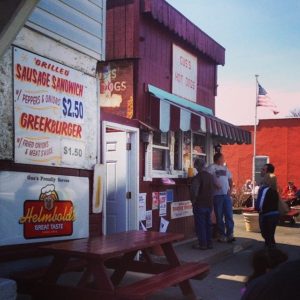
Gus’s Hotdogs, Watervliet, NY
Gus’s Hot Dogs, another purveyor of the mini frank, is more akin to a roadside stand than its fellow businesses. It was established in Watervliet, a town across the river from Troy, by another Greek entrepreneur, Gus Haita. The shop sells the “original” frank, garnished with its trademark meat sauce, from its window. Its menu now includes Greek burgers topped with that special sauce.
Writer Sietsema provides a colorful depiction of Gus’s, which he visited in 2013: “I’ll never forget the first time I went there in the dead of winter—the fry cooks were wearing bubble parkas and huddling together near the stove. The stove itself was just a giant rectangular griddle with a ridge around it, which filled up with grease as the day progressed, proving the perfect medium to cook hot dogs and hamburgers.”
The story of Troy’s lunchrooms is bound up with the larger saga of Greek immigrant life in America. Between 1900 and 1920, there was a surge of newcomers. During that time, 400,000 Greeks arrived in the U.S. Although waves of Greeks streamed into factory towns to labor in steel mills, shoe factories, textile mills, and on railroad gangs, for many, these jobs were simply way stations. Greeks grew restless with the workplace regimen and bridled at working for a boss. Self-employment was the answer. Peddling fruits, working for a kinsman in a shoeshine business, or selling flowers were common launching pads for budding entrepreneurs. The aspiring merchants also spotted an opening in the food business. The burgeoning workforce that thronged the cities hungered for quick, cheap food.
Greeks latched on to the hot dog trade to capture these potential customers. The hot dog, the product’s foremost historian, Bruce Kraig, argues, was a “uniquely American food,” on which successive groups of immigrants have put their stamp. German butchers and vendors marketed sausages in city neighborhoods as early as the mid-19th century. Other innovative ethnics like the Polish Jewish immigrant, Nathan Handwerker, also contributed. In 1916, he opened Nathan’s Famous in New York City’s Coney Island, a restaurant that popularized all beef hot dogs with a garlicky zing.
Savvy Greek vendors took to the streets to hawk their product. In early 20th century Chicago, the largest center of Greek immigrants, they sold “red hots” from carts and lunch wagons outside factory gates. The “pennies business,” might produce a healthy nest egg for future ventures or for investing back home. The Greeks had discovered a toehold from which to climb the economic ladder. The hot dog business, historian Bruce Kraig remarks in a posting from cbsnews.com, was a godsend for new Americans: “I mean, the immigrant experience, people came with no money at all. And you could buy, let’s say we’re talking about 1900, you could buy a sausage for a penny and the other accouterments for a penny and you sell it for a nickel. And that’s the way you move up in the world, and this was an American idea.”
From the hot dog stand, graduating to a lunchroom or even a restaurant was a sensible decision. A 1919 article in the Greek Star, a Chicago newspaper cited by scholar Charles Moskos, describes this route: “At that time the dinner pail was the emblem of the American workingman, and it seemed likely to continue to be so, because no one had thought of the idea of creating a restaurant to serve this man. Then the Greek came. He drove his lunch wagon at the noon hour to the factory district, and was popular from the start. Later he opened restaurants close to the factories, serving food at prices which appealed to the laborers, and eventually he won a reputation for himself.”
Soon, Greek-owned lunchrooms serving up hot dogs, pie, coffee, and other basic fare began springing up in industrial towns across the country. “Lunchrooms,” as they were commonly called, was an apt name. These no-frills places were forerunners of the Greek diners of the 1950s and 1960s that also catered to a blue collar crowd.
Fall River, a Massachusetts textile town, was an early lunchroom stronghold. Nick Pappas started Nick’s Coney Island Hot Wieners in 1920 to sell hot dogs with a spicy sauce. The Spindle City was tailor-made for shops commonly located outside factories. “In Fall River, the popularity of hot dogs began with the mills,” one Coney Island merchant told Parris Kellerman of the Standard Times. “People couldn’t afford a lot or to sit down for meals.”
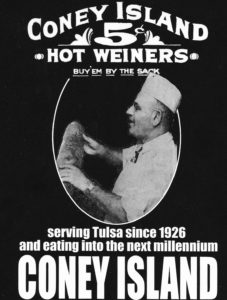
Coney Island Weiners, Tulsa, OK
The Coney Island Lunch, which opened in McKeesport, Pennsylvania, a steel town outside Pittsburgh, in 1919, was another such business. Christ Economou, an adventurous Greek, founded the shop, the first in a string of similar eateries he built. The family patriarch “followed the railroad tracks down the East Coast and opened 26 Coney Island shops—selling them to Greek immigrants so that they could also bring their families to America,” granddaughter-in-law Vicki Economou recounts in the business website. After a sojourn in Texas, Economou landed in Tulsa, Oklahoma and founded the Coney Island Hot Weiners in 1926. (The name was spelled this way because the owners used the unique spelling of wieners to retain their copyright.) His son, Jim, points to the basic principle for his father’s success with the 5¢ hot dog: “My father said that hot dogs were an easy food people could take in their hands and eat on the go,” he remarks to the Tulsa World.
The lunchrooms had a common drawing card, their hot dog sauce. Although the mixture may have been different in details, the fragrant topping was typically made with a blend of Greek spices. The seasoning was reminiscent of the flavoring used for the dishes pastitsio and moussaka. “They wanted to put an added value on their hot dog,” historian Kraig pointed out to Cody McDevittt of the Pittsburgh Gazette. “There weren’t a lot of toppings on hot dogs in those days. So the sauce, when you look at it, it is tomato based with spices like nutmeg and cinnamon.”
The sauce, which so many have tried to decipher, gave the product a mystique. Sam Contacos, whose grandfather founded the Coney Island Lunch in 1916 in Johnstown, another Pennsylvania industrial town, described the allure of its flavoring in an interview with the Daily American:
Sam Contacos laughs when he hears people claim to have the recipe for Coney Island’s famous chili. Truth is that no one knows it but him. His grandfather showed it to his father, who in turn taught it to Sam. The recipe is in a safe deposit box. Those three men are the only ones who ever knew what went into it.
“We’ve made it the same way for 100 years. . . . They let it cook for hours. Chili used to cook all day before it was finished. It’s not a product that you can make in a half-hour or two hours or three hours. You start it at 8 o’clock in the morning and finish it up at 7 o’clock the next morning. Then you clean the pots and start all over. All these fantastic recipes they have on the internet . . . sorry, not even close.”
Other tantalizing riddles surround the Greek hot dog trade. Why the name, coney, for example? A common explanation is that many future Greek merchants arriving in the U.S. went through Ellis Island and, during their stay in New York City, savored the hot dogs they ate on Coney Island. Perhaps for newcomers fearful of being branded as “foreigners,” the name carried a reassuring American feel. The guessing game will undoubtedly continue.
Whatever its origin, the name stuck. It was so infectious that Greeks who fanned out to the heartland often called their shops “Coney Islands.” George Margeas, who in 1918 launched Sioux Falls, Iowa’s first hot dog shop, named it the Coney Island Wiener House. He was thrilled to be selling America’s first “fast food,” according to one newspaper account.
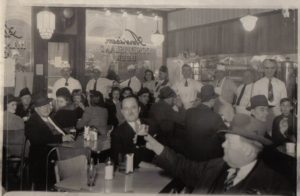
Customers at Detroit’s American Coney Island
Detroit, the mecca of the industry, is steeped in Coney Island folklore. Greeks (and also Macedonians) founded the hot dog trade in the motor city. In 1916, immigrant Constantine “Gust” Keros, who had been a shepherd in a small Greek town, landed a job sweeping floors at Detroit’s Kelsey Auto Plant. To make ends meet, he moved on, setting up a tiny street corner business. He sold popcorn, shined shoes, and cleaned hats, and, ultimately, hawked hot dogs from the same location. Keros opened a lunchroom, American Coney Island, in 1917. Seven years later, Gust and his brother William began operating another eatery, Lafayette Coney Island, side by side with the American. Their mainstay was the coney, a nickel hot dog slathered with a meaty sauce, fragrant with cinnamon and allspice. The factory town was ripe for the lunchroom business. “Coney Island lunch counters were supercharged in downtown Detroit in the 1920s,” Katherine Yung and Joe Grimm, authors of Coney Detroit, point out. “At that time, there were so many workers packed into the city that some had to rent rooms for just 8 hours a day—other workers rented the other hours. They had to grab lunch in a crowded hurry. Coney Islands, with your food and change in front of you in just a minute or so, were the answer.”
Coney Islands mushroomed in Detroit, as relatives and workers in the early shops left to open their own eateries. Neon signs announced these enterprises, which spread throughout the city. Aspiring merchants expanded the trade to Flint, Jackson, and other nearby communities. Their struggles paid off. “Coney Islands became their ticket to the American dream after years of hard work,” Yung and Grimm observe. Today, more recent immigrants—Albanians and Yemenis—have broken into the business.

Curtis’s Coney Island Famous Weiners, Cumberland, MD
The history of coney islands is replete with tall tales or perhaps just embellishments of early stories. Two Greek immigrants who learned the candy trade from a countryman in Johnstown, Pennsylvania moved to Cumberland, Maryland in 1905, the story goes, to open a candy and ice cream business. A Greek peddler from Texas, carrying a “little burner on his back,” sold them on a tempting idea. “He had a special sauce they could make money with,” Louis Giatras, the owner of the business, told me. After the partners sampled the sauce, they were persuaded and started making coney island hot dogs with it. The Coney Island Lunch, a combination short order food and candy, ice cream parlor, blossomed into the Coney Island Famous Wiener Company.
Ingenious Greek merchants continued to craft new variations on the coney. The hot Texas wiener, it is said, was dreamed up in the silk mill town of Paterson, New Jersey, in the 1920s. Its originator, an anonymous elderly Greek who operated a lunch counter in the city’s downtown, wanted to spice up his hot dog. Dabbling with different mixes, as folklorist Timothy Lloyd tells it, he seized on one, which resembled a “Greek spaghetti sauce.” The blend played chili and cumin off against cinnamon and allspice. Grills, as Paterson’s lunchrooms were called, imitated his formula. Their wieners were fried, put on a steamed bun, and then topped with successive layers of mustard, onions, chopped onions, and the fiery sauce. The shops, many located along the Passaic River near the mills, gradually added hamburgers, roast beef sandwiches, and BLTs to their fare. After that, “Texas wieners” headlined the menus of other Greek-owned restaurants across the country.
In Providence, Rhode Island, another marketing gimmick took hold. Countermen perform an “acrobatic show” known as “upd’ahm,” the Greek Chef blog writes. In the New York System, “they hold one arm out, line as many as a dozen buns from finger tips to shoulder, squeeze in the wiener (don’t call it a hot dog!), hit with the yellow mustard, spoon on the meat sauce (don’t call it chili!), place on chopped onions, and dust with celery salt.”
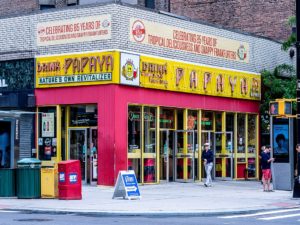
Original Papaya King, New York City
A young Greek immigrant in New York City, Constantine “Gus” Poulos, started a craze by pairing hot dogs and papaya juice. Poulos, who was introduced to papaya and other tropical juices on a vacation to Miami, hatched a plan. He began offering a papaya drink at his shop on 86th Street and 3rd Avenue in Manhattan. The early juice bar evolved into a business called Papaya King. Since his shop was in Yorkville, a large German enclave, Poulos added hot dogs to his menu. Other merchants followed suit and soon there were a plethora of imitators with names like Original Papaya and Prince of Papaya.
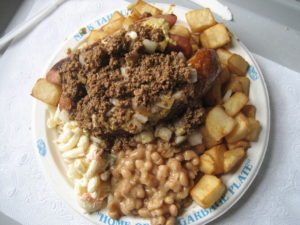
Red Hot Garbage Plate, Rochester, NY
In Rochester, New York, Greek immigrant Alex Tahou conjured up another hot dog dish whose fame would spread. In 1918, he opened a lunchroom in what was once the train station for the Buffalo, Rochester, and Pittsburgh Company. He called the shop West Main Texas Hots. During the Depression, Tahou started selling a workingman’s plate of “red” hots (standard franks) or “white” hots (a pale sausage like the German weisswurst sausage) topped with chili sauce over a bed of home fries. Spurred on by college students infatuated with the dish, new generations of the Greek family converted the “hots and po-tots” into the “garbage plate.” Customers could order a choice of meats and a myriad of sides, like baked beans and macaroni salad, with the dish. Inevitably, other area restaurants jazzed up their offerings with “dumpster plates,” “sloppy plates,” “trash plates,” and similar renditions.
The hot dog trade is just one example of the Greek affinity for the restaurant industry. Greek immigrants old and new have gravitated to a host of different food businesses, from lunchrooms, diners, and pizza shops to family dining venues, steakhouses, and seafood places. This proclivity was evident very early in the American Greek community. By 1913, sociologist Charles Moskos estimates, Greeks owned 600 eating establishments in Chicago, an immigrant hub. Their dominance scared suspicious Chicagoans, restaurant historian Jan Whitaker points out. They feared that the newcomers were “invading” the lunchroom trade. The adage, “When Greek meets Greek, they start a restaurant,” a popular saying by the end of World War I, was proving to be more than a cliché.
What accounts for the Greeks’ almost umbilical connection to the restaurant business? Over the years, as I’ve explored this question, I have encountered a variety of explanations. An early, playful comment came from Mario Christodoulides, the Greek Cypriot manager of a Queens, New York restaurant supply business. “When you first jump off the ship, the first thing you need is food. In order to eat, you have to work in a restaurant. You’re not going to start a plumbing business.” Perhaps it’s the Greek passion for food, their tradition of hospitality, that offers a clue, some surmise. Others speculate that the affection for the restaurant is rooted in memories of the old country’s kaffenion and taverna.
Their close-knit family, others suggest, is the bedrock of this ethnic business. Enlisting family members to work in the restaurant makes for trustworthy and industrious employees. Kinship connections stimulate a regular flow of workers to fill positions. Turning away needy relatives is “frowned upon,” Peter Scouras, owner of Buffalo’s Towne Restaurant, told Samantha Maziarz Christmann of the Buffalo News. “If your cousin comes over and you don’t give him a job, there’s something wrong with you.” Some of the recruits will learn the ropes and move on to start their own restaurants. Owners expect this. “When it’s time to go, it’s OK,” Pano Georgiadis, another Greek merchant commented to Christmann. “Nobody stays a cook forever.” Pano himself had left the Towne to found Pano’s restaurant. The seeds of future Greek eateries are sown in the old. As the cycle continues, restaurants multiply.
As I dug into the story of Troy’s Famous Lunchroom, I gained new insights into this Greek family niche. Her fellow ethnics are pervasive in the food world, Despina Nicholas, Scott’s cousin, told me. “Every Greek seems to have tried their hand in the restaurant business.” Her father Edward concurred, drawing on his own experience in and observations of the field. For Greeks new to America, “it’s one of the easiest businesses to get into.” The work is hard, but “if you can’t speak English, what job can you get?”
Steve Vasil, Scott’s father, saw his restaurant as the way to fulfill his immigrant dream. By working hard, he could not only send his kids to college, but also become an American. Steve was the “happiest man in the world” when he got his citizenship, Edward said. His lunch counter’s food reflected the same desire to belong. “I think he wanted to make something all American: Fast, delicious, and a good value,” Scott tells Saveur magazine’s Jamie Feldman.
Like many Greek merchants, Steve Vasil had a knack for identifying his customer’s tastes and catering to them. In the food world, Greek Americans stood out as purveyors of ample, familiar, and reasonably priced food. From lunchroom hot dogs to diner liver and onions, operators, especially in the early years, concentrated on the reassuring, rather than the exotic. As much as he loved his own cuisine, Steve was wary of offending his clientele by serving it. He “dared not open a place that sells Greek food,” Edward remarks.
The drive for economic independence, to be their own boss, impelled Steve, Scott, and so many other ambitious Greek ethnics. The restaurant business was their vehicle to do this. Even Scott, who received a degree in Industrial Engineering from Rensselaer Polytechnic Institute, decided to succeed his father in the lunchroom rather than cash in on his credential. He did not want to suffer the restrictions of “corporate America,” cousin Despina observes. Scott was the “sort of person who prefers to have control.” The continued strength of the Greek restaurant business will depend on how many of the new generation follow his path.
Thanks to:
Despina Nicholas was very helpful in providing material about the Famous and in giving me the benefit of her growing knowledge about the history of Troy’s Greek community. Despina generously gave me a copy of the listings of Greek business sponsors from the 1942 St. Basil’s Church celebration program.
Scott Vasil took time out to talk to me about the Famous business, its story, and about Troy.
Edward Nicholas shared his insights into the role of Greeks in the restaurant business and provided me an absorbing account of the Greek immigrant experience.
Don Rittner, a historian of Troy, introduced me to tales of the city and recounted intriguing anecdotes about the lunchroom he loved.
Amy Halloran, the author of the book, The New Bread Basket, and a food activist, offered rich memories of the Famous Lunch through her writing and our conversation.
Sinful Pleasures: Italians and Ice Cream in Scotland
“Is it not the case that young persons of both sexes hang about and loaf in the ice cream shops?” In a hearing before a Joint Parliamentary Committee on Sunday Trading in 1905, the Duke of Northumberland inquired about Glasgow’s growing number of Italian-owned businesses. By that year, more than 336 parlors were operating in Scotland’s largest city. A committee member worried that children were wasting their pennies on ice cream instead of putting them in “missionary boxes” in Sabbath school. Sunday selling of confections was causing consternation among upright Glaswegians. In a paper on “Ice Cream and Immorality,” presented in 1991 to the Oxford Symposium on Food and Cookery, Francis McKee detailed abundant evidence of the chilly reception the city’s elders gave this immigrant trade. Why did this refreshment, which was gaining popularity in the booming industrial city, arouse such horror? McKee offers some intriguing answers.
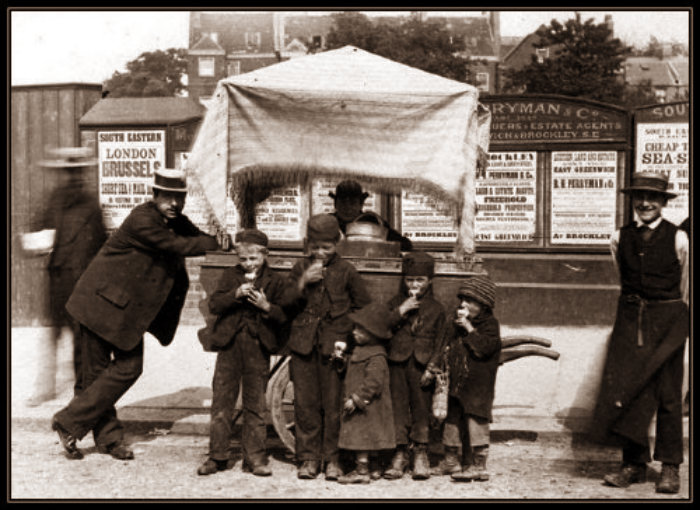
Hokey Pokey Men of Glasgow, 1907
From the 1880s to 1920, Italian immigrants were leaving struggling peasant conditions behind to better their lot in Scotland’s expanding economy. The newcomers, like those in other parts of Great Britain, came from particular regions of Italy. The settlers in Scotland frequently hailed from the area around the town of Bardi in Tuscany. (Italians there today often speak with a Glasgow accent.) Some started as street musicians, while others vended plaster statuettes. The next step up on the opportunity ladder was hawking ice cream, a popular vocation for Italians throughout Great Britain. “Hokey Pokey” men wheeled their barrows through the streets. From these ventures, many moved up to more remunerative employment. Vendors opened small shops that sold ice cream in the summer and hot peas and vinegar in the winter. Over time, the Italians also began selling fish and chips.
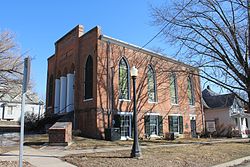
One of Glasgow’s many Presbyterian churches
Larger and more prosperous businesses were built. “They graduated from rudimentary shops in the slum quarters to more luxurious establishments … with lots of mirrors on the walls, wooden partitions and leather covered seats,” historian Bruno Sereni recounts. Stringing together several parlors and installing kinfolk, friends, and former employees in them, successful merchants enlarged their industry. Youngsters who the owners recruited from their home towns in Italy and who displayed a talent for business were rewarded with a shop to run. The new partner received all the necessary equipment, furnishings, and supplies—milk, sugar, cigarettes, and chocolates—from his benefactor.
The ice cream business in the Glasgow area mushroomed. From 89 shops in 1903, their number jumped to 336 in 1905. The Italian community also burgeoned, reaching 4,500-5,000. Immigrants who had once dreamed of returning home and buying land, put down roots.
The immigrants infused Glasgow, a mighty industrial city, with their commercial fervor. During the early twentieth century, the metropolis led the world in heavy engineering and shipbuilding. The arrival of ice cream shops, along with cinemas, dance halls, cafés, and other entertainment for the working and middle classes coincided with this burst of prosperity. For some straight laced Glaswegians, these indulgences were threatening. Upright citizens in this heavily Presbyterian city feared an incursion by Italian purveyors of pleasure. In the eyes of the city’s “conservative forces,” McKee points out, ice cream shops “epitomized the evil of luxury being smuggled into the souls of Glaswegians.” The product was frightening, she says, because it represented “something so obviously luxurious, unnecessary, and ephemeral.”

The works of Scottish author, A.J. Cronin, include Hatter’s Castle
Hatter’s Castle, a novel by Scottish writer A.J. Cronin published in 1931 that McKee quotes, describes a young woman’s initiation into the forbidding world of ice cream. Denis takes his girlfriend Mary to an Italian café in Dumbarton, a community near Glasgow. “Before she realised it and could think even to resist, he had drawn her in inside the cream-coloured doors of Bertorelli’s café. She paled with apprehension, feeling that she had finally reached the limits of respectability, that the depth of her dissipation had been reached.”
Ice cream, authorities feared, was a menace because it led the young on the path to perdition. A police inspector at a hearing in 1906 warned that the shops were promoting women’s “downfall.” Twelve- and thirteen-year-olds had been lured into prostitution by boys who were “going out acting as their bullies at night.” “Boys have been known to begin a course of vice owing to connections formed in these shops,” one officer alleged. To the apostles of propriety, the Sunday hours of the parlors were also reprehensible. A letter to the editor of the Glasgow Herald a blogger uncovered, portrayed the shops as “perfect iniquities of hell itself and far worse than the evils of the Public House.” To stymie them, reformers pushed through daily 10 p.m. closing laws and total Sunday closure.
Their accusers impugned the character of the Italians. “A good sober minded Scotchman at the head of the shop would not allow any nonsense. The ice cream parlors are not conducted in a satisfactory manner—they are mostly run by Italians,” one Glasgow officer alleged. In a city known as the “workshop of the world,” aliens, Catholics no less, were instilling injurious values in their young customers. Teenagers in the shops, one witness warned at a Sunday closing hearing, were “kissing and smoking and cuddling away at each other.”
The ice cream merchants fought back against the hostility and gradually won acceptance. The clash between the immigrants and the respectable classes resembled “una battaglia,” a battle, the colorful image historian Nicoletta Tranchi uses. The parlors established themselves, some upscaling with lots of mirrors on the wall, leather seats, and other decorative features. Bold dealers built chains. For the Scots, “Going to the Italian” turned into a pleasurable pastime.
Many cafés expanded their offerings to include fish and chips, mushy peas, and other quick items. The shops also concocted new ice creams—spiced oreo, passion fruit cheesecake, toffee crisp, and other “artisanal” fare.
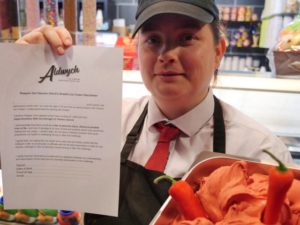
Respiro del Diavolo: World’s Spiciest Ice Cream?
The Scots may have acclimated to the once frightening ice cream parlor. But the experience can sometimes bring a shudder to the customer. The Aldwych Café and Ice Cream Parlor in Glasgow sells Respiro del Diavolo (“Breath of the Devil”), an incendiary confection made from the Carolina Reaper pepper. Buyers must sign a waiver before trying a flavor that caused one buyer, according to Canada’s National Post, “to feel thunderclap headaches.” The waiver absolves the business from responsibility for any personal injury, illness and possible loss of life.
To read more about the Italian ice cream merchants in Great Britain, see my piece, “I Scream, You Scream: Italian Peddlers and Coal Miners.”
I Scream, You Scream: Italian Peddlers and Coal Miners
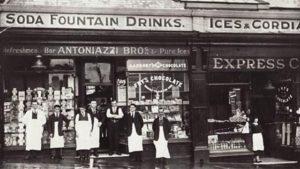
The Moruzzi family in front of the Antoniazzi Cafe they ran in Caerphilly, Wales
“We’re from the family that came over to make ice cream and run cafés,” the newly elected Welsh MP, Tonia Antoniazzi, told the magazine interviewer in 2017. “There are still Antoniazzi cafés all over Wales,” she exulted. Ms. Antoniazzi’s grandfather was part of a wave of Italian immigrants that flowed into South Wales in the late 19th and early 20th centuries. They opened cafés and peddled ice cream in the towns of the industrializing valleys and in coastal communities of the region. “The greatest concentration of Italian cafés outside of Italy is in Wales,” journalist Pamela Petro observed in 1990. Convivial cafés owned by families with names like Chiappa, Rabaiotti, and Conti offered refreshment and a haven for the Welsh working classes.
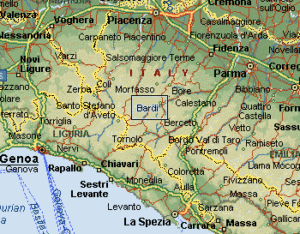
Bardi is in the north of Italy, in Emilia Romagna
The immigrants, single young men in the beginning, mostly hailed from the mountainous area around the hill town of Bardi, near Parma in the region of Emilia Romagna. By the time the villagers began their journeys from the Ceno valley, the once-fortified town with a grand 9th century castle had lost its prosperity and vitality. Peasants, tenant farmers, and small tradesmen—carpenters, cobblers, and other skilled workers—were barely managing to eke out a living in the harsh agrarian economy. To the Bardigiani, as the area’s dwellers were called, emigration seemed a surefire solution to their predicament. Their goal was to secure some kind of self-employment, however modest. They cherished their once secure independence and yearned to reclaim it. The newcomers, with their agricultural background, possessed an aptitude for small business. The assets they brought with them were similar to those anthropologist Robin Palmer ascribes to another group of entrepreneurially minded Italians in Britain: “The skills required in running a snack bar in London are not dissimilar to those of successful peasant farming.”
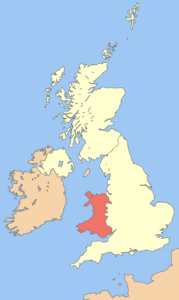
Map of Great Britain, with Wales shown in red at bottom center
How did the Bardi villagers end up in Wales, and how did they come to pioneer the ice cream trade? A tantalizing clue lies in the story of Giacomo Bracchi, who broke the ground for the café business. Welsh historian Colin Hughes unearthed the details of this mythic figure’s career. Bracchi, he found out after digging through census returns, had left Grezzo, a small community just up the hill from Bardi, and arrived in London in 1881. He initially made his living as an organ grinder, a popular Italian vocation. The young man shared a crowded lodging house with other street musicians with distinctive Bardi names—Fulgoni, Sidoli, Zanelli. Located on 1-2 Robin Hood Lane, the house was in the central London district of Holborn, home to a growing Italian colony. The dwelling’s manager was listed by the census enumerator as Francesco Rabbajotti [probably Rabbaiotti]. He, Hughes points out, was the padrone (master) of the organ grinders, who are listed as his servants.
The twenty-year-old Bracchi, the historian surmised, stashed away enough funds to travel to Wales sometime between 1881 and 1893. Then in the 1890s, after possibly working in a coal mine for a short time, he opened the first Italian café and ice cream shop in the country. The occupation listed on his birth certificate, “confectioner,” belied Bracchi’s humble calling.
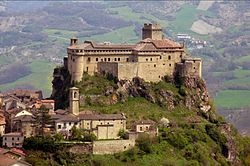
A view of Bardi Castle and the Ceno Valley in Italy
A smattering of Italians, largely sailors, already lived in Wales. The subsequent influx of Bardigiani would help build a larger colony, knit together by common origins and family ties—most residents of Bardi would come to have relatives in Wales. The success of innovators like Bracchi encouraged other aspiring entrepreneurs to follow their path.
For many of them, Wales was not their first resting place. Like Bracchi, they may have saved enough from jobs as chestnut sellers, street musicians in London, and other jobs for a nest egg to finance a future business. The necessary capital for the early trade, Hughes points out, was within the reach of the newcomers. A new trader might run his business from the back of his house and squeak by on fuel for his café stove from the abundant, cheap coal nearby. Some would begin their ventures with a simple hand cart to sell ice cream and later move up to a horse and wagon.
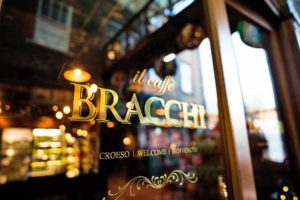
Il Caffe Bracchi in Rhondda, Wales
Guiseppi Bracchi built a small empire. At its height, he operated a chain of nine shops. The ice cream promoter’s fame was such that Italian cafés were often called “Bracchis.” His example was contagiousclusters of shops created by other enterprising families sprang up in the valley of South Wales. Kinship connections were, as they were for Bracchi, central to their prosperity. An owner based in Bardi might send each of his brothers to spend a year to manage the family business.
The immigrant risk takers also depended on the increasingly thriving Welsh economy for their success. Iron, steel, tinplate, and, most crucially, coal transformed once desolate valleys. Coal, which stoked the region’s industrial engine, accounted for one-third of the world’s exports of the commodity between 1890 and 1910, historian Hughes notes. A network of railways and port facilities helped fuel the boom.
The burgeoning industry needed willing hands. The valleys were now teeming with people desperate for work. Writer Thomas Jones captures the social upheaval: “They came from distant rural areas on foot and in carts, they came as Christians and pagans, thrifty and profligate, clean and dirty; and gradually sorted themselves out in their new surroundings according to tradition and habit. . . . The empty valley was turned into a long trough full of human beings bustling and jostling each other for food and drink.” The flourishing Welsh economy only heightened the strong desire of the Bardigiani to emigrate. The surging industrial workforce created a market for the services the hospitable Bracchi cafés could offer.
What were these early shops like? The Alien Land, a novel discovered by historian Hughes, depicts a 1902 café, owned by a Giusseppe Marti, a character based on Giacomo Bracchi. Angelo, a young boy recently recruited to work at the business, peers at his new workplace: “There were glass shelves behind the counter and arranged upon the shelves were glasses and bottles of various colours and lines of china cups. Below the shelves were boxes containing multi-coloured sweets and alongside them other boxes placed upright to display the packets of cigarettes inside them. Towards the middle of the counter was a glass case containing cakes, some iced and some filled with cream. . . . At the far end of the counter, as far away from the over-heated stove as it was possible to get, was an ice-cream container, a highly-coloured cabinet with a lid like a French sailor’s cap in the middle of it.”
To survive, the cafés needed a steady flow of youngsters like Angelo to keep them running. Proprietors tapped into the webs of friends and relations back home to enlist helpers. Bracchi himself often journeyed to Bardi searching for prospects. “Giacomo Bracchi used to go to Bardi to the market, and people with young boys would say, ‘Mr. Bracchi, would you like to have my boy to work for you? Take him to England,’” the son of a merchant from Bardi recalls in a radio interview quoted by historian Hughes. “All right, 30 shillings a month and I’ll give them clothing, feed them, and look after them,” Bracchi would say. “He used to go to over there and bring back about 10 to 15 boys over.”
Convincing families to send their sons was not a hard sell: A reputable businessman with roots in the community could be trusted to look after their child. It was also not unusual in Bardi for families to send their boys abroad. The master or his agent sweetened the deal with a small payment to their parents and a promise of room and board to their boys. (They usually lived under the same roof as their employer.) The setup was a variation on the padrone system, an arrangement in which bosses recruited industrious workers by shrewdly cultivating ties to their families.
Stories of successful Bardigiani who had traveled to Wales to try their luck excited the ambitions of village youth. In Bracchi, a musical written by Emyr Edwards, Grandpa Bracchi talked with Emilio, a boy eager to strike it rich in a faraway land. In the musical, which caught the attention of scholar Bruna Chezzi, the old man spins an alluring picture of the mysterious and bountiful country:
GRANDPA BRACCHI: You see, Emilio, the life here in the mountains of the Emilia Romagna is very hard for you and me.
EMILIO: Grandpapa Bracchi, Papa says that there is gold at the other end of the rainbow. . . . Far away in other lands? . . . In France and in England?
GRANDPA BRACCHI: And in Wales.
EMILIO: Wales? Where’s that?
GRANDPA BRACCHI: The other side of England, where there’s treasure in the ground. And men dig it up.
EMILIO: Treasure?
GRANDPA BRACCHI: Black gold. They call it coal.
EMILIO: Is there a fortune for everybody there, grandpapa?
GRANDPA BRACCHI: That’s where your uncle Alonso went, to open a café, and to sell ice cream.
EMILIO: That’s where I’m going one day, grandpapa. To Wales to earn a fortune.
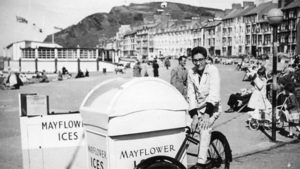
Italian ice cream seller in Wales in 1906
For all the inducements, the work of the apprentices was grueling. Their daily toil was severe, although it was tempered by their parents’ connections to their bosses. Nevertheless, they labored under a “stern and often harsh regime,” Colin Hughes argues. They were expected to spend long hours pushing a cart or wheeling a barrow vending ice cream through the streets. After summer was over, they were required to peddle fish and chips, another niche the Italian merchants carved out. The owners expected no less from their workers than they had from themselves. “They had themselves worked hard for long hours and had known privation,” Hughes points out. “They had no compunction about imposing similar conditions on their employees.” Many of the lads chafed under these constraints but put up with them. After learning the ropes, they left as soon as they could, often to start businesses of their own.
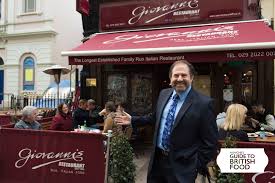
Giovanni Malarino in front of his restaurant in Cardiff, Wales
In addition to their street trade, the Bardigianis ran a lively café business. Quick meals like beans on toast, cigarettes, candy, tea, and oxo (a hot drink made from beef bouillon cubes) helped create an enthusiastic following. Coffee would only later become a mainstay of these shops.
The Italian ventures are reminiscent of pioneering Greek immigrant food businesses in America. In the streets, lunchrooms, and diners, the Greeks were purveyors of inexpensive, filling food. Rather than specializing in their own cuisine, both groups largely catered to the tastes of workers in industrializing towns and cities in the early 20th century. Outside factory gates in Chicago, Greek vendors hawked “red hots” (hot dogs) from pushcarts and lunch wagons. In their cafés, Italian merchants in Wales served pork pies to mine and iron mill workers. The traders came from similar backgrounds. Starting out as peasant villagers, they emigrated from struggling rural areas to set up shop in growing towns and cities.

Ice cream on offer at Sidoli’s cafe in Ebbw Vale, Wales
Ice cream, a major draw of these cafés, was a less familiar—and even exotic—product. Inheritors of a long tradition of ice cream making by Italians, the merchants from Bardi were introducing the confection, once the province of the wealthy and titled, to commoners in Wales. Families worked together in the early Bracchis cranking out ice cream with hand-operated machines. The elegant treat was once served in silver dishes in posh cafés in Italy and France, often by Italian proprietors. In the early 1800s, Giuseppe Tortoni, a glacier (ice cream maker) from Naples, ran a café on Paris’s Boulevard des Italiens that sold this and other luxurious refreshments. His guests included such notables as Talleyrand, Metternich, and Baron de Rothschild.
In the end, it was not their products that endeared the shops to the Welsh. It was their infectious atmosphere. “The Italians had hit on a recipe for success in the thriving valleys,” Colin Hughes remarked. “The local population, crowded in their mean-built houses, had few civic amenities. Here was a home away from home, a social gathering place where there was no obligation to buy the wares, however long you stayed.” Later, the historian observed, “they gave particularly to the young, single working man a service, which the Welsh themselves, by their temperament would never have provided. The Italians brought a certain elan.”
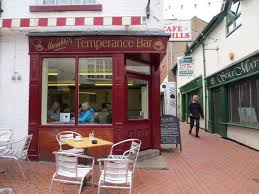
Marubbi’s Temperance Bar cafe in Wrexham, Wales
Keen merchandisers, the café owners adapted their businesses to a culture quite alien from their own. Since many of the Welsh were “Non-Conformists,” Methodists who were temperance adherents, it was risky to offend them. After Wales passed a Sunday Closing Law in 1881, the Italians spotted an opening in the market. They started calling their shops Temperance Bars in order to lure workers and their families who might previously have gone to the now shuttered pubs. During the week, these homey establishments even attracted “punters” away from the public houses. Business was good enough that proprietors were willing to pay the fines occasionally meted out by strict law enforcers. A strong bond developed between the unlikely partners, between chapel goers and Laborites, on the one hand, and immigrants who were, as writer Peter Dunn described them, “devoutly Catholic and discreetly Tory.”
The Italian cafés gained momentum and the outsiders won acceptance. Their number mushroomed—more than three hundred of these businesses were operating by the mid-1930s. Single men married and the Bracchis were transformed into family enterprises. As more relatives arrived from Bardi, a tightly knit community emerged. Immigrants who came with little means gradually achieved relative affluence.
Over time, however, conditions became less fertile for the shops. Industries like coal and steel, which helped the cafés rise, began to decline. Television and other forms of entertainment ate into their business, especially the evening trade. Some ethnics moved into more lucrative sections of the industry, opening trattorias serving Italian food or other full-service establishments. For example, the Berni family, prominent in the ice cream business, built a popular chain of steakhouses. Children of Bracchi owners and young people generally were reluctant to follow the entrepreneurs into the café business. White collar jobs had more appeal to the second and third generations, especially to college goers.
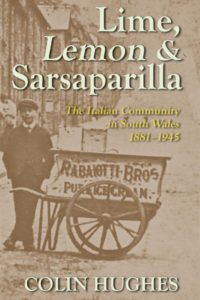
Cover of Colin Hughes’s book, Lime, Lemon & Sarsaparilla
Colin Hughes, who wrote so lyrically of the glory days of the immigrant cafés in his book, Lime, Lemon, and Sarsaparilla, sounded a gloomy note in 1991, the year of its publication. The once vibrant business was withering away, shops were closing, and “Chinese takeaways are moving in.”
Through all the ups and downs of the ice cream business, the Bardigiani kept up strong connections to their homes in the Como Valley. The longer they lived in Wales, it seemed, the more these ties strengthened. Rather than shed their traditions, they accentuated them. “My dad says the Welsh-Italians are almost more Italian than the Italians,” Emilia, a postgraduate broadcast student told journalist Amanda Powell, writing in Cardiff’s Western Mail.
Homesick Italians made regular visits to Bardi. Some bought houses in the area. “It’s strange, you’ll be in this little town in Italy and you’ll hear Valleys accents,” student Emilia commented. During the summer in Bardi, Colin Hughes noted, “spoken English, heavily accented, mingled with dialect Italian in the square. Cars with Great Britain plates are everywhere, among them an occasional Rolls Royce.” An annual festival, which features dancing, traditional songs, old-time food, and other festivities, encourages summer journeys. To the consternation of the visitors, the locals are not always welcoming. A popular image of the sojourners, Hughes says, is that they have been “abroad” and “picked up money with a shovel.” The fondness their Welsh hosts felt for the Bardigiani should assuage any hurt feelings.
NOTE: Colin Hughes’s fascinating book, Lime, Lemon, and Sarsaparilla, was an invaluable source for me. Any quotations not otherwise identified come from that volume. Another important reference is Lucio Sponza’s Italian Immigrants in Nineteenth-Century Britain.
Born in an Italian American Dairy: Wisconsin’s Swiss Miss
The career of Charles Sanna, the inventor of Swiss Miss Instant Cocoa, who died this March in Fitchburg, Wisconsin, sheds light on a hidden corner of the dairy business. It is a niche occupied by Italian Americans. The entrepreneur, who was 101 when he died, was the son of Anthony R. Sanna, a Sicilian immigrant who founded the Sanna Dairy Engineers company in 1935.
Charles, who had studied mechanical engineering at the University of Wisconsin, was an ingenious worker in the family business. Faced with a huge surplus of leftover coffee creamer the dairy produced for the military during the Korean War, he had an inventive solution. The powder, Sanna surmised, “would make an excellent ingredient for a hot cup of cocoa,” according to The New York Times. “I consulted the family cookbook and determined the best proportions of creamer, sugar, cocoa, and vanilla. The lab promptly came up with the finished product.”

Holstein cattle
Charles’s brother, Anthony, originally named the item Brown Swiss, the Switzerland cattle breed. It was actually made with milk from Holsteins. Brown Miss, which the dairy sold in pre-measured envelopes to airlines and restaurants, faced an early hurdle. Restaurant patrons, The New York Times obituary pointed out, frequently walked away with the packages.

Box of Swiss Miss hot chocolate mix
Using less expensive non-fat milk powder, which gave the product a longer shelf life, the company began targeting supermarkets and other retailers. It was rebranded in 1961 as Swiss Miss, a name, The Washington Post notes, brother Anthony took from the title of a Laurel and Hardy movie. Mail order Swiss Miss dolls, sold for three dollars and a box top, helped promote the product.

Swiss Miss doll
It was marketed as the country’s first instant hot chocolate drink that could be made with water rather than milk. Now owned by Conagra, Swiss Miss is still made at the original plant in Menomonie, Wisconsin.

Package of Sanalac
The story of Swiss Miss leads back to Charles’s immigrant father, Anthony, who founded the dairy business. An artisan who made his own ricotta and mozzarella, he also appreciated the virtues of technology. Anthony, whose plant manufactured evaporated milk, devised a technique for drying milk. He passed it on to his sons, who used it in the mid-1940s to develop Sanalac, reputedly the first instant dry milk on the market. The family patriarch’s ingenuity paved the way for Swiss Miss.
Brother, Can You Spare a Lime?
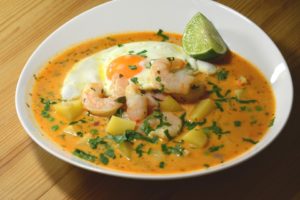
Peruvian Chupe de Camarones with lime wedge.
“In my country, we don’t like the yellow one.” My Thai hairdresser and I were talking about the merits of limes and lemons at a Dupont Circle salon. At Santa Rosa, the late Peruvian seafood restaurant in Adams-Morgan, I asked my waitress about the lime wedge that accompanied my chupe de camarones, a reddish-orange shrimp chowder filled with rice, potatoes, egg, and a small ear of corn. I should squeeze the “limon” in the soup, she said. You mean lime, I responded. She looked baffled. Instead of words, we talked colors. The “green” one, she told me, was better than the “yellow” because the fruit was more sour. Sometime later in a Latin grocery, I passed a display of limes with a sign that said “limas.” Another Hispanic shop advertised limones verdes (green lemons).

A lime bush in blossom.
The saga of the lime is a tale of puzzles. The most delicate member of the citrus family, the thin-skinned fruit can easily perish outside a tropical climate. Its cousin, the lemon, is more resilient. The lime tree, a shrubby evergreen with spiny twigs, grows small white flowers. Fragrant oils flow through sacs in its leaves and outer rind.
Native to India and Malaysia, the lime was treasured as much for its spiritual power as for its flavor. In Malaysia, botanist I.H. Burkill points out, limes were given to elephants to make them “sagacious.” Brahmin widows in India, Piero della Valle, a 17th century Italian writer reports, were required to ride once a day around the city, face uncovered, holding a lime in one hand and a mirror in the other.
The Arabs, the preeminent early traders and transplanters of citrus, called the yellow fruit they discovered in India a “laimun.” They often used the same word for lime. When Islamic writers tried to describe the novel fruit, they fell back on familiar language. Abd el-Latif, a 13th century writer, marveled at a “balm lemon of smooth skin the size of a pigeon’s egg.”

Key limes in a basket
The Arabs brought citrus fruits from India to Arabia in the 9th century. As they expanded into Spain, the Middle East, and Africa, they introduced the fruits to their colonies. The Moors in Spain decorated their towns with tableaus of citrus. “[M]ost of the houses of Seville, not to say all, were abundantly provided with running waters, and spacious courts planted with fruit trees such as the orange, the lemon, the lime,” wrote Ismail Ibe Mohammed al-Shakandi, an Arabic geographer.

Persian limes in a basket
The rulers, who infused their own food with a citric fragrance, introduced their methods to their subjects. From the Arabs, the Spanish learned the technique of marinating meats with sour orange and other “acid fruits.”
The lime arrived in the New World with the Spanish and the Portuguese. In the 16th century, it was taking hold in the West Indies, Central America, and Mexico, which is today the world’s largest producer of the fruit. The formal name for the fruit in Spanish is lima, but people commonly used limon to refer to both lemons and limes.
By the early 19th century, limes were growing in backyards and wild in thickets in South Florida. After a hurricane in 1906 killed the pineapple crop in the Florida Keys, growers started farming limes commercially. They planted the key lime, the “true lime” as it was called. It was the same fruit as the Mexican and West Indian lime, all of which descended from the original Malaysian and Indian species.

Key lime bush.
The golf-ball sized fruit comes from a thorny plant, which adapted well to the Florida heat and dry climate. Lest we romanticize them, they are born on “scruffy, homely little trees,” as New York Times writer R.W. “Johnny” Apple described them. “They actually flourish in adversity,” horticulturalist Larry M. Schokman told the journalist. “They fruit even in chalky or rocky soil, with little irrigation and fertilization.”

Persian lime growing in pot
More hurricanes ended lime cultivation in the Keys in 1926. Commercial farmers replaced the key with the Persian lime, a hybrid. Unlike the key, it had seeds and was twice its size. Although the Persian lacked the exquisitely sour taste of its rival, the fruit was highly marketable, argues food historian Raymond Sokolov in his book, Fading Feast. “The Key lime could not hold its own against leather-skinned, easy-to-ship, hardier, seedless, larger but far less delicious . . . limes.” Moreover, the thorn-free plants were easier to handle. The limes of the Persian group, which are sold green rather than a ripe yellow, dominate the supermarket shelves today.

Key lime pie
Despite the devastation to the crop, the fruit was beloved by the people of the Keys and by the tourists who thronged there for key lime milkshakes and key lime saltwater taffy. The popularity of the fruit in the U.S. soared with the advent of key lime pie. Likely dreamed up in the 1890s, the treat made its way into culinary Americana. New York Times food critic Craig Claiborne hailed it as “the greatest of all American regional desserts.” For the ecstatic author of a 1936 recipe, the pie was a “Conch contribution worthy of the Cordon Bleu.”
The story of key lime pie is steeped in folklore. Its creation, many experts suggest, is bound up with the availability of canned sweetened condensed milk, an ingredient central to the dessert. Invented by Gail Borden in 1856, the product was a godsend in the Keys, where no fresh milk was sold until the 1930s.
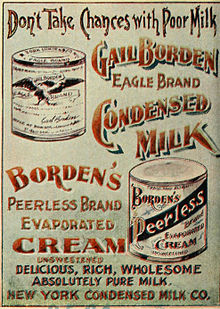
Ad for Borden’s sweetened condensed milk
Millionaire businessman William Curry transported cases of condensed milk to the Keys in the 1850s. The milk, key lime authority David L. Sloan explained to food writer, Molly O’Neill, was a boon to residents: “When William Curry brought in cases of condensed milk in the late 1850s, it was a luxury product. He couldn’t stock enough of it. Ships carried it; fishermen carried it. It allowed cooks in the mansions to make cream sauces and ice cream. Canned milk was the precursor to fresh dairy around here. You can do a lot to personalize a pie and let it tell your story, but don’t you even think of using real cream. Sweetened condensed milk is the only way you can get a smooth, creamy filling.”
Condensed milk was a staple on fishing boats: “I’ll go with my theory . . . that says spongers in the 1890s stuck out on the water who were tired of eating fish came up with a treat—lime juice, sweetened condensed milk, bird eggs and old bread,” local historian Tom Hambright told writer Gwen Filosa.

An inviting slice of Key lime pie
Although the pie is frequently not made with key lime, its fans remain enthusiastic. Like the lime itself, the dessert conjures up dreams of tropical delight and the songs of Jimmy Buffett. Even as the fruit has become less plentiful and more expensive, it has retained its mystique. Sophisticated chefs use it for culinary creations like key lime buerre blanc and key lime vinaigrette. High-end grocers sell bags of the fruit as a specialty item.
Some commentators, however, scoff at the key lime mania. “I hate key lime pie,” Stella Parker acknowledges in Serious Eats, the online journal. “They’re tiny, harsh, and abrasive, and a freaking pain to juice. . . . Should you be fool enough to bake a key lime pie without ’em, prepare to be eviscerated by the authenticity police.” Key lime devotees are not likely to be swayed.
Born in the Barrio:
The Cafe Bustelo Story
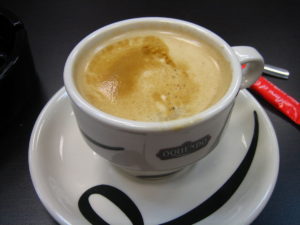
Cafe con leche, a favorite drink of Hispanics.
Long before the fascination with café latte, café con leche was in vogue. Café Bustelo, the strong, dark roast often used to make this milky espresso drink, first gained a following in Latin neighborhoods. Bustelo stalwarts often took it straight, topped with espumita, its signature foam. Along with a piece of toast, the refreshment made for a simple breakfast.
When I tried it, I found the coffee harsh and bitter, but I persevered. The flavor wasn’t really the point. There was something daring about partaking of a drink whose very name had an exotic ring. It sounded vaguely Latin or Spanish to me, but that was as far as my curiosity took me. Being conversant with Bustelo in post-college days made me feel grown up. This was no Chase and Sanborn or Chock Full o’Nuts.

Cafe Bustelo in its familiar can.
The bright red and yellow colored Bustelo can was also alluring. I kept an empty container on my desk, a combination memento and pencil holder.
It was only recently that I felt driven to explore the history of my youthful enthusiasm. Knowing more about Bustelo might help me better understand myself and the times in which I grew up. I started unearthing its history.
The story of Bustelo is an immigrant tale. The saga is intertwined with the early Latin settlement of the Spanish Harlem neighborhood in New York City. The founder of the business, Gregorio Menendez Bustelo, was a Spanish transplant. Born in Spain’s Asturias region in 1894, he was an émigré who had also experienced life in the Latin Caribbean. Gregorio spent time in Cuba, where he discovered the joys of the land’s dark roast. He married a woman he met there and they migrated to another former Spanish colony, Puerto Rico. The U.S. Congress had just passed a new law, the Jones-Shafroth Act, which gave all Puerto Ricans American citizenship, and the adventurous couple took advantage of it. In 1917, Gregorio and Angelina moved to New York City and settled in East Harlem, which was gradually taking on a Spanish flavor. Migrants from Spain, Puerto Rico, and Latin American countries were supplanting the Italians, who, in turn, had replaced the Irish and Germans. (Today, the area has been attracting Mexican immigrants.)
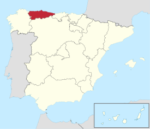
The Asturias region, on Spain’s northern coast.
Bustelo worked as a chef’s helper in the kitchen of the Hotel Pennsylvania, all the while nursing his dreams of opening his own business. One of his jobs, working as a traveling salesman, heightened his interest in the coffee trade. Customers snapped up the coffee he was hawking. The young couple soon bought a roaster with their small savings. Gregorio sold his product to neighborhood restaurants during the day and peddled it door-to-door at night.
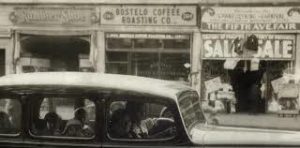
Storefront of Bustelo Coffee Roasting Co. on Fifth Avenue, NY
In 1931, he opened his own store on Fifth Avenue between 114th and 113th Streets. He called it the Bustelo Coffee Roasting Company. He joined other merchants, many of them also Spaniards, who were catering to the growing Latin population.
Bustelo’s shop was just one of many businesses in the enclave called “el barrio.” Across the street, Fifth Avenue Hardware, a store run by two friends from Spain’s Aragon province who married two sisters from Puerto Rico, made keys for newcomers. Nearby El Siglo, a gift shop, sold perfume, soap, and other niceties. The Valencia Bakery, another establishment across the avenue from the Roasting Company, lured customers with their trademark guava pastries and other delicacies. “Oldtimers still remember” this “pairing of Bustelo’s rich and dark espresso brew with the Valencia’s pastelillo de guayaba,” the “Traces of Spain in the U.S.” blog observed.

The popular pastry known as Pastelillo de guayaba
Bustelo, like many other business owners in East Harlem, had a special asset. He was conversant with the tastes of the Caribbean world. “Many enterprising Spanish-born immigrants—most of whom had spent time in Cuba or Puerto Rico—would establish businesses that would thrive, thanks in large measure to the patronage of the even larger and quickly expanding Puerto Rican population of the city,” James D. Fernandez, New York University professor and authority on Spanish immigration, points out.
An energetic arts scene also flourished in the quarter. Bustelo’s early business profited from the street trade drawn to the area’s exuberant music stories. The shops, which sold instruments, record players, sheet music, and radios, attracted musicians looking for jobs and band leaders seeking to hire performers. “Lamento borincano,” Puerto Rico’s unofficial national anthem, was written by Rafael Hernández, who, with his sister, Victoria, owned Almacenes Hernández, a neighborhood record store. Bustelo spread the word about his product by sponsoring radio and stage shows. His shop was also conveniently close to a popular movie theater. Attentive to the times films let out, he roasted his tantalizing coffee when showgoers were most likely to pass by.
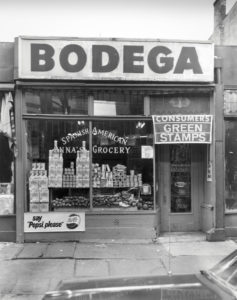
A bodega, a typical Latin corner store.
Bustelo sought out more outlets for his coffee. He signed up the city’s bodegas, the street corner convenience stores increasingly owned by Puerto Ricans. In New York City’s Hispanic neighborhoods and later in ethnic communities throughout the Northeast, the coffee’s fame spread. Bustelo became the coffee of choice in their households. The colorful Bustelo tin was a ubiquitous presence in Latin eateries. Bustelo was now a badge of identity.
Bustelo caught the eye of urban bohemians like myself, eager to embrace the exotic and the authentic. I soon lost track of the product that I had once found so captivating. Bustelo, I learned later, followed the familiar path taken by marginal enterprises that were discovered by the wider public. It attracted the interest of large corporations. Tetley, the global giant that started as a tea company, acquired Bustelo in 1963. J.M. Smucker now owns the brand.
The early storefront-turned-manufacturing-firm had been inching its way into the mass marketplace. The 1996 musical “Rent” assumed its audience was familiar with the brew (“Bustelo, Marlboro, banana by the bunch”). In HBO shows like “Girls,” set in Brooklyn, writer Rachel de Valle observes, the Bustelo can was a de rigeur prop, a cultural backdrop: “The red and yellow Café Bustelo tin is to the hipster kitchens what Heinz ketchup bottles are to American diners.”
Even as it cultivated millennials, Bustelo has struggled to maintain its ties to young Latin consumers. “Drinking coffee and dancing Salsa is part of our culture and tradition,” Jorge Gomez, a musician whose band the company promoted, told Ben Sisario of The New York Times. “You make it a party every day and for a Cuban party you need a little Bustelo coffee and a little rum.”
One of the company’s marketing ploys was selling café con leche in a can, a hit with music festival crowds. The product was called Bustelo Cool. I’ll take my Cuban coffee the old fashioned way, thanks.
Note: Professor James D. Fernandez’s writings on East Harlem and on Latin immigration generally were invaluable. Mine is a work in progress. If any readers know more useful details on Bustelo, please send them on to foodpassages@gmail.com.
Packaging Pilaf:
Hannah Kalajian and the Making of Near East Food
Part II
In Part I, Hannah Gartazoghian (later Hannah Kalajian), a ten-year-old Armenian girl, the founder of Near East Food, flees her village in Turkey. (Near East makes packaged rice pilaf, couscous, and other similar items.) She embarks on a harrowing journey that will take her to Constantinople, Beirut, and ultimately to the U.S. Part II picks up in the Bronx, where she has joined her sister.
After a five-year sojourn in the Bronx, Hanna turns 18 and finds love. She meets George Kalajian, the brother of her cousin’s husband. After a whirlwind courtship, in 1929, Hannah gets married in Cambridge, Massachusetts, where her partner lives.
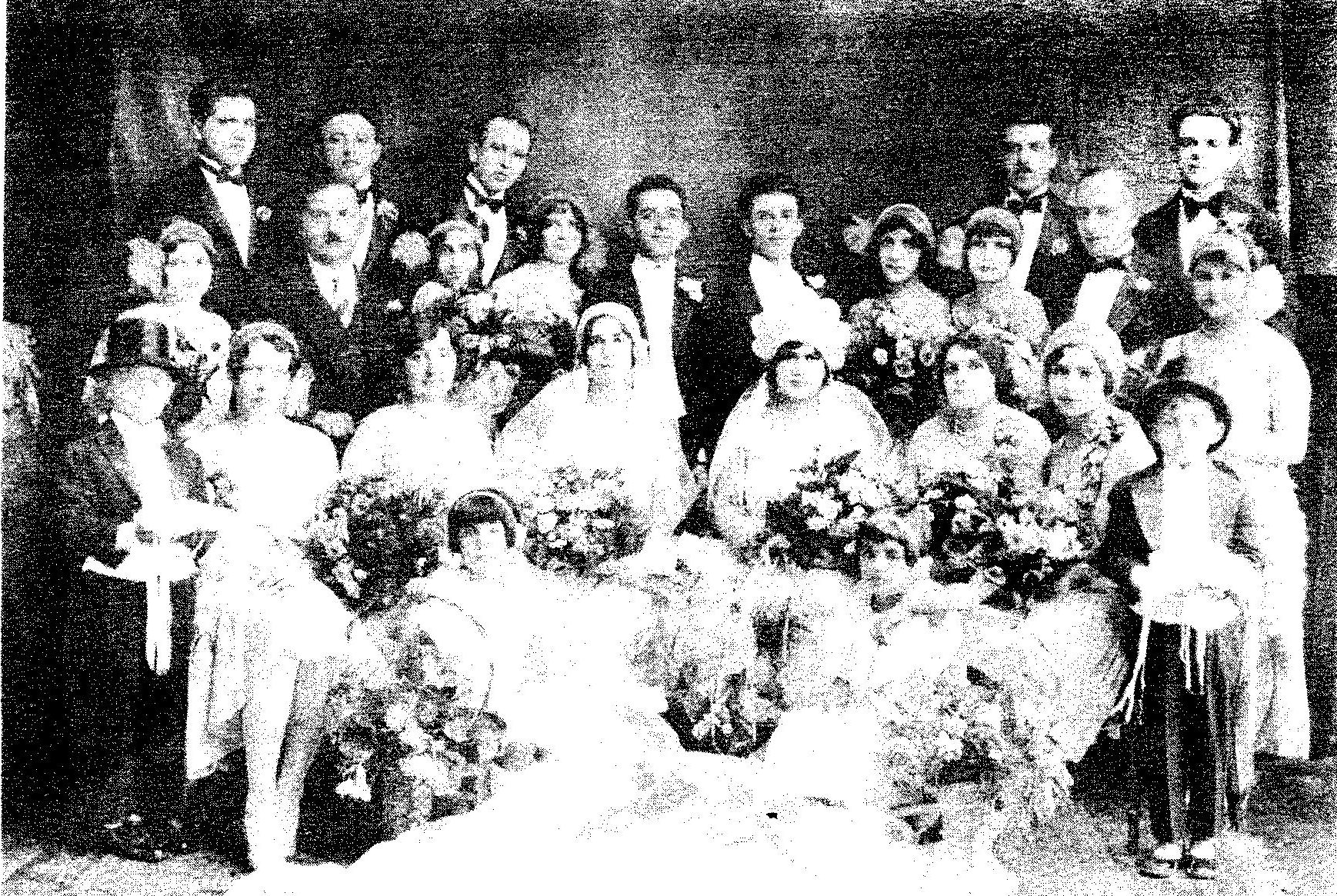
Double wedding: George Kalajian marries Hannah (group on left) and his brother Mike marries Victoria (group on right)
George, who had also fled Turkey, comes from Evereg, the same small town where Hannah’s parents grew up. An edict posted in the community forced the departure of George’s family: “In three days your homes will be padlocked. You must leave this country and go to Syria.”
The young boy, about eight or nine, his mother, a sister, and three brothers, led by their father, a town merchant, take flight to escape a certain massacre. After reaching Damascus, which had been inundated with refugees, the clan decides to set out for Arabia—George’s father, sister, and his two younger brothers die during the desert trek.
A sheik takes the survivors, George and Mike, under his wing and puts them to work cleaning his stables and doing other menial jobs on the property. Considering him part of the family, the landowner offers George his daughter in marriage. The brothers finally escape his clutches, leaving in a caravan carrying goods to Damascus. After receiving money from a sister living in the U.S., they head for America and settle in with her in Cambridge.
Hannah moves to Cambridge to join George and assumes another burden, caring for his ailing sister. But her new home excites her: “Cambridge thrills me over and over. It offers quiet walks by the Charles River, the fragrant gardens, and ancient elms of Longfellow Park and the ivy-covered walls of Harvard buildings.” One day Hannah listens raptly to a lecture by Dr. Roger W. Babson, a Massachusetts entrepreneur and founder of Babson College, who extolled the opportunities offered in her adopted land: “America is a land where initiative is rewarded. Whoever can produce even a better shoelace can get rich in the United States.”
George and his brother Mike possessed the pluck Babson had praised. “Natural gamblers,” Hannah calls them. They purchase an ice cream spa in Waltham, a nearby town. But they made their gamble in 1929, when the collapse of the economy made it impossible to keep their business afloat. Two years later, the owner of the business returns from Italy and takes back the shop. Ever the optimist, George persuades his wife to return to New York City, where he starts work in a produce market making five dollars for a six-hour day. The grueling pace exhausts him.
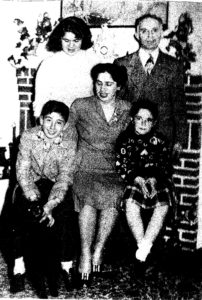
Hannah Kalajian surrounded by family, Christmas 1945: George, son Jack and daughters Cohar and Carol
Seemingly out of options, the couple who now have two young children, Cohar and Hagop, decide again to pull up stakes. Hannah remains her tenacious self: “A familiar restlessness possesses me. There is something better out there than survival. If I could just recognize it, touch it, find the way.” George has a friend in Worcester, an industrial town west of Boston, who wants help managing his grocery store. Hannah marvels at this city of seven hills, many of whose dwellers live in triple-deckers, structures built for Worcester’s working class. The family settles into one of these houses. “In the back I can see three layers of back porches where laundry flaps on identical circular clothes reels,” Hannah reminisces.
George’s employer, however, goes bankrupt. The failure convinces Hannah that the couple must have their own business. They rent a former candy store, which they convert into a combination grocery, ice cream bar, and luncheonette. In 1941, they buy the building, whose upstairs becomes the family residence.
Worcester, which made corsets, dining cars, shredded wheat, and other products, had a long history of Armenian settlement. In 1905, the manufacturing city had the largest community in America of these immigrants. As historian Dr. Hagop Martin Deranian tells the story, when an Ellis Island official asked a newly arriving Armenian for his destination, he responded, “America.” Baffled, the agent told him he was already there. “No, no Worcester is America,” the Armenian said.
Protestant missionaries from New England, who took their message to Armenians in Turkey, sowed the seeds for their later migration to America. Kharpert Province, an area 900 miles east of Constantinople, was fertile ground for the ministers. Rev. George Dunmire, a campaigner whom historian Robert Mirak cites, was intoxicated by the opportunities provinces like Kharpert offered: “the richest country and the most inviting and promising missionary field I have seen in Turkey.” Many of Worcester’s Armenian settlers hailed from Kharpert, where in 1856, a Protestant Evangelical Church was established.
The first Armenian to make his way to Worcester was a young man, Caro, who came with Rev. George Knapp, a Congregational minister. Knapp employed him as a servant in his home. The pioneer was followed by an influx of young artisans and peasant farmers, mostly bachelors, in the late nineteenth and early twentieth centuries. They took jobs in factories like the Harrison and Richardson Arms Company, the Winslow Skate Manufacturing Company, and the Crompton and Knowles Loom Works.
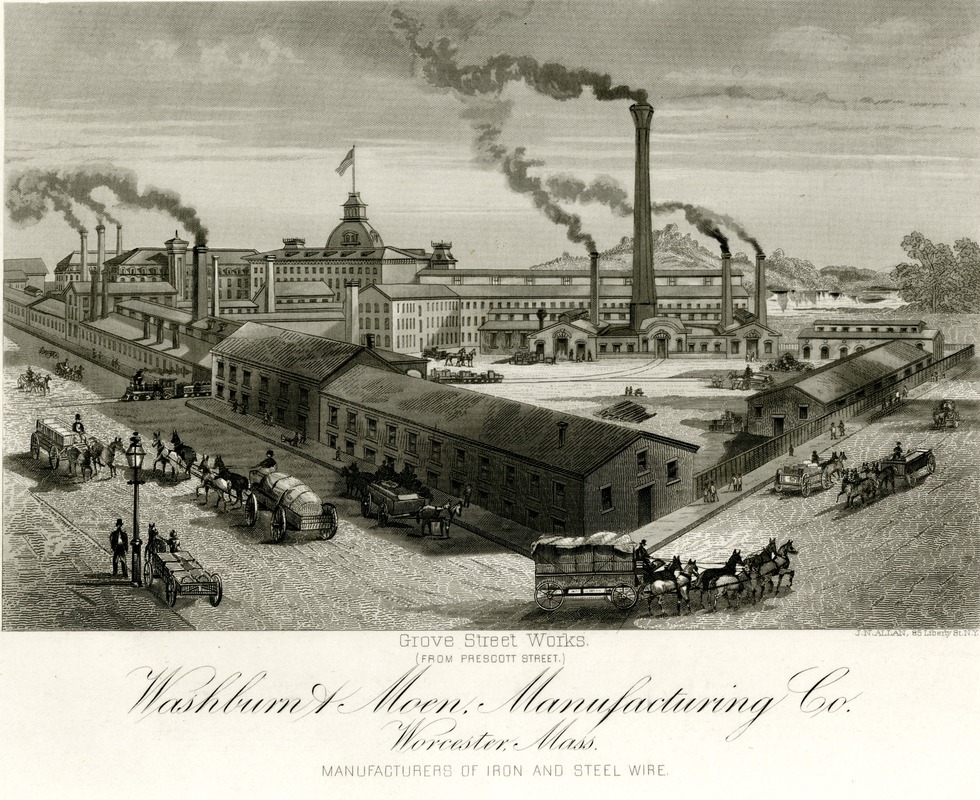
Washburn and Moen Manufacturing (The Wire Mill) in Worcester, Massachusetts
The Washburn and Moen Manufacturing Company, or the “wire mill” as it was commonly called, was a magnet for the immigrants. The mill, the town’s largest business, manufactured barbed wire for fences in the West, wire for pianos and electric lights, and other necessities. Owned by Philip Moen and Charles Washburn, who had strong ties to local missionary leaders, the company sought out cheap, hard-working hands. “Armenians will not work anywhere else,” the Worcester Telegram newspaper pointed out. By 1889, 300 Armenians were on the wire mill’s rolls.
Caro, the clergyman’s servant, was one of those tempted by the attractions of a factory job. As historian Deranian recounts it, an Irish laundress working for Rev. Knapp persuaded Caro that there was more money to be made in one of the city’s factories than as a servant. He left his domestic job and went to work in a mill, where he made $1.50 a day (versus his old pay of $0.75 a month). Caro wrote glowing letters to his countrymen encouraging them to follow his example.
The Armenian path in Worcester was not an easy one. The newcomers were frequently bullied, mugged, and, possibly worst of all, taunted as “Turks.” But the immigrants persisted and soldiered on. The respect in which they were held by many of their bosses also helped: “As a rule, [the Armenians] are temperate,” Charles S. Hall, a mill official, wrote a friend in 1889, according to historian Deranian. They “use no profane language—and do not use intoxicating liquors. As a rule Protestants … very peaceable and quiet, generally steady workers.”
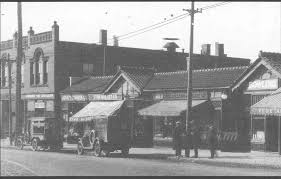
Original Star Market in Watertown, Massachusetts
The factory was a way station for many Armenians, who, impatient with the harsh regimen, desired a more independent life. They displayed a flair for entrepreneurship. Sarkis Mugar (originally Mugerdichian), who had been a tinsmith in Turkey, scholar Deranian notes, toiled as a young man in Worcester’s wire mills. In 1916, he acquired the Star Market, a grocery in Watertown, Massachusetts, for $900. The small store was the launching pad for the supermarket chain his family built.
In a large Armenian neighborhood in Worcester, the 1910 Census counted 73 wire workers, but also 15 business owners, 8 grocers, 8 tailors, 4 shoemakers, 2 doctors, and 2 dentists. The immigrants’ commercial drive, industrious habits, and other New England virtues won them praise. “It is no small thing to have a colony of these ‘Yankees of the East’ in our city,” Protestant minister Milan H. Hitchcock applauded in 1901. The Armenians generally, historian Mirak points out, surpassed many other ethnics in their achievements: “The Armenians adjusted to the American economy with a relatively high degree of success. Only the Eastern European Jewry adjusted more rapidly to America.”
Hannah and George Kalajian carry on the Armenian entrepreneurial tradition. Their shop gradually builds a clientele. Workers from the nearby lumberyard come by for coffee and doughnuts. Hannah expands her menu to include sandwiches and pies. The store sign now reads, “George’s Fruit Market and Luncheonette.”
Hannah begins turning out daily specials at the 12-stool lunch counter. “American-style” plates—”baked beans, chop suey, beef stew, macaroni and cheese”—cater to customer tastes. She decides to make roast chicken and Armenian pilaf to “lure” patrons away from “American carbohydrates.” Her customers become avid fans of the dish. Despite all the daily pressure, Hannah works hard at keeping her food heritage alive: “In the summer she’d gather young grape leaves for stuffing and in the spring she’d find wild greens for salads,” son Jack tells the Christian Science Monitor’s Phyllis Hanes. “She made phyllo dough from scratch for sweets with layers of flaky pastry spread with honey and butter and chopped nuts. She was always stuffing tomatoes and eggplant or rolling cabbage and grape leaves.”
A family emergency disrupts the shop’s steady momentum. George falls ill with pneumonia and is bedridden for almost two years. Hannah takes on all of the chores of the business, handling groceries, running the luncheonette, whipping up ice cream for school kids. She pays a price for the ordeal: “I didn’t know I was having a breakdown. I knew only that a captive demon gnawed at my insides but never quite escaped.”
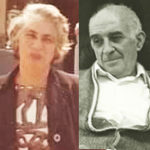
Hannah and George Kalajian
More obstacles confront the business. Lincoln Square, the hub of their trade, is slated to be demolished so that a tunnel can be built beneath it. The Sawyer Lumber Company, whose employees were Hannah’s most regular customers, moves away. Hannah fights exhaustion and, after a hospital stay, travels to California, where her son Jack and his family and other relatives live. She needs a respite from the daily toil: “I dream of a solution to this endless parade of hours behind the lunch counter, but I always wake up to a body still bone-tired and a mind too numb to plan.”
One day during her recuperation, Hannah has a revelation. At dinner at her cousin Missak’s (the owner of the Balkan Restaurant, an Armenian dining room in New York City), the guests are served the inevitable “steaming bowls of pilaf.” The oily noodles bother Hannah’s stomach. Missak suggests that toasting them in the oven might be preferable. That night, her imagination stimulated, Hannah begins musing: “I retire early, but can’t get to sleep. Something is boiling up inside my brain. It’s like a hot spring, bubbling closer and closer to the surface.” She leaps out of bed and tells Jack and his wife, Lorraine, of her dream. “I’m going to start a business! I’m going to put my pilaf on the market! My own pilaf mix!”
Husband George, who had experienced the severe demands of running a small business, was at first skeptical about the idea. “Dad said, I know the grocery business, and you can’t do that,” son Jack told Boston Globe correspondent Gail Perrin. But the commercial climate of the day emboldened Hannah. “In the markets, the big thing was packaged mixes,” she commented to a reporter. “If they can do it, so can I.”
Returning to Worcester, she has a head of steam. Leaving the lunchroom responsibilities to George, who has recovered, Hannah begins a tireless effort to create the right blend of flavor, spice, and texture for her product. The details, particularly what kind of noodles to use, pressed on her mind. After sampling a pilaf one evening at a buffet at the Church of Our Saviour, an Armenian church in Worcester, she decides to substitute orzo for vermicelli. “We find we can quick-fry the orzo, a wheat pasta shaped like small ovals, on top of the stove. The oil coats it, but it doesn’t sink in. And it stays crisp. . . . It’s still crisp on the shelf and nutty delicious.”
The problems of starting a small food business—shelf-life, standardizing the product, and finding wholesalers who can sell her everything from glue to spices—consume her. She immediately contacts the FDA. “They put me in touch with suppliers and told me what I could do and what I couldn’t do,” Hannah tells Worcester Telegram and Gazette correspondent Dolores Courtemanche. Hannah turns the family kitchen into a testing lab to resolve a host of questions: “How strong should our foil bags be? One pouch or two in each mix? What could go wrong with our dehydration techniques?”
A production line of family and friends, stretching from the living room to the kitchen, assembles pouches of ingredients, which were initially dried brown rice, Lipton chicken stock, and broken vermicelli noodles: “The bags march raggedly forward. Ingredients are carefully measured, knifed off clean from cup or spoon, and dropped in,” Hannah writes. “At the end of the line, the warm glue is spread and the sealed bags line up like soldiers, in a succession of trays.” Looking back, her daughter Carol recalls the makeshift system in an interview with Pandolfi: “It was a real Mickey Mouse operation. All these Armenian ladies working in that tiny room.”

Near East original rice pilaf box
Hannah calls her product, “Near East.” The package’s “exotically curved letters,” she observes, suggest “a hint of camels and desert sands.” A sheaf of wheat adorns the left side of the boxes. The business is formally established as Near East Food Products, Inc. in 1962 and begins selling both rice and wheat pilaf.
Getting grocery stores to buy the product was Hannah’s next big challenge. “Back then, pilaf was very foreign,” son Jack told journalist Mary Tuthill. “My mothers and sisters had to take bowls of pilaf to the stores to people could sample it and find out what it was.” Daughter Carol often carried an electric pot in the trunk of her car on sales trips. Interestingly enough, it was actually the family’s ethnic ties that helped the fledgling business break into the large Boston market. The Mugars, an Armenian family whose patriarch was the aforementioned Sarkis, agree to carry the pilaf in their supermarket chain, Star Markets. “We have a foothold,” Hannah enthuses.
The Star Market breakthrough opens new opportunities. Daughter Cohar capitalizes on the initial success. She “spent day after day spinning her wheels through the slush and ice of countless New England towns,” Hannah recalls. “It’s wonderful how doors open once you have ‘references’: ‘Yes, we’re doing very well in the Star Markets, you know….’” After that pitch, Cohar would set up a card table in the store and woo customers with the fragrant smell of pilaf wafting through the store.
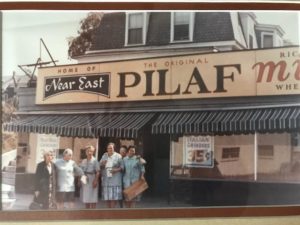
Hannah (left) with work crew in front of their grocery-luncheonette, where Near East Foods started
The “ragtag” production line bursts its confines and moves downstairs to the grocery. A new store sign announces the launching of the hybrid business: “Home of The Original Near East Pilaf Mix.” Before long, Near East signs up Gimbel’s, Gristedes supermarkets, S.S. Pierce, and even the Macy’s in New York City.
Near East begins turning a profit, grossing $200,000 in 1972. Son Jack, who is an engineer, designs a packaging machine that doubles the number of boxes the business could turn out. In 1977, the company establishes its own plant in Leominster, a town outside Worcester. Near East continuously adds new items to its line—tabbouleh, couscous, lentil pilaf, and Spanish rice. In the 1980s, sales soared and its products are now among the top ten best-selling supermarket items in the Boston area. The company also expands its reach, marketing to restaurant chains like Marriott, Howard Johnson’s and Red Lobster. Now a global business with sales in England, Canada, and Australia, Near East is purchased by the H.J. Heinz Company in 1986 and is now owned by Pepsico, which acquired it in 1993.
Hannah Kalajian, who died in 1990, was reinventing a Middle Eastern staple for the mass market. (George passed away in 1978.) Every village may have had “its own rice pilaf and each family in the village … its own rice pilaf using whatever was available,” as her son Jack explained to correspondent Dolores Perrin. But such fine distinctions did not deter this old world woman who quickly grasped the power of modern merchandising and packaging. She was determined to make a uniform product that had wide appeal.
It was strenuous enterprise in the American marketplace that produced success, Hannah believed. The gospel that “initiative is rewarded,” the mesmerizing words that she heard Dr. Roger W. Babson preach in Cambridge, was her creed.
Note: Hannah’s Story, Hannah Kalajian’s autobiography, was indispensable for this piece. Worcester is America, an excellent history of Armenians in the Massachusetts city, by Dr. Hagop Martin Deranian, was a vital source.
From Middle East to Near East:
The Making of a Food Business
Part I
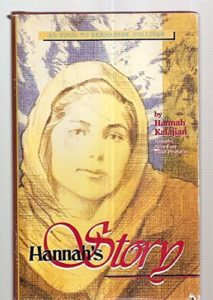
Cover, biography of Heranoush (Hannah)
The ten-year-old Armenian girl has to flee from Duzce, a village close to Constantinople (now Istanbul), because of an imminent attack on her community by the country’s Turkish overlords. The “gendarmes,” her family is warned in 1920, have laid waste to a nearby village, “slashing, raping, robbing, and killing” Armenians. Heranoush Gartazoghian’s family and other fugitives must trek through the mountains to find a sanctuary. It is an ordeal of pain, hunger, and exhaustion. In Hannah’s memoir (the name she took in the U.S.), she recalls her mother’s struggle to keep her family’s spirits up. Once she pretends to cook a pot of pilaf over the fire: “ ‘Now the pilaf is cooking,’ she croons. ‘It will be ready soon! How good it will taste! Can you smell it?’ ” Hannah remembers sitting in “the cold ground, hugging our knees, hypnotized. I am sure I can smell the hot pilaf and see the glow of the flames.” (The autobiography is titled Hannah’s Story.)

Logo of Near East Food Products
The dream of making and eating pilaf will continue to animate her life. In 1962, Hannah founded Near East Food Products, which popularized packaged ingredients for rice pilaf, bulghur, couscous, tabbouleh, and many similar products in America. Very early, she displayed the qualities of courage, persistence, and ingenuity that would later serve her well. On her early, harsh journey, and on several others to follow, she was nothing if not indefatigable. Journalist Dolores Courtemanche, who interviewed Hannah in 1989, was impressed by how “dogged” the innovator was.
Born in 1910, Hannah is the fourth daughter of Mateos, a wealthy meat dealer, and Cohar, the daughter of a priest. The aromas of her childhood home permeate her memory: “I would dream of the good smells of home, the bulghur (cracked wheat kernels) cooking, the big iron pans of parag-hats (Armenian cracker bread) baking over the open fire, the apricots and raisins spread out to dry.” Along with the joys of growing up, she feels the animosity of the Turks, who call the Armenians giavors (heathens).
In 1915, after the breakout of war, Turkish soldiers come and grab her father and other Armenians. They are ordered to “serve” in the army. Mateos starves to death in an army labor camp. Her mother works in the tobacco fields to support the family. Hannah helps out cleaning, sewing, and preparing pilaf, which she carries out to her mother. The dish was made from scraps of wheat the workers gathered in the fields.
Five years after her father’s death, Hannah’s flight from her village is a hundred-mile slog through rugged terrain. After their grueling trip, the family finally reach Constantinople. Believing that their journey is over, Hannah exults: “Forgetting the journey, enraptured by the pointed spires, the minarets, the great Hagia Sophia and the Bosporous Bridge in the morning sun, I dart here and there like a wild rabbit.” But her joy is short-lived. Seeking sustenance for her daughter, Cohar places Hannah in an orphanage. During her confinement, Hannah extracts small pleasures, like learning how to make lace, but contracts pneumonia. Her mother takes her away to stay with her and Hannah gradually regains her health.
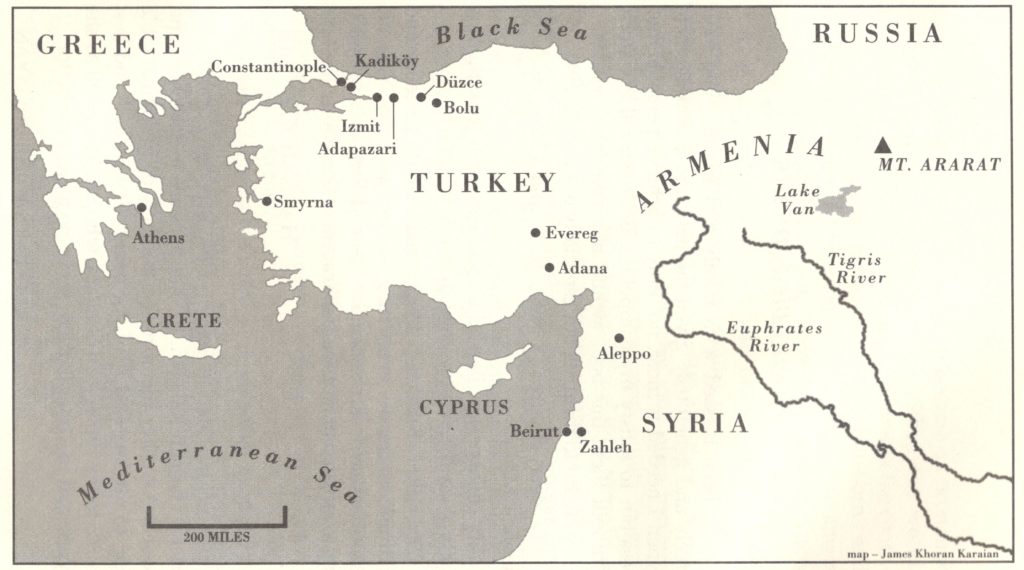
Map of Turkey a century ago
On the mend, Hannah one day explores the city’s bazaar. Looking back on the exhilarating experience, she thinks the spectacle awakened her commercial drive: “Ah, the shimmering jewels, the silken shawls, the bright carpets, the sweet shops, the baskets of figs and almonds! And oh, the smells . . . the shish kebab, dripping and sizzling over glowing coals! . . . I am so excited and happy that I have no idea whether or not the raisins and roasted chickpeas—the promised chamich lablabco—ever fill my pockets. . . . I want to own every shop I see. I hate to leave the excitement, the bartering, the jingling of coins, the cries of the vendors.”
There was little time to savor the pleasures of Constantinople. Reports of brutal attacks by the Turks on the religious minority in Smyrna, a town to the south, force the family to join the exodus of fellow ethnics from the city. The constant dangers finally convince the Gartazoghians to leave Turkey. They pack up again and, with a little bit of cash from a sister living in America, buy a ticket on a ship bound for Beirut. After a rocky voyage, they land in Lebanon and head to Zahleh, a dreary river town that would later blossom into a luxurious mountain resort.
Hannah adapts to Zahleh with her usual persistence and determination. She begins attending school and soon snags a job cleaning a new Protestant minister’s church. Hannah parlays the job into a position as a housekeeper for the cleric. Juggling all these tasks, she manages to continue her studies and even wins first prize in the school’s final examinations.
Ever the voyager, Hannah decides to embark on a new journey. Dikranouhi, her older sister in the U.S., begs and begs for Hannah to join her in New York City. To pay for her passage, she trades in her last piece of financial security, the gold necklace Dikranouhi had given her.
She sleeps on the deck of the boat that is bound for Piraeus, the port of Athens. After arriving, she wends her way to a train station and, clutching her burlap satchel, climbs aboard a train for Paris. From there, Hannah boards another train for the port of Calais to meet a ship that will take her on the long Atlantic passage to New York. The thirteen-year-old will never see her mother again. She is taken to third class quarters at the bottom of the vessel, where she begins a lonely, painful passage until she has a stroke of luck. A handsomely dressed Armenian woman befriends the seasick, famished young girl. She lets Hannah share her cabin for the rest of the trip. She is treated to hot water, showers, and a new white dress. The ship stops at Ellis Island, where passengers are subjected to stern inspections and puzzling questions (“Do you have glaucoma?”). Passing the test, Hannah returns to the ship, which sails up the Hudson River to its dock. Her sister greets her and the émigré embarks on a new leg of her journey.
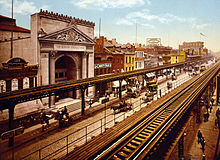
Third Avenue El, New York City
They board the Third Avenue El to Dikranouhi’s apartment in the Bronx. Hannah takes on the family’s household chores, tending to the children, cooking meals, all the time attending classes in the “foreign” section of a nearby school. Her interest in cooking is stoked on visits to the Balkan Restaurant, a dining room in the “Little Armenia” section of Manhattan. Hannah’s cousin is married to the owner. She delights in the “fragrant smells, shining utensils, and constant motion.” Hannah “haunted” the restaurant, reporter Courtemanche writes, “always asking questions.”
Determined to cut the apron strings to her family, she finds a job as a “touch up” worker in a Harlem rug plant. The debilitating works leaves her back in pain and her hands sore. Abandoning the job, Hannah winds up in a training program, monogramming initials on napkins, tablecloths, and towels. Hannah moves on again for a slot on the assembly line at the National Biscuit Company plant on the New York waterfront.
Hannah soon wearies of this job, as well. A tempting Christmas position opens at Bloomingdale’s, the Manhattan department store. She signs her name “Hannah Reader” on the application (Gartazoghian means “one who reads”) and lands a job as a salesclerk. She thrives on the “chaos and intensity of the workplace.” Moving up the clerical ladder, she gets a job at Gimbel’s, where she is assigned to the “Men’s Underwear Department.”
Note: Hannah’s Story: Escape from Genocide in Turkey to Success in America, the book by Hannah Kalajian (as told to Bernadine Sullivan), 1990, was indispensable to my piece. JSD
[End of Part I]
Part II: Hannah gets married and builds a business.
“Sometimes You Feel Like a Nut”: An Immigrant and His Candy Bar

Peter Halajian
It is an improbable story. In 1890, a newcomer to America, an Armenian born in Turkey, takes a job in a rubber plant in Naugatuck, Connecticut and moves on to try his luck in the candy business. The young man, Peter Halajian, was seeking refuge from the oppression and economic hardship his people suffered under the Ottoman Empire. Halajian would become the founder of the Peter Paul Manufacturing Company, the maker of the Mounds Bar. Its 1980s jingle, “Sometimes you feel like a nut, sometimes you don’t,” advertised its marquee products, Mounds and Almond Joy.
Halajian was following a path pursued by many Armenians who journeyed to the U.S. in pursuit of jobs in the country’s surging manufacturing economy. Companies hired the immigrants in the industrial heyday of the late nineteenth and early twentieth centuries to fill low-rung, cheap labor jobs. Woolen mills; wire, iron, and steel plants; and packing houses put the recruits to work. Immigrants sometimes knew little of their destination other than the name of the plant whose reputation had lured them. Armenians arrived in Lynn, Massachusetts, historian Robert Mitak points out, in search of the White Shoe Company, rather than the industrial town outside Boston. Unwilling to accept these positions as their permanent lot, Armenians were known for their eagerness to break the bonds of factory life. Entrepreneurial independence was a goal that Halajian shared with many of his compatriots. “As soon as I could I started a business on my own for I do not like to work for other people” one Armenian told the U.S. Immigration Commission.
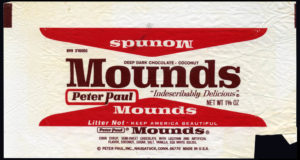
Early Mounds candy bar wrapper
Naugatuck, where Peter Halajian settled, was located in a region that was a seedbed of early American manufacturing. Drawn by the Naugatuck River Valley’s abundant and cheap water power, employers built thriving mills in Ansonia, Waterbury, Seymour, and Shelton, names familiar to anyone who has heard a conductor recite them on a Metro North train. These firms made brass, chemicals, rubber, and other basic industrial goods.
The economy of Naugatuck revolved around rubber, an early enterprise in the western Connecticut town not far from New Haven. It was here in the 1840s that the industrialist Charles Goodyear developed the pioneering methods of vulcanization. The U.S. Rubber Company, founded in 1892, as a giant combination of small businesses, was a magnet for immigrants. Many laborers lodged in tenements and rooming houses on Rubber Avenue and its nearby streets. The city, from which naugahyde got its name, was also known for Keds, the shoes assembled by workers at U.S. Rubber.
Rubber was so dominant in Naugatuck that other, less visible businesses were overshadowed. Gregg Pugliese, a native of what he calls this “factory town,” was fascinated by its rubber industry when he decided on a graduate school research project. In the course of his investigation, the then-social studies teacher at the local high school stumbled on an enthralling part of Naugatuck’s lore, the history of Peter Halajian and the Mounds bar. Previously unknown to the young man of Italian ancestry, this story brought him a wider and more enthusiastic audience than a chronicle of the rubber industry ever would have. Pugliese recounted the saga in lectures and articles.
As Pugliese tells it, Halajian’s stint in the rubber plant was a relatively brief one. He quickly tired of the regimented factory routine. As soon as he met his quota of piecework, typically by early afternoon, Halajian would begin peddling baskets of fruit and homemade candy with his daughters, Mary and Lillian. They sold their wares to people who filled the Naugatuck train station and other stops along the busy rail line that ran the length of the Naugatuck Valley. Halajian also went from house to house hawking his products and soon opened a fruit stand.

Ad for Peter Paul’s candy store
In 1895, he established his own candy store in Naugatuck vending peanut brittle, licorice, lemon drops, caramels, and other sweets, as well as fruits and ice cream. He wooed customers with handbills promoting his products, according to the Famous Brand Names blog:
Peter Paul has very good food
You don’t throw any down the chute
His delicious ice cream your dreams will haunt
The more you eat it, the more you want
Ice cream soda the year round
No better soda was ever found
His homemade candy will make you fat
To Peter Paul, take off your hat.
As sales increased, Halajian added another store in Naugatuck and opened one in nearby Torrington.
The entrepreneur dropped Halajian, his last name, and legally changed it to its English equivalent, Paul. The signs on his shops carried the name “Peter Paul.” The pressure of selling to an American market would similarly force the Colombosians, another Armenian business family, to change the name of their yogurt to Colombo. “Nobody could pronounce our name,” son John Colombosian told me.
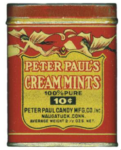
Peter Paul’s Cream Mints
From retailing, Peter Paul jumped into manufacturing. Teaming up with five Armenian friends—Calvin K. Kazanjian, George Shamlian, Jacob Hagopian, Harry Kazanjian, and Jacob Choulijian—he launched the Peter Paul Manufacturing Company in New Haven in 1919. The group pooled together $6,000, each putting up $1,000. In their 50’ by 60’ loft, husbands and their wives made their own candies at night. Since they had no refrigeration, this was a necessity. The system had its rewards: Products were ready to be sold fresh in the morning. Peter Paul turned out a line of lollipops, candy kisses, peanut brittle, and other popular items. The company’s first breakthrough was the Konabar, a mixture of nuts, fruit, chocolate, and what would become the business’s trademark flavor, coconut. In 1921, one of the partners, George Shamlian, concocted a recipe for a dark, bittersweet chocolate candy with a creamy coconut filling. The Mounds bar was born, and a marketing slogan—”What a bar of candy for five cents!”—was coined.
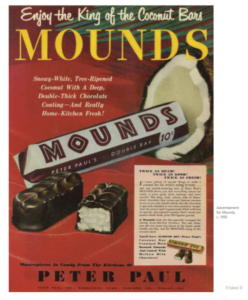
Ad for Mounds bars
Assembling the new product was laborious. The candy had to be shaped, rolled, dipped by hand in chocolate, and then wrapped in foil. Before long, the business was burgeoning and the company was outgrowing its space. The factory also desperately needed machinery to more efficiently meet their rising demand. The solution was to build a new facility. With a $35,000 loan from the Naugatuck National Bank, the partners left New Haven and, in 1922, built a plant in Naugatuck, where Peter Paul had learned the candy trade. With new equipment, they transformed what had been a handicraft operation into a larger-scale factory. During the 1930s, machines to coat chocolate, wrap the candy, and to refrigerate their products were installed. Unlike some other firms, Peter Paul was able to withstand the Depression and even to prosper. New items like Thin Mints, After Dinner Mints, and Bachelor Bars (filled with sesame seeds) supplemented their top-selling Mounds bar.
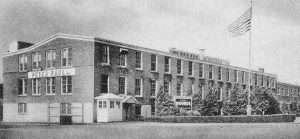
Peter Paul factory in Naugatuck
Peter Paul, who had been ailing, died in 1927 and his associate, Cal Kazanjian, took the helm. The new chief, as writer Liana Aghajanian pointed out, won over customers with a personal touch: “Mr. Kazanjian used to carry a little box of ‘Mounds’ around with him,” wrote reporter Wesley S. Griswold in The Hartford Courant. “When he entered the broker’s office, he would take one of the coconut bars out of his pocket, remove its tinfoil cloak, deftly break the chocolate-covered confection and offer the broker a taste.”
During World War II, the company’s fortunes continued rising. Shortages of sugar and other ingredients pushed Peter Paul to concentrate its efforts on producing Mounds bars. The military became the company’s largest customer, ultimately buying 80% of its products. The firm shipped out 100,000 pounds of candy a day. Considered a high-energy item, the Mounds bar was now an essential part of the soldiers’ rations. “There’s a lot of religion in a candy bar,” one military chaplain said, according to Patch.com poster Terri Takacs.
The business developed into the world’s largest consumer of coconuts. So vital was this raw material that Peter Paul had to create an ingenious supply route when its Philippines source was cut off by the Japanese invasion. The company sent a contingent of small schooners to islands in the Caribbean to buy coconut. The “Flea Fleet,” as it was called, was not bothered by the Germans. But the boats were able to gather valuable intelligence about the routes the Nazi ships were taking. As an extra bonus, Greg Pugliese reports, Mounds provided the military with empty coconut shells to make gas masks.
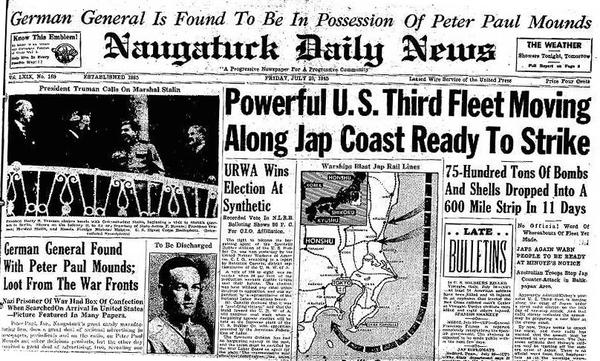
Newspaper headline: Nazi found with Mounds bar
Peter Paul’s service to the military stayed a secret until a search of a Nazi prisoner of war extradited to New York uncovered a Mounds bar in his belongings. “German General Is Found to Be in Possession of Peter Paul Mounds,” read the headline in the July 20, 1945 issue of the Naugatuck Daily News. “Sticking out like a sore thumb among the array,” the paper wrote, was the chocolate candy. Speculation was that the Mounds bar had been stolen from an American PX in Europe.
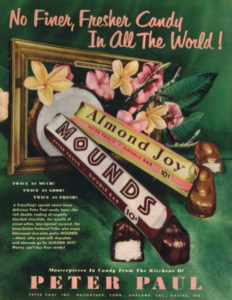
Ad for Mounds and Almond Joy candy bars
By the end of the hostilities, the fame of the company’s product had spread. The Mounds bar already had a loyal customer base among G.I.s and their families. A companion candy, Almond Joy, was introduced in 1946. The firm took clever advantage of new media, first radio and then television, to advertise its products. Mounds was the first candy company to buy time on network color television in the 1950s. The singing Peter Paul Pixies were featured in ads extolling the Mounds bar as “indescribably delicious.” The company also hired broadcasting personality Arthur Godfrey as spokesman for their brand.
Armenians took great pride in Peter Paul. Some even bought stock in the company, lawyer Harry Mazadoorian observes. Holiday dividends were paid in free candy bars. The candy’s flavor, one Armenian observed in an email response to an online article, was transporting: “When we first immigrated to America, Mounds bar was our family’s favorite,” Silva Elmedejian wrote. “It was closest candy to middle eastern taste. Now I know why. Proud of our . . . Armenian ancestors. I will keep on eating them until I die.”
Like many small firms, low on capital, it was hard for Mounds to resist the overtures of bigger companies when they came courting. Cadbury Schweppes bought the enterprise in 1978, and Hershey’s acquired it ten years later. In 2007, Hershey’s shut down the Naugatuck plant, which had been manufacturing Mounds for 85 years. Jack Tatigian, a long-time company executive, mourned the demise of the factory: “In Naugatuck, you worked for the rubber company, the glass company, or the candy company,” he told The Naugatuck Republican-American. The facility that had long made a product, the brainchild of Armenian immigrants, was discarded, swept aside as if it were a used candy wrapper.
Whose Pizza Is It? An Armenian Adventure
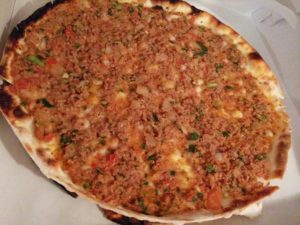
Lahmadjoune from Chez Apo. Photo by Denzil D’Sa. Instagram @reekooh.
A Lebanese friend had a bone to pick with me about eggplant. The vegetable, he said, did not originate in India, as I had written, but in his homeland. The urge to identify particular foods with one’s own ethnicity or nationality is an irresistible one. I was reminded of this exchange by an experience I had had on a recent visit to Montreal. During my stay, I had gone to visit Chez Apo, an Armenian bakery whose specialty was lahmadjoune, a product the shop called “Armenian pizza.” I was eager to find out what made their pie “Armenian.” (In this piece, I will be using “lahmadjoune,” instead of the Arabic “lahm b’ajin,” simply because of my Armenian themes.)
Over the years, I have been drawn, almost serendipitously, to Armenian food. When I lived as a young teacher on Lexington Avenue in the mid-twenties, on New York’s East Side, I discovered a restaurant, Palace d’Orient, nearby. It became a haunt of mine. At the time, I took its unusual cuisine for granted. I even gave little thought to its name, which, I later realized, evoked the alluring Middle East.
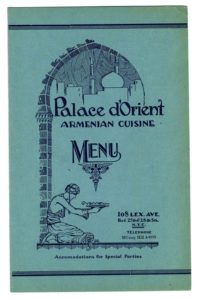
Menu of the old Palace d’Orient Armenian restaurant in New York
The small dining room had all the trappings of a luxurious establishment. At least, it seemed elegant to me, a roving bohemian attracted to snack bars and luncheonettes. Overpowered at first by the Palace, the culinary hideaway gradually grew on me.
Formally dressed waiters presided over the restaurant. They hoisted trays of dinner specials, which they delivered to well-appointed tables with white tablecloths. Platters of mussels stuffed with rice and currants and skewers of lamb shish kebab were presented to diners. I remember savoring a curious dish, baked eggplant topped with a rich tomato sauce and luxuriant with olive oil. Thinking back, it might have been imam bayildi (“the priest fainted”). Its extravagance was suggestive of the grandeur of the Ottoman Empire. Yet it was on the menu of an Armenian restaurant, whose proprietors’ forebears were members of a large Christian minority ruled by Turks. In retrospect, this was a paradox, but not one I pondered at the time.
The Palace was one of several restaurants that sprang up in Manhattan’s Little Armenia neighborhood. An Armenian Orthodox church, St. Gregory the Illuminator Cathedral, anchored the district. Several rug stores were located nearby. The restaurants have vanished, but one landmark of the old community’s retailing past remains. Kalustyan’s on Lexington Avenue between 28th and 29th Streets was opened by an Armenian businessman in 1944 to market familiar foods to his fellow ethnics. Kerope Kalustyan had planned to export steel to Turkey but decided to try his luck in the food trade.
By the 1950s, the shop’s wide selection of grains, spices, and lentils had caught the attention of new arrivals from India. Kalustyan’s was a lifeline for South Asian immigrants who had few places that carried their foods. “They were the only game in town,” Indian food writer Madhur Jaffrey told journalist Vikram Doctor. Writer Jimmy Breslin, she adds, observed how proud the owner was of carrying supari, “a kind of nut from India and Kerope may be the only one in America who stocks it.”

Basterma. Photo by Joumana Accad.
The owner shrewdly expanded its offerings to capture these new patrons. Kalustyan’s even launched its own brands of chutney and mango pickles. As Little Armenia gradually disappeared, Indian shops and restaurants took its place. The section was now dubbed “Curry Hill” (the larger area is called Murray Hill). The store has changed hands several times and is currently run by a Bangladeshi. Middle Eastern products are still for sale, but the shop is more widely known for its vast website, an online catalog of traditional as well as new-wave ethnic items. Visiting the store in 1996, food writer Regina Schrambling marveled at the emporium’s novel wares: “dried herbs on the vine from Greece and Sicily, sour cherry products to cater to Iranian customers, shelf-stable, ready-to-eat Indian meals, Irish butter alongside labneh. It has a wall of salts, from Antarctica and the Kalahari Desert and Italy and Germany and Cyprus…. It also carries a global array of even things as basic as sugar: Belgian, Balian, Japanese, jaggery, coconut, palm.”
Some years later, I ventured into an Armenian grocery store in Marseilles, a port city that is home to a large community of these ethnics. In this entrepôt for trade with the Levant, Armenian merchants had built a small colony by the early seventeenth century. In the late nineteenth and early twentieth centuries, a large influx of Armenian immigrants fleeing oppression in Turkey streamed into the city.
I was on a ramble in a multi-ethnic quarter of the city, where earlier newcomers had set up shop and which was now becoming increasingly North African. I nibbled sweets at a Tunisian bakery, peered at a plethora of spices in a Somali-owned shop, and dined at a festive Ivoirian restaurant, whose owner hugged me and introduced herself as “Mama Africa.” Soon, a pitcher of bissap, a crimson, tart, West African juice made from hibiscus, arrived at the table.
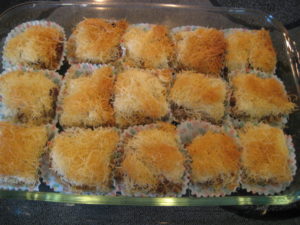
A tray of Armenian pastries, known as Kadaif. Photo by Robyn Kalajian, thearmeniankitchen.com.
Alimentation Murat, the Armenian store, represented an older immigrant era. The store, which advertised specialties of the “Orient,” was a remnant of a once-thriving commercial diaspora. The neighborhood once boasted “beaucoup” Armenians, a local told me. The grocery displayed an array of goods—chopped pistachios and other nuts, dried fruits, cherry syrup, orange blossom water, cans of okra, Mediterranean white cheese (like feta), and sweets like halva and kadaif (a pastry resembling shredded wheat). It had the flavor and atmosphere of a Middle Eastern food hall. At least one item, a dried, spiced beef called basturma, dear to Armenians, would have been a telltale sign to his clientele of the owner’s heritage.
On another food quest, digging through books for nuggets on the history of ethnic food, I chanced on a reference to Colombo yogurt. Apparently, this once exotic product, which I had first sampled at Skenderis, a former Greek grocery in Washington, had been conceived by an Armenian family. My curiosity whetted, I wanted to know more. I got in touch with Bob Colombosian, whose parents founded the business.
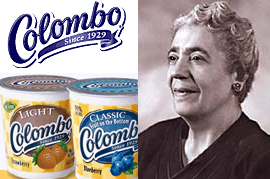
Rose Colombosian, who started Colombo Yogurt with her husband, Sarkis, in Massachusetts.
Rose and Sarkis Colombosian arrived in Lawrence, a city in northeastern Massachusetts on the Merrimack River, in the 1920s. They joined a growing Armenian community, the latest in a long line of settlers—French Canadians, Irish, Italians, Syrians—attracted by the city’s woolen mills. The Colombosians left Lawrence on the eve of the Depression, to start a dairy farm in nearby North Andover. On an impulse, they decided to peddle their homemade “madzoon” (yogurt) to Greeks, Lebanese, and Syrians in Haverhill, Lowell, and other towns with ethnic communities. In horse-drawn wagons, the vendors of the Wild Rose Dairy carried their product in quart glass bottles. They soon branched out to “mom and pop” groceries, Lebanese and Armenian shops in Lawrence. “The only place you could sell it was the ethnic stores in the beginning,” Bob recalled. They soon hit on a name for their yogurt. They called it “Colombo,” Bob said, because “nobody could pronounce their name.”
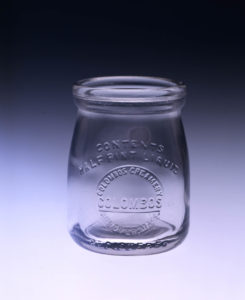
An early Colombo yogurt bottle, from the collection of the Massachusetts Historical Society.
A new client, the Mugar family, who owned two groceries in Watertown, a Massachusetts town with a large Armenian population, opened the door to a larger market for the Colombosians. The Armenian merchants who began carrying Colombo later launched Star Markets, a statewide chain. The entrée the owners gave the Colombosians to their supermarkets provided greater visibility and income.
Gradually, the Colombosians reached a wider market. By the mid-sixties, Bob and his brother decided to sweeten their brand. Although they continued to carry plain yogurt, they somewhat reluctantly adapted to American tastes. “American people like a lot of sugar,” Bob observed. The new product, a fruity custard, meant, he said, that “New customers wouldn’t spit it out when they took a bite.”

Rice pilaf with sujuk sausages. Photo by Joumana Accad.
I continued to stumble on Armenian foods. At Bacchus, an early Lebanese restaurant in Washington, DC, Usama El-Jallad, the flamboyant owner, explained the myriad items on his mezze (appetizers) menu to the uninitiated. As he ran down his roster of delicacies, flavored with mint, pomegranate molasses, sesame tahini, and other seasonings, he stopped to decipher the names of unusual dishes. One of them, sujuk, was unfamiliar to me. The tasty, spicy sausage, which he identified as Armenian, I later learned was a specialty of their kitchen.
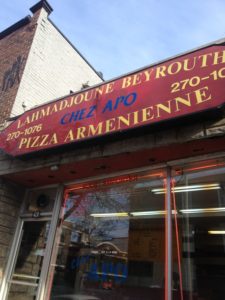
Sign over the front door of Chez Apo in Montreal, Quebec. Photo by Risa Dickens.
In the fall of 2017, I was at the doorway to Chez Apo, a tiny Armenian bakery in Montreal. I was on an expedition to uncover the mysteries of the shop’s celebrated product. Ever since I had seen “lahmadjoune” on signs in Armenian shops in the Boston area, I had been tantalized. The shop’s owners, Maro and Apo (a nickname for Abraham) Esrabian, had left Lebanon in 1976 in the aftermath of the country’s calamitous civil war. They settled in Montreal, burning with a desire to innovate, to build a different kind of business. They wanted to “start something homemade, old fashioned, something new,” Maro told me. Their enthusiasm more than made up for their inexperience: “We don’t know nothing,” Maro recounted. Drawing on their heritage, they decided to bake lahmadjoune, which they billed as “Armenian pizza.” (The word means “meat in dough.”) They fashioned the thin-crusted pie from flatbread and topped it with chopped meat and tomatoes. They seasoned their creation simply with garlic, onions, parsley, salt, and pepper. The shop’s drawing card, her late husband told writer Philip Sporzer, was a wood-fired oven. Building it would generate excitement: “In order for this to take off, I needed something so people would go ‘Wow!’ I wanted to please them and get customers. So we built the brick oven.”

Brick oven at Chez Apo, Montreal. Photo by Fadi Sakr.
They complemented their pizza with other items, many also turned out from the oven. Customers drove to the shop to pick up maneesh za’atar, a flatbread sprinkled with a blend of thyme and sumac that is a popular Lebanese breakfast repast. They also baked spinach pizza accented with feta cheese and fatayer, a kind of Middle Eastern turnover filled with meat or spinach. The Esrabians also offered the region’s classic appetizers, hummus and baba ghanoush.
I quickly turned my conversation with Maro to the question that preoccupied me: Who created lahmadjoune? While acknowledging that the word was Arabic-Turkish, her pizza, Maro said, was distinctive: “The name is the same but the taste is different in Arab countries.” The Armenian pie was “lighter” and not as “spicy.” It was the stronger, more pungent flavor of the Arabic flatbread product that distressed her. Similarly, she felt that the taste of Lebanese za’atar was too intense.
Compared to the passionate convictions of some ethnics about lahmadjoune, Maro’s views on the pastry were measured. Opposing sides have laid exclusive claim to it. When two Armenian restaurants recently opened in Russia, Turkish loyalists were enraged by their campaign to promote the pizza as uniquely “Armenian.” Assailing the alleged imposters, Turkish television commentators declared that the lahmadjoune belonged to their country. Interestingly enough, even in Turkey, different regions have squabbled over the pie, each claiming to be its rightful parent.

Middle Eastern Cookery by Arto der Haroutunian
Otherwise disinterested Middle Eastern food writers of Armenian background can become defiant when it comes to pizza. Arto der Haroutunian weighed in on the debate in his book, Middle Eastern Cookery: “I have never much cared for things chauvinistic, but even I, who have been brought up amongst people who, next to death, regard patriotism as a taboo subject, are obliged to scream, ‘Stop! Enough is enough!’” Lahmadjoune, he insisted, isn’t Arabic—and “that is final.” The author further argues that “to call this dish Arab because it has an Arabic name is ridiculous. The reason for its name was commercial. By that I mean when a minority lives among a majority, the former invariably uses the latter’s language for commercial purposes.”
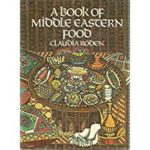
A Book of Middle Eastern Food by Claudia Roden
For some perspective on this culinary conflict, I decided to check in with two authorities on Middle Eastern food, two neutrals, neither of whom has a dog in the fight. In an email, Claudia Roden, the author of the groundbreaking A Book of Middle Eastern Food, reflects on the difficulty in assigning ancestry: “It is Turkish but also Syrian and Lebanese and you find it in other Middle Eastern countries. Some of my relatives made it at home. Jewish bakers in Egypt made it. Armenians make it too but I don’t think it originates from them.”
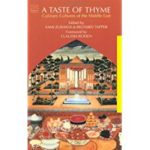
Cover of A Taste of Thyme: Culinary Culture of the Middle East, by Richard Tapper and Sami Zubaida.
Sami Zubaida, a Middle Eastern food scholar and expert on the politics and culture of the region, points out that the area’s diverse groups eat similar foods. The pie “is common in a wide region of Anatolia and the Arab Levant, until recent history inhabited by many ethnicities, Turk, Arab, Kurd, Greek, Assyrian, and Armenian,” he wrote me. “They shared a roughly common food culture.”
Their responses made me reexamine my own preconceptions. I knew from my own writing and research that food is often a product of a jumble of cultures rather than of one land or nationality. Even though I understood this argument intellectually, I frequently (as in my conversations with Maro Esrabian), looked for convenient pigeonholes for foods. I began thinking of another way of illuminating “Armenian pizza”—it belonged to the Armenians only in the sense that they put their own imprint on a shared pastry.
Armenians may not be its parents but because they were prominent bakers as well as purveyors of lahmadjoune and other Middle Eastern specialties, it was natural for many to think so. The association was an easy one to make. The Armenians, for example, controlled the “bread and pastry” trade in Aleppo, Syria for three hundred years, Sonia Uvezian, a culinary historian of the Middle East, notes.
To attempt, then, to pin down the exact genealogy of the pizza is to ask the wrong question. Zubaida puts it well: “Armenians were, and are, renowned in the region as fine cooks and caterers. As such they have excelled in many culinary fields. But that is different from attributing ‘ownership,’ which is impossible to determine. I have argued that it is geography rather than ethnicity.”
The Armenians came from a long trading tradition. Outsiders in the Middle East, they capitalized on their ancient nation’s position as a “Christian island in a Muslim sea,” to use historian Philip Curtin’s image. These “cross cultural brokers,” Curtin argues, carried goods to distant destinations. In the eighteenth century, Armenian merchants processed caviar from sturgeon eggs and shipped it to Russia. Goods from the East, like Persian silk, were transported west, to Amsterdam and other towns. They were also pioneers in the popularization of coffee. In the 1670s, an Armenian from Marseilles opened the first coffee houses in Paris and other towns, Curtin points out. They also operated most of France’s early cafés. Because of their prowess, Armenian Christians became the consummate traders and artisans in the Ottoman Empire.
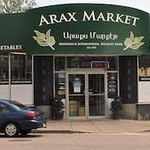
Arax Market, an Armenian grocery in Watertown, Mass.
The Armenians have been especially adept in merchandising foods, whatever their origin, to receptive customers. New York City’s Kalustyan’s, as noted earlier, morphed into a grocery that targeted both Middle Easterners and Indians. In their early settlements, Armenian grocers attracted shoppers with a varied assortment of goods, without neglecting their own favorites. Historian Robert Mirak uncovered a fascinating description of one early store in Chelsea, Massachusetts: “There was merchandise strewn everywhere. Long, rigid baloneys and sausages hung from hooks in the ceiling; barrels of nuts, flour, cracked wheat, and squash seeds lined the walls. Tubs of olives and swimming Greek cheese had been shoved under tables on which rested tins of Armenian pastry, herbs and all sorts of canned stuff.”
Armenians continue to play an influential role in the food business. Most of the Lebanese restaurants and groceries that Middle Eastern food scholar Charles Perry profiled in a 1992 Los Angeles food guide were owned, he said, by Armenians. Today, the cluster of Armenian grocery stores in Watertown, Massachusetts, a town near Cambridge, attracts buyers from many backgrounds, with its cornucopia of Arabic and Mediterranean products. Her experience running Chez Apo has taught Maro Esrabian an important lesson. If she catered only to her own people, she told me, “long time ago I closed.”
Unconstrained by any and all ethnic boundaries, some Armenians have burst into the American fast food arena. In 1992, two brothers, Aro and Allen Agakhanyan, opened Big Mama’s and Papa’s Pizzeria in Los Angeles. From this early shop, they built a chain of more than twenty businesses. The brothers concocted a Giant Sicilian Pizza, a 200-slice pie, which they claim is the largest ever to be delivered. Their outlets sell pizzas along with such standbys as Philly cheesesteaks, Greek salads, chicken wings, and potato skins. Big Mama’s gained national fame at the 2014 Oscars when Ellen DeGeneres ordered their pizza to share with the luminaries.
For an article on a similar theme, see food historian Rachel Laudan’s piece, “What’s the True History of Pizza? Consider Argentina.” A collection of her writings is available at http://www.rachellaudan.com/.
Blood on the Vine: The Passion Fruit
The fresh acidity of the juice was a regular pleasure of my year-long stay in Dar es Salaam, the Indian Ocean port in the East African nation of Tanzania. On my weekly excursions to Haleeds, an Arabic-Persian hole in the wall restaurant near Dar’s Indian quarter, I enjoyed a glass of passion fruit juice with my standard order of moushkaki, spicy chunks of beef barbecued on a grill outside the eatery. The meat came with chapati, the Indian round bread.
I imagined this as my first passion fruit experience. The fruit, I found later, was actually an ingredient in Hawaiian Punch, a favorite drink of my childhood. The large blue can of tropical potion passed for exotica during the barren 1950s.

Passion Fruit Mousse
As the years passed, I began stumbling on passion fruit in my explorations as an ethnic food writer. Cans of the carbonated juice lined coolers in the food shops of the Ironbound, Newark, New Jersey’s Portuguese enclave. On my visits there, the Brazilian Bakery on Ferry Street, the main spine of the neighborhood, was one of my first destinations. (A large influx of Brazilians has settled in the neighborhood in recent years.) On my train trip to New Jersey from Washington, I fantasized about the passion fruit milk shake, a specialty of the bakery. The passion fruit mousse in its display case tantalized me.
Play Ball, a Portuguese-owned lunch counter a few blocks up from the bakery, offered its customers an array of tropical fruit drinks ranging from papaya to tamarind. Passion fruit was one of the refreshments that the restaurant made from its storehouse of frozen concentrates.
In Montreal, which has a large Portuguese community, passion fruit was a staple of the drink offerings at my wife, Peggy’s, and my favorite barbecue house, Mile End Churrascaria Portugal. Swigging a glass of the fruit drink was a perfect accompaniment to the delightfully charred and spicy peri peri chicken brought from the grill to our table.
Back home in Washington, hip eateries were uncovering the delights of tropical produce. At Rocky’s, the late Columbia Road restaurant, chef Paul Petit was turning out jerked shrimp, Caribbean chicken curry, and guava-laced barbecue and creating inventive passion fruit treats. Owner Rocky Scott was attracted to the fruit because of its “tropical” associations. She served up passion fruit iced tea and hurricanes, a blend of its puree and orange, pineapple, and lime juice with doses of rum and triple sec. It infused Rocky’s chutneys and added a tingle to the menu’s creamy cheese cake.
Near Rocky’s, the Brazilian Grill from Ipanema dining room featured a batida, a strong drink made with passion fruit. The cocktail married maracujá (the fruit’s Brazilian name) with vodka and cachaça, a sugar cane brandy. A little sugar and condensed milk were added to the cocktail. The drink packed a wallop.
Passion fruit was now in vogue. Bartenders whipped up new drinks with the novel item and smoothies made with the juice were fashionable. I watched aspiring pastry chefs on the Great British Baking Show, the public television program, enhance their productions with its flavor.
Despite my infatuation with the fruit, I knew little of its background. I set out to uncover its mysteries by reading the works of botanists, chefs, anthropologists, and food historians.
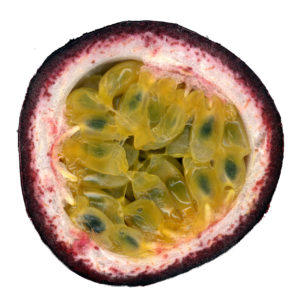
Seeds fill a cut-open passion fruit
The fruit, which I had assumed from my Tanzanian experience was African, actually originated in the Americas. Purple and yellow varieties of the egg-shaped fruit, were the most widely marketed types. Granadilla (“little pomegranate”), the Spanish name used in parts of Latin America, was an allusion to the many brown and black seeds that fill its orange-yellow pulp.
The plant is a climbing vine known as much for its brilliant blooms of white, orange, red, and purple flowers as for its luscious fruit. (Its scientific name is Passiflora.) The ideal setting for the plant is the wildness of the tropical rainforest. Nourished by heat and humidity, it can climb 15 to 20 feet a year. Clinging with its tendrils, the plant pushes its way to the canopy of the forest.
The route to understanding passion fruit led inevitably to Brazil. The vine was native to that country and the surrounding region. From the tribal peoples, the Portuguese settlers learned about the plant’s special qualities. The colonists began referring to the fruit with its Indian name, maracujá. As the plant spread, the name stuck, even in Spanish speaking countries like El Salvador and Peru.
Passion fruit later traveled to the mother country. Sweetened with sugar, which began pouring into Portugal from Brazil’s plantations in the mid-sixteenth century, it would become an important element in the country’s repertoire of sweets. Bakeries marketed passion fruit tarts, puddings, and mousses. Sweet, tart passion fruit juice also gained popularity. Undoubtedly, the Portuguese transported maracujá as they did pineapples, cashews, and other crops, within their empire. It may have reached Mozambique, historian Timothy D. Walker speculates, in Portuguese ships stopping over on their voyage around the Cape. At this East African way station, the fruit might have been helpful in protecting sailors and passengers against scurvy. From there, its journey to Tanzania possibly began.
Initially, it was not as a tangy fruit but as a healing agent that maracujá endeared itself to the Portuguese. The plant, the Indians taught them, worked wonderfully to remedy fevers. European physicians were soon persuaded of its medicinal benefits. From the sixteenth and eighteenth centuries, the Materia Medica of Cambridge University, scholar Geri Augusto points out, listed it as a curative.

Passion Fruit growing on vines
In Brazil, it was the Jesuits who, in their missionary work with the native peoples, acquired the early knowledge of medicinal botany. Arriving in the mid-sixteenth century, friars pioneered in collecting information about the properties and uses of tropical plants. Other fruits prized by the Indians joined the maracujá in Portuguese medical lore. The juice of pineapple was praised for its ability to dissolve kidney stones. The fruit of the cashew tree, it was believed, alleviated fevers and stomach ills. (The cashew apple is the red and yellow fruit to which the familiar nuts are attached.)
The Jesuits, historian Walker found, established a network for treating patients with the drugs and for spreading the word about their discoveries. Members of the religious order were permitted to operate as druggists (boticanias), dispensing treatments to the sick. Apothecaries and infirmaries run by the friars were set up in Brazil and other parts of the Portuguese realm. The Jesuits even controlled two of Portugal’s major pharmacies. Their shops were well stocked with plant-based remedies like maracujá. The Jesuits, Walker adds, also passed on their learning to Portuguese administrators, naval commanders, merchants, and other officials. Medicinal extracts were sent to Goa, Macao, and other colonial outposts.
The Fathers also profited from their ventures. “Missionary orders relied on revenue from this trade to support their proselytizing work,” Williams points out. “The market for colonial medicines in Portugal was largely their exclusive domain for over 200 years.”
The Jesuits and other missionaries were convinced that passion fruit was not only a curative for the body but a godsend for the soul. They began calling the plant “passion flower” to evoke the Passion of Christ, his trials and suffering before his death.

Passion Flower
Missionaries in Latin America transformed the flowers into religious symbols. In the eyes of the proselytizing Christians, each segment of the flower became an emblem of the crucifixion. Jacomo Bosio, a 17th century monastic scholar working on a treatise in Rome on the Cross of Calvary, popularized the image of a sacred flower. Bosio seized on the drawings and descriptions of a singular flower sent by priests from “New Spain.” He wrote that the flower represented Christ’s torture. The floral crown with its blood red fringe symbolized the crown of thorns, “the Scourge with which our blessed Lord was tormented.” Its 72 filaments represented the exact number of thorns on Christ’s head. The three stigmas stood for the three nails on the cross and the stamens for the five wounds Jesus suffered.
Missionaries used the flower in their campaigns to convert the Indians. It was a tool, writer Clara Ines Olaja argues, to teach “the infidel Indian the truculent history of the passion of Christ.”
Excited by its symbolism, a party of Jesuits in 1605 honored Pope Paul V with a gift of the plant. They gave the pontiff a sketch of the passion fruit along with dried samples of it. He was enamored of the offering and its fame spread in Italy. “Members of the intelligentsia and ecclesiastic leaders were eager to acquire knowledge of the extraordinary flower,” the website of the History of Medicine and Ecclesiastic History notes.
To the clergy, the maracujá was providential. For one Portuguese-born priest, Franciscan Father Antonio de Rosario, the plant represented the plenitude of the New World. Writing in the early eighteenth century, according to scholar Federico Palomo, Rosario viewed it as a blessed offering from God. It was “the flower which the land produced for the glory of the Creator.” In the Eden of the Americas, the plant was an auspicious sign to the settlers. It also had more somber overtones. For Rosario, God had designed the “mysterious flower” to reveal “the deplorable tragedy of the Passion.”
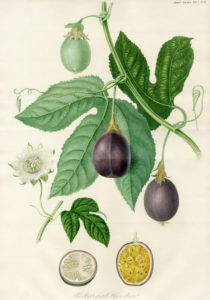
Passion Fruit growing on a vine
The passion fruit exerted a powerful hold on the imagination of European writers and artists. In the Natural History of Brazil, authored by the Dutch physician William Piso and the German naturalist Georg Marcgraf and published in 1648, the maracujá is extolled. The first book to introduce the varied plants of the country, Brazilian specialist Amy Buono explains, highlights the dazzling qualities of the flower and fruit: “[T]he coloration of the interior of the flowers produces an iridescence in a broad range of cerulean purples, blooming fully three hours after dawn. The fruits, though, are produced primarily in the rainy, summer months.” The writers, Buono continues, were struck by “the black seeds contained within the fruit, and the delicious acidity of the black seeds inside.”
Passion fruit could do wonders for one’s health, she adds: “The fruit pulp can be used against fevers and can serve as a substitute for ‘cordial syrup,’ having various remedies, including numbing the teeth, restoring the body from heat exhaustion and thirst, awakening the appetite and guarding against stomach pains.”
The Natural History was also careful to emphasize the spiritual qualities of the plant. Even the tendrils, which enabled the passion fruit to climb, had a spiritual purpose. They stood for the whips used to maim Christ.
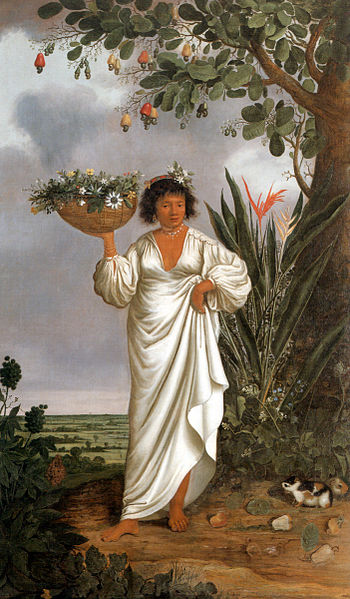
Mameluca, an oil painting by Dutch painter Albert Eckhout
Painters, scholar Buono observes, were also drawn to the passion fruit. In Mameluca, an oil painting by the Dutchman Albert Eckhout in 1611, its flower plays a central role. The mameluca, a woman of mixed blood stands beneath a caju [cashew] tree. With one hand, she held a basket of flowers among which was a prominent large white passion flower. With her other hand, the mameluca lifts her white gown.
Now a salable commodity, the passion fruit lacks the aura it once had. Sumol, the Portuguese beverage giant, is constantly seeking new outlets for its line of passion fruit and other soda drinks. As sales of its products have declined in Portugal, the company has looked to former colonies in Africa, like Angola, to pick up the slack. Cans and bottles of maracujá in stores from Newark to Luanda are a reminder of the nation’s once vast empire and its large diaspora.
Mauritius on My Mind: A Culinary Voyage
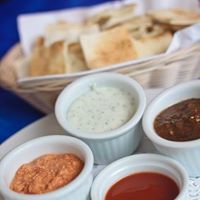
Flavorful dipping sauces at Aux Iles Bleues in Montreal
Coconut, mint, and lime; birds-eye chili pepper; tomato, shallots, and cilantro; peanuts and tomato. Toussaint Attiave carried a plate with four bowls of these tantalizing dipping sauces to our table on the terrace of his recently opened Montreal restaurant, Aux Îles Bleues (“The Blue Islands”).
They were chutneys (chatinis in Creole), he said, traditional starters that whet the appetite for the main meal in Mauritius, his Indian Ocean island birthplace. The chutneys came with a basket of pieces of toasted pita bread. The bread in his homeland, Toussaint added, would have been roti (a generic word in Indian languages for bread, adopted in Creole, the Mauritian tongue).
Toussaint had come to Montreal in 1976 to study engineering. He decided to stay after meeting a “beautiful Quebecoise” woman, Dominique, whom he married. Some of her paintings hang in the dining room, which is painted in shades of blue with red accents.
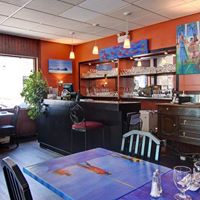
The colorful dining room at Aux Iles Bleues in Montreal
Passionate about cooking, he opened a restaurant, Café Classico, in the town of Sherbrooke. His new venture in Montreal’s Plateau neighborhood highlights the cuisines of the Indian Ocean islands of Seychelles and Réunion and features the food of Mauritius.
The restaurant offers patrons a choice of cooking sauces, which include Creole, Tandoori Masala, and Coco Seychellois, to accompany either seafood, pork, chicken, or other mains. I decided on Mauritian cari, to invigorate squid, shrimp, and scallops. His curry, Toussaint remarked, had a healthy dose of cumin and coriander seed. “Everybody eats curry” in Mauritius, the restaurateur noted.
I was delighted to find a Mauritian restaurant. The volcanic island, 1200 miles off the eastern coast of Africa, had long fascinated me. I fantasized about its rich diversity. Imagine an island over two-thirds of whose population is of Indian background. Indians live with a much smaller group, the Creoles, which traces its origins to Africa, as well as with a community of Chinese. What kind of food, I wondered, would spring from this heterogeneity?

A painting by Toussaint’s wife Dominique at Aux Iles Bleues
In my Mauritian quest, I bought guidebooks, cookbooks, and historical studies of the island. I searched for Mauritian eateries not only in Canada but also in Marseilles and London. The Indian Ocean island, I discovered, had enchanted many writers. Mark Twain, impressed by its “luxuriance of tropic vegetation,” spoke of its many ethnicities: “French, English, Chinese, Arabs, African, East Indians, half-whites, quadroons.” He talked to an islander who told him that “Heaven was copied after Mauritius.” The French poet Baudelaire, who had been banished to India by his father “to be cured of love,” left the boat in Mauritius. He extolled “a perfumed country that the sun caresses.” He rhapsodized about “purple trees,” palms, that “weep idleness,” and “dark enchantresses.” Another visitor, Charles Darwin, observed that “the various races of men walking on the streets offer the most interesting spectacle.”
It was during the year I spent teaching in a refugee school in Dar es Salaam, Tanzania, that the seeds of my enthusiasm for Mauritius were first sown. The East Africa city was part of the same Indian Ocean neighborhood as Mauritius. Dar was a port city along the country’s Swahili coast where African, Indians, Arabs, and Persians had all left their imprint. This was not the stereotypical one-dimensional “dark continent” I had expected.
Dar had a large Indian quarter where the Asians lived and sold their wares. One evening, I was treated to a hot curry at the home of an Indian Muslim family, whose son was a friend. The family shop, as was often common, sat below their apartment. Indian food was not foreign to the city’s taste. I was surprised to find a local eatery, the Cozy Café, selling samosas.
The Indians had dispersed throughout the country. Traveling outside the city, I noticed the inevitable dukas, their general stores, which sold everything from brooms to dried fish.
I grew restless with the African food served at the school. Lunch was invariably ugali, a dish of mashed up maize with gravy, a kind of Tanzanian fufu but without the spicy sauce. I hungered for more exciting fare. I discovered Haleeds, a small eatery run by an Arabic proprietor. For a few coins, I enjoyed mishkaki, spiced cubes of barbecued beef that were cooked on a small grill outside the shop. It came with chapati, an Indian flat bread. I washed down the meal with a glass of fresh passion fruit juice.
I pursued other adventures. When a fellow teacher married a Punjabi woman, I went to their wedding and was introduced to one of Dar’s most vital communities, whose roots went back to the early Sikhs recruited to build a railroad in East Africa.
Surrounded by the Indian Ocean, I was excited to live in a gateway to mysterious lands. Lured by the romance of the port, one evening a friend and I roamed the vast expanse of the docks. Ships regularly left East Africa for India. On a visit to Mombasa, the Kenyan port city, I stared with amazement at a boat in the harbor, whose top deck was packed with Asian families. They would sleep and eat their meals on the deck over the long voyage.
Nearby islands also beckoned. I visited the island of Zanzibar, once a center of the slave trade and the world’s top exporter of cloves. As I walked through the harbor, I could smell the aroma of the pungent spice. I explored the narrow streets and gazed at the intricately carved doorways of Zanzibar Town, the capital of an island once ruled by the Sultan of Oman.
I rode out in a taxi to the outskirts of the city. We passed coconut trees whose shells dotted the ground. As we walked outside, I detected the unmistakable fragrance of lemongrass. The driver peeled off the bark of a cinnamon tree to show me.
My appetite for future island trips was whetted. Cruise shops frequently stopped at Dar to pick up passengers who wanted to visit the Indian Ocean islands of Mauritius, Réunion, and the Seychelles. Unfortunately, I missed this opportunity and ever since I have regretted it. I was especially curious about Mauritius and could only imagine its blend of flavors and cultures. Short of a trip there, I would have to make do with a vicarious excursion. Perhaps an outing to a Mauritian restaurant would satisfy my desire.
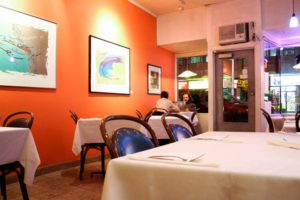
The dining room at Toronto’s Blue Bay Cafe
Finding such an exotic eatery was not simple. It would be at least fifteen years before I uncovered one. It was, ironically, in Canada, home to many Mauritian emigrés, not in the U.S., that I reached my culinary destination. Planning an early trip to Toronto, I called the Mauritian embassy in Washington on an impulse to see if the city had any eateries serving the island’s food. An official suggested I try Toronto’s Blue Bay Café.
One early evening after our arrival in the city, my wife and I embarked on an expedition to find the dining room. We took a trolley car to the end of the Dundas Street line. Looking out the window, I saw signs in Portuguese advertising restaurants, cafés, and other businesses clustered along several blocks. We got off at the last stop and walked from the switching yard through several gritty blocks to the Blue Bay.
We climbed a narrow staircase to a small room, modestly decorated with travel posters. The unusual menu, which transported us to the Indian Ocean world, made up for the lack of atmosphere. It listed samosas among the starters, an early clue to the provenance of the food. I dug into an achard, a pickled salad of cabbage, carrots, and other vegetables. I had encountered variations of the piquant mix in Malaysian, Indonesian, and Thai restaurants—all with similar names. The Creole word, achard, descended from the term for pickled foods in several Indian languages. Achar, the Indian name, likely has a Persian lineage.
The pickled appetizer has wide appeal in Mauritius. It has even entered the island’s folklore. An official letter, according to cookbook authors Paul Jones and Barry Andrews, was sent from the island to the Queen. It was returned because of a yellow stain on the envelope. The color probably came from either turmeric or the mustard seeds in the relish.
Another item on the Blue Bay menu, Fish Vindaye, also had an odd backstory. Vindaye, a Creole word, stemmed from an Indian delicacy, vindaloo, created in the Portuguese colony of Goa. The Iberians introduced one of their specialties, vina d’alho, meat steeped in wine vinegar and garlic, to their subjects and the Goans reinvented it. They spiced the dish with saffron, mustard seeds, chili, and other flavorings. Indians took it to Mauritius. “On Maurice the name got ‘Frenchified’ into ‘vin d’ail’ and ended up as ‘vindaye’ in Creole,” the Dutch website Coquinaria points out.
Other Blue Bay offerings suggested other histories. The restaurant sometimes prepared daubes, braised chicken or other meats that had a definite French note. The menu’s mines frite, a noodle stir fry with shrimp, reflected Chinese technique. The owners, I learned, were of Chinese background, a fact whose significance I did not yet fully grasp.
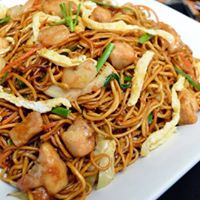
Stir-fried noodles at Les Delices de L’Ile Maurice
The Blue Bay, now closed, was an initiation into Mauritian cooking. I still had much to learn. Some years later, on a trip to Montreal, Peggy and I had another Mauritian adventure that was as much performance as culinary experience. After a long trek from the Verdun Metro station in eastern Montreal, through a down-at-the-heels area with many “à louer” [“for rent”] signs, we reached Les Délices de l’île Maurice. We were greeted by a portly gentleman of Chinese background, Sylvestre Ng-Kan, who wore a Hawaiian shirt and Bermuda shorts. The effusive chef, who had trained in Montreal restaurants, showed us a large map of Mauritius and regaled us about his country. The restaurant had little formal menu. Sylvestre asked what kind of sauce we would like—Creole, curry, etc.—and what type of fish or meat. My memory gets hazy then, but I do recall that one of the sauces was redolent of cloves.
Before we could order, we were given a complimentary bowl of tangy yellow split pea soup. It reminded me of dal sorba, the lentil soup that is a fixture of many Indian restaurant menus. But the connection between the soup and the larger mosaic of Mauritian food was still blurry.
Several years later, my wife uncovered a Mauritian restaurant that had recently opened on Montreal’s Boulevard St. Laurent, the “Main,” as locals called it. The city’s main north-south street had once been considered a divide between the French- and English-speaking communities. La Ravanne (named for a Mauritian musical instrument) was located in an area where many ethnic restaurants had sprouted.
One dish at the eatery especially captured my attention. The gâteau piment (chili cake) sounded French, but the taste and the ingredients of the popular Mauritian snack spoke of its tropical parentage. These doughnut-shaped fritters, made from yellow split pea flour, had an Indian feel to them. The crunchy and spicy starters were accompanied by a yogurt salad of cucumbers and carrots. At the time, I thought little of the appetizer. Looking back now, I suspect that it was kin to raita, a similar Indian dish. One other characteristic stood out. The owners of La Ravanne, like those of the Blue Bay and Les Délices, have Chinese roots. (The restaurant, unfortunately, is no longer open.)
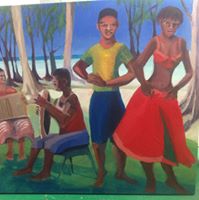
Painting by Toussaint’s wife Dominique
Intrigued with its food, I gradually learned that its story was inextricably connected to the island’s history. Mauritius had been shaped by a succession of invaders and peopled by diverse ethnic groups. It was uninhabited. It had no “aboriginals,” Toussaint observes. Its cuisine was the result of the intermingling of cultures. Without a fixed identity, the islands would have to forge their own.
The Portuguese, early voyagers seeking a route to the spice treasures of India, stumbled on Mauritius in 1507. Ship captain Diogo Fernandes Pereira called it the Ilha do Cerne, the Island of Swans. (The island actually had none of these birds.) Except for using it as a refueling stop, Mauritius had little interest for the Portuguese.
The Dutch, also traders, established a more permanent presence. Seizing control in the early sixteenth century, they named the colony Mauritius after Prince Maurice von Nassau, their ruler. The Dutch transplanted sugar from their Indonesian possessions. Although the crop would ultimately flourish and become the foundation of the island’s wealth, it provided little in the way of short-term returns; the Dutch grew impatient and moved on.
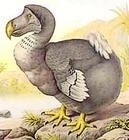
The ill-fated dodo bird
They stayed long enough to hunt one of the island’s few indigenous species into extinction: the ungainly, flightless bird they called the doudou, their word for “stupid” (the creature’s name was later changed to dodo). The dodo may have been scorned, but its flesh was nonetheless cooked to fill the bellies of the Dutchmen.
The most influential of the island’s occupiers, the French, arrived in 1715. The colonizers turned Mauritius into a bastion of sugar. Rainforests were slashed and replaced by plantations. Cane thrived in the red volcanic soil. Now the governing elite and landowning class renamed the island Ile de France. They imbued the society with their language and culture. Most islanders today speak French, but Creole, a vernacular offshoot of the mother tongue, is the lingua franca.
To cut the cane, till the fields, and process the sugar, the French imported African slaves, mostly from Mozambique and Madagascar. Their descendants and those of mixed race are known as creoles.
Another European power, the British, set its sights on the sugar isle. In 1815, during the Napoleonic Wars, the French lost control of the island to the interlopers. Despite their defeat, the French continued to dominate the sugar industry and to maintain their Gallic culture and Catholic religion.
The English decision to abolish slavery and the slave trade in the early nineteenth century led to a radical change in the island’s population. Slaves began to abandon the plantations, creating a severe labor shortage. Sugar, the economic engine of the islands, required new hands. The English turned to their Indian colony for laborers. Just as would happen in Caribbean colonies like Trinidad, indentured workers were shipped in to replace the old workforce. The complexion of Mauritius changed as more than 300,000 Indians poured into the island between 1834 and 1910.
The Indians themselves were a polyglot group. Those from the South carried different traditions than those from the North. The new arrivals also spoke a mélange of languages—Tamil, Telegu, Hindi, Marathi. In addition, a significant number of the Asians, some 15%, were Muslims.
Over the years, many of the once disdained “coolies” lifted themselves up or elevated their children into higher status professional and commercial occupations. The Indian community acquired political clout. When the island gained independence in 1968, Mauritius’s first Prime Minister was Seewoosagur Ramgoolam.
Although a small portion of the population, another group of outsiders left their mark on the island. Attracted by economic opportunities, 7,000 Chinese immigrants arrived in Mauritius in just five years, between 1895 and 1900. Some became skilled workers, but the most important group were small businessmen. It was the Chinese who opened retail shops that catered to the Creoles in the small islands and villages. Speaking before the Colonial Assembly in 1885, Governor Sir John Pope-Hennessy argued that the entrepreneurs were indispensable: “We all know that at almost all the crossroads of the island are to be seen the well-built stone residences and shops of the Chinese that have sprung up within the last few years; and those Chinamen undoubtedly manage to sell the poorer classes of this community cheap and simple goods which the poor people wish to buy.”
Mostly bachelors in the beginning, the community, organized around clans, expanded with the arrival of family members. The ethnics have built pagodas, launched two daily newspapers, and popularized their culture among the islanders. As Chan Low, a local historian, told writer James Wan: “Chinese cultural events now see the participation of all kinds of Mauritians. If you go to Chinese shops, you find people of all communities buying Chinese food and goods, and even traditional practices, like the dragon dance, are performed by non-Chinese Mauritians alongside Sino-Mauritians.”
Melding such a mixture of cultures, ethnicities, and nationalities into one unified society has often been difficult. Relationships, for example, between Creoles and Indians have sometimes been tense. A common language, however, has helped create a common bond. Indians, whose forbears once spoke Bhojpuri may cling to their ancestral tongue but also communicate with the Chinese in Creole.
The varied strands of Mauritian culture have been woven together to form a national identify and a common cuisine. “We take it together and make it our own,” Toussaint points out. Different culinary traditions have been “creolized” in the island crucible. The boundaries between different kinds of food have broken down. Indian flavors seep into Creole food and vice versa.
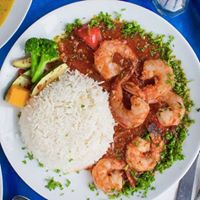
Shrimp Rougaille at Aux Iles Bleues
First and foremost, there is the overarching sway of French cuisine, which has lent island cooking a sophistication and flair. The colonists brought metropolitan foods like cheese, wine, and pain maison. French cooking styles have also been remolded. The tomato-based sauce of Provence, for example, has been transformed. To the pomme d’amour, as the Mauritian tomato is known, has been added the bite of chili and the kick of ginger, garlic, and other spices. The classic Mauritian dishes served at Aux Îles Bleues, rougailles, are products of this marriage between French and Creole cooking. The word rougaille came into Creole via the French cooking term roux d’ail (a flour and fat roux infused with garlic).
As spices became more integral to Mauritian cooking, the taste buds of French islanders adapted. One nineteenth century writer, whom authors Jones and Andrews quote, remarks on the change: “They chew nutmeg and chilies as if they were sweets, and their pale features will hardly pink in the inferno of these condiments.”

Samosas at Les Delices de L’Ile Maurice
Indian words, slightly adapted, crept into the vocabulary of Mauritian food. Briani, Farata, samoosas, and the aforementioned vindaye are just a few examples of the borrowing. In addition to dishes of Indian origin like cari and khorma, basics of its kitchen like rice and dal (peas and lentils), have been assimilated into the culinary culture. Indian condiments turn up on the tables of other Mauritian ethnics. “Indian pickles are eaten with French dishes and, similarly, Chinese dishes are eaten with Tamil pickles and chutneys,” Madeleine and Clancy Philippe note in their cookbook, The Best of Mauritian Cuisine.
Indian cooking itself has undergone a metamorphosis. Caris [curries] may be less fiery and more delicate than their Indian counterparts. Mauritians “tried to make Indian food French,” Toussaint suggests. The ethnics have also acquired new tastes. Achard, the pickle-y relish, may sometimes be remade with palmistes or palm hearts. Octopus has joined the repertoire of Indian curries.
Chinese immigrants made their own contributions to island food. A new starch, noodles, caught on with locals; at Aux Îles Bleues, customers can choose between rice and noodles to accompany their main dishes. Mines Frite, stir-fried noodles, lost their ethnic associations and joined the national menu.
The Chinese played a key role as purveyors of Mauritian dishes. They were the first group to open restaurants, Toussaint points out. Chinese eateries, he says, serve up both Chinese and Mauritian offerings.
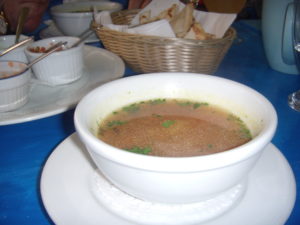
The Vegetable Soup with pineapple at Aux Iles Bleues
In all its variety, Mauritian cooking was coming into sharper focus. I continued to pick up revealing details about the food of this “cosmopolitan mix,” to use Toussaint’s image. For example, the vegetable soup with tart pineapple we were served at Aux Îles Bleues had puzzled us. Peggy and I wondered how it fit into Mauritian cuisine. In a later conversation, Toussaint explained. It was actually a sweet and sour soup inspired by Chinese tradition. There was still much more to explore on the menu. Maybe next time I’ll order the octopus cari.
NOTE: Two useful Mauritian cookbooks are:
• A Taste of Mauritius, by Paul Jones and Barry Andrews.
• The Best of Mauritian Cuisine, by Madeleine Philippe with Clancy Philippe.
How Sweet It Is: Portugal’s Egg Custard Tart
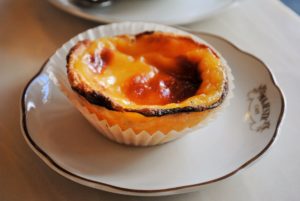
Pastel de Nata
Some years back, my wife, Peggy, and I were on a pilgrimage to Belém (Bethlehem), a district in Lisbon a short distance from the city center—not to visit religious sites, although there were hallowed monuments at our destination. We were heading there to sample the pastel de nata, the country’s celebrated egg custard tart, at its most renowned purveyor, the bakery Antiga Confeitaria de Belém. These were not just ordinary pastéis, which are commonplace throughout the city, but pastéis de Belém, pastries reputed to have come from the original recipe.
Belém is the site of the Torre (tower) de Belém, a fortress erected in an imperial age to guard the mouth of the Tagus River. The poet Fernanda Pessoa called the tower “a magnificent stone jewel.” This outpost was Portugal’s gateway for voyages bound for the East. It was where Vasco da Gama launched his journey to India in 1496 and where other captains embarked in their pursuit of gold and spices. Close to the tower is the impressive monastery, Mosteiros Jerónimos, home to clerics and a resting place where Vasco da Gama and other notables are entombed.
In days past, tourists eager to visit these shrines would climb aboard steamboats at Lisbon’s docks to make the trip to Belém. Now, tour buses arrive to bring visitors like us to the Confeiteria. Customers place their orders for tarts, which come to the counter hot from the oven. The pastries are sweet and creamy, with blackened caramelized patches atop the custard. They also have delightfully flaky crusts. Customers can sprinkle cinnamon and powdered sugar on the pastries.
The café has a series of interconnecting rooms decorated with typical Portuguese blue and white tiles where patrons savor their pastéis, often with a galão, coffee with a bit of milk, or a bica, an espresso. The reverent visitors frequently leave with tarts in specially designed paper packages. They are “wrapped in pairs, married one on top of the other,” one admirer observes.
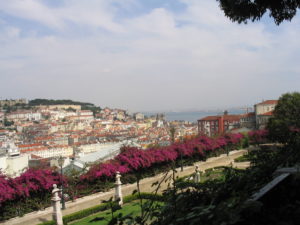
A view of Lisbon and the Tagus River
An aura of mystery still surrounds these tarts. They are said to be baked “by master confectioners” who tightly guard the secret recipe. The pastel de nata tradition originated with the Monastery, where convent nuns devised a recipe for these temptations and began selling them. Convents and monasteries in the sixteenth and seventeenth centuries were much more than religious institutions. They were also festive places for royal banquets, birthdays, and weddings.
Eggs, whose yolks were central to the making of these custards, were abundant in convent kitchens. Ovos provided a basic protein in the dietary regimen of the religious orders. Chickens, a common sight around the peasant household in Portugal, were a source of currency. They were bartered for meat and other dearer items or simply sold to make money. Convents frequently bought their eggs from the poor.
Eggs remain a mainstay of both sweet and savory Portuguese cooking, writer Andrea Smith points out. They are mixed into many bacalhau (cod) dishes like Bacalhau a Brás, which features salt cod fried with potatoes, onions, and scrambled eggs. Or they may flavor a bread soup, which comes with a poached egg. Even a fried egg, historian Virgilia Nogueiro Gomes notes, could be ennobled: “Frying an egg was an art. It was used with savory food and could be served as a dessert, topped with sugar to make the yolk very creamy. Then we could make little bread soups in the sugar-filled yolk. . . . The difficult part was ensuring that the egg white was well cooked and the yolk was still runny.”
The word for fried egg, estrelar, Andrea Smith suggests, may have a celestial association because it is derived from estrela, the word for star. I have speculated, myself, that the term Pastel de Nata may also have Christian overtones. The word nata has its roots in Portuguese words relating to “birth.”
The nuns used beaten egg whites in ironing clothing. Priests’ robes, nuns’ habits and headdresses received this treatment. The many leftover yolks, the story goes, were exploited to make doces conventuais (convent sweets)—puddings, custards, and other sweets. At fairs and other celebrations, nuns vied with each other to prepare the best confections.
The convents were crucibles of pastry creation. The names of sweets reflect their strong religious inheritance. Pão de Deus (god’s bread) is a bun with a luxuriant sweet coconut topping. There were other confections called “nuns’ tummies,” “angels’ cheeks,” and “bacon from heaven.”
Custard tarts were sold at the monastery until the early nineteenth century. The Liberal Revolution of 1820 in Portugal, however, forced the closing of religious institutions. The original pastel de nata recipe, it is said, was bought by a nearby bakery. “Until the nineteenth century, monasteries were Portugal’s research, trade, horticultural, and confectionary epicenters, around which rose small businesses,” food writer David Leite remarks in his blog, Leite’s Culinaria. In the same location, today’s Confeiteria carries on the tart-making tradition.
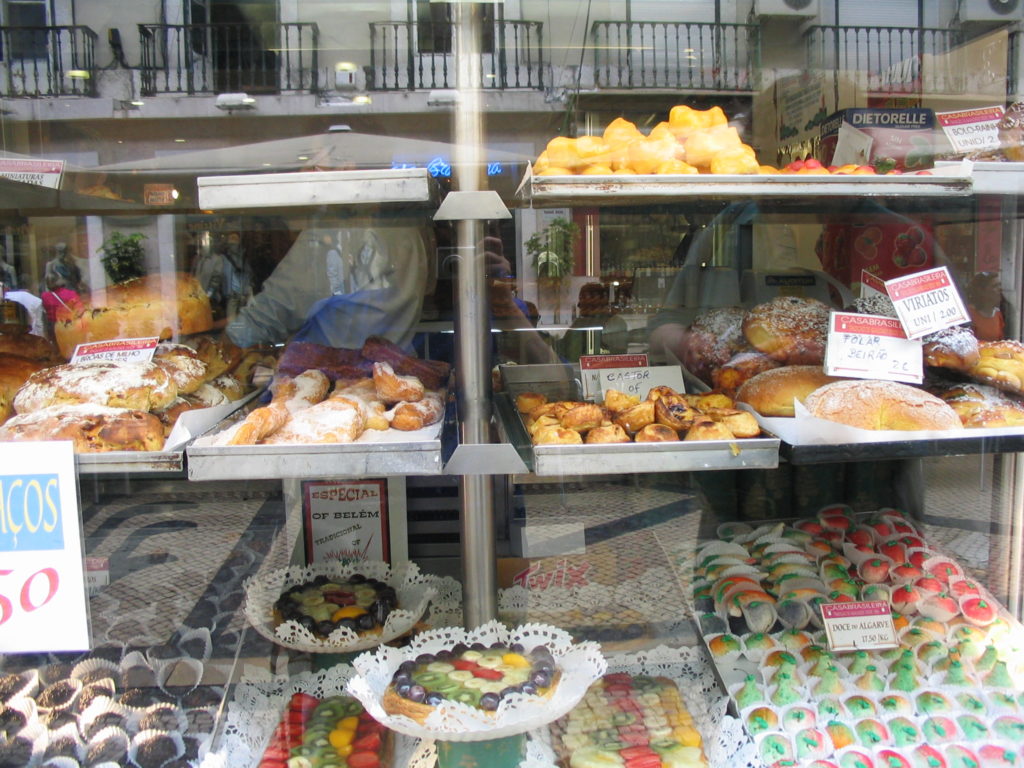
Pasteis de nata amid a variety of Portuguese sweets
The pastel de nata was transported throughout Portugal’s far-flung empire. It arrived in China, India, and Brazil, where the Iberians brought their convent sweets, along with their passion for sugar. The Portuguese, food historian Janet P. Boileau notes, were well known for their tastes: “‘There was no nation in the world so fond of sweetmeats as the Portuguese; they always handed them about on their social visits,’ the Dutchman Jacobus Canter Visscher wrote while visiting Goa in the 1750s.”
The colonists, Boileau points out, offered sweets as gifts to foreign dignitaries. She describes the luxurious array of sweets Vasco da Gama presented to the local king in Malindi, on the coast of Kenya: “When the king was entertained on board da Gama’s vessel, the dignitary was conducted to the quarterdeck, where a handsome table had been set out, with gold-embroidered Flemish napkins. He was offered a variety of conserves, confectionery, preserved almonds, olives and marmalade, served in silver dishes and accompanied by wine in gilt vessels.”
In former Portuguese colonies, bakers have invented their own version of the egg custard tart. In Macao, an English businessman opened a shop, which he called “Andrew Stow’s Coffee and Natas.” Lord Stow then franchised his bakery in Hong Kong. The trend has picked up steam. “Egg tart fever hit Hong Kong, Singapore and Taiwan in the late 1990s,” Andrea Nguyen writes.

Traditional Portuguese blue and white tiles
In Portuguese immigrant enclaves abroad, expatriates have also introduced their confections. I remember discovering sweet bread, pão doce, in the old fishing port of New Bedford, Massachusetts. Available in the region’s supermarkets, the bread, once reserved for holidays in Portugal, has become a routine treat. (A diner in Fairhaven, across the river from New Bedford, enticed its customers with chouriço—Iberian sausage—omelettes.) On my many excursions to Newark, New Jersey, the second largest Portuguese settlement on the East Coast, I found pastéis de natas and a plethora of other sweets in bakeries, cafes, and restaurants. Sugar seemed to be an important part of Portuguese culture. On an early visit to the Ironbound, Newark’s Portuguese neighborhood, I was captivated as Carlos Fernandes, the owner of Play Ball, a local eatery, plunged a 3-foot stalk of sugar cane into a juicer. He then served me a refreshing sugar cane drink known as garapa.
At the time, I hadn’t realized how bound up Portugal was with the history of sugar. Conquering Muslims, who had learned the basics of sugar making in Persia and India, first took the crop west to the Middle East and into the Mediterranean. As the late anthropologist Sidney Mintz, the author of the history Sweetness and Power, comments: “sugar … we are told, followed the Koran.” The Moors, who gained control of the Iberian Peninsula in 711 A.D., ruled Portugal for five centuries. The occupiers, who planted sugar cane in the Algarve in southern Portugal, communicated their affection for sweets like candied fruits and almond-flavored egg yolk pastries. Before the Portuguese colonized Brazil in the early sixteenth century and started producing sugar for export to Lisbon, the Iberians had schooled themselves in sugar cultivation in their Atlantic colonies off the west coast of Africa—Madeira, the Azores, and São Tomé. The settlers, who were growing cane in Madeira by 1452, transformed the island briefly into the world’s largest exporter of sugar. “These islands,” Mintz observes, “were the stepping stones by which the [sugar] industry would move from the Old World to the New.” On his second voyage, Columbus, who had learned about sugar planting while working in Madeira, introduced cane to the Americas. In 1493, he carried it to the island of Hispaniola (which consists of the present-day countries of Haiti and the Dominican Republic) in 1493 from the Canary Islands (the Spaniards, who had colonized these islands, had also been keen sugar planters).
The pastel de nata enthusiasm continues to spread, even beyond the Portuguese diaspora. In recent years, shops in England have sprung up selling “Portuguese Egg Custard Tarts.” Berlin’s Café Galão, owned by a German businessman who became acquainted with the Portuguese in Hamburg, is a popular purveyor of custard tarts.
Some promoters of Portuguese foods would like to see them more widely disseminated. The minister of the economy, Álvaro Santos Pereira, highlighted the pastel de nata as an example of the nation’s “export potential,” the Portuguese Daily View reported. He urged confectioners to expand the global sales of the custard tart. Why was there not a “franchise of pastéis de nata,” he asked participants at a conference on competitiveness.
Other devotees of the pastry look more askance at its adoption abroad. Frederico Duarte, a designer who has researched his country’s baking industry, believes the custard tart is not easily replicated. The unique qualities of the Portuguese oven explain the pastel de nata’s supremacy: “From what they have explained to us, you have to have a furnace that bakes at 400 degrees and you rarely find one that does it abroad,” he told Lusa News Agency [the temperature is probably centigrade]. “That’s why cream pies abroad are almost always bad.” Outside of Portugal, the tart, Duarte says, is a pale imitation of the original. In Macao, he argues, the pastel is “adulterated.”
For myself, I can be satisfied with a pastel de nata that is short of perfection. As I prepare for a trip to Montreal, which has a large Portuguese community, and a visit to my favorite bakery, Patisserie Notre Maison, I yearn for their egg custard tarts. They may not be pastéis de Belém, but they’re still divine.
“From Pushcart to Posh” — An Appreciation by Joel Denker

Russ & Daughters: Reflections and Recipes
from the House that Herring Built
By Mark Russ Federman
“I need a whitefish … It should be a nice one … My son, the doctor, is coming over for dinner… We want to introduce him to a nice girl … Her family is very well situated, thank you … Her father’s a big shot … Maybe this will work out, please God, and I’ll soon be a grandmother … No, don’t give me that one from the top. What do I look like? A greenhorn? I want from underneath. No, not that one. The one next to it. No, that one’s too dried out. You probably had that one left over from before the Flood … Why don’t you go to the back and get me a fresh one?”
Mark Russ Federman, whose grandfather Joel Russ founded Russ & Daughters, the temple to Jewish delicacies and other treats on the Lower East Side, tells this story, a composite of customers he encountered at his shop, as recounted in his book, Russ & Daughters: Reflections and Recipes from the House that Herring Built. The business lures customers with a wide array of products, from herrings, lox, sturgeon, sable, whitefish, and scrumptious salads, to dried fruits, nuts, and traditional sweets like babka, rugelach, and halvah. It has, over the years, introduced candied ginger, apricots, and orange peels as well as Turkish figs, Syrian dates, and Persian pistachios to its display.
Federman ran the store for 30 years (the third generation owner has passed the baton to his daughter Niki and nephew Josh). Federman, who has a gift for humor and gab, is a superb storyteller. His book, which has not received the recognition it deserved, is at once a full-scale portrait of a lively family and a chronicle of the evolution of an ethnic business. As a writer myself, one who has spent several decades trying to unearth similar tales, I was captivated by it. Russ & Daughters is a singular contribution to the history of ethnic food in America. The spicy details Federman offers up along the way make it even more delectable.
The saga of Joel Russ, the store’s patriarch, which Mark tells with vivid and enticing anecdotes, is a unique, but also a profoundly American one. He tells the story of his grandfather’s journey from the Jewish shtetl in Strzyov, part of an area called Galicia (in today’s southeastern Poland). His village was desperately poor, and growing up there was something Joel rarely spoke of. The 21-year-old arrived at Ellis Island on January 19, 1907, where the officials listed his occupation as apprentice baker. Joel had come to help out his oldest sister, Channah, who operated a herring stand with her husband on Hester Street in the Lower East Side. Taken from wooden barrels and wrapped in newspapers—typically The Forverts (Forward) or Der Tog (the Day)—the briny fish was sold to shoppers.
Herring was the mainstay of an important meal: “A poor immigrant would take home and unwrap the herring, put it in a cast-iron skillet with some sliced potatoes and onions, and then cook the dish in a coal-fired stove. With thick slices of black bread or rye or leftover Sabbath challah, this was a meal for an entire family.”
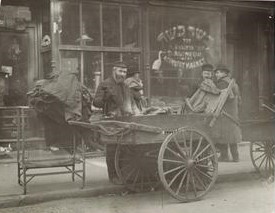
Street Peddler on the Lower East Side, New York
Joel moved up and acquired a pushcart—he later drove a horse and wagon. In the meantime, he had seen a matchmaker, who introduced him to his future wife, Bella Spier, also from his Galician homeland. Joel’s next steppingstone was a candy store, a cheap investment for many enterprising newcomers. A few years later, he established Russ’s Cut Rate Appetizing on Orchard Street. This shop was the parent of today’s more modern and sophisticated Russ & Daughters on Houston Street (he enlisted his daughters in running the business). The store is located today at 179 East Houston Street.
Near his old shop were a host of vibrant ethnic enterprises. A dairy store sold farmer’s cheese, ladled out milk, and vended tub butter. A deli made pastrami, corned beef, and tongue sandwiches, as well as hot dogs. Seltzer, which could be infused with different flavored syrups, was on offer at a local candy store. A mushroom store, next to the candy shop, sold a very popular item that was largely used for soups.
This book is full of tantalizing vignettes and anecdotes, but what stands out are some broad, universal themes in the immigrant experience. One is the toil it took Joel and his clan to build this business. For Joel, who worked uncomplainingly through the drudgery, this venture was only a pathway to what he hoped would be his final destination. His burning ambition was to get out of the teeming, dirty Lower East Side for less cramped spaces to stretch his elbows. Russ never idealized his neighborhood. During the 1930s, the Galician joined with other Lower East Side businessmen in a campaign to drive pushcarts out of the neighborhood. Ironically, although Joel was ultimately able to move his home outside of the Lower East Side, he was forced to keep his business there.
The appetizing store, Federman keenly observes, was an American invention that drew on Jewish tradition. These early shops, which inspired many a Sunday brunch, had no counterparts in Eastern Europe. There, pike and carp were bought for the Sabbath and salt herring sustained the weekdays. Russ and others carried new fish, unavailable in the Old World, like whitefish, sable, and salmon. These and other fish could supplement the old standby, herring.
Another motif that runs through immigrant history is what Federman called the transformation “from pushcart to posh.” Federman’s tale of how Russ & Daughters adapted to a changing neighborhood, where Lansky’s Lounge replaced Ratner’s Dairy Restaurant, where condominiums sprouted and “media consultants, graphic and fashion designers, computer experts, and bankers” settled, is brilliant. The owner had predicted this change: “Sooner or later, uptown will move downtown.” Federman, who had once been an attorney, was determined to maintain the older sensibility without stubbornly rejecting all change.
Customers’ tastes were changing: “I would look up from slicing lox and see a well-heeled, well-educated crowd of younger shoppers. Expensive baby strollers replaced old wire shopping carts. These customers didn’t buy many hard candies, but they did purchase fancy hand-dipped chocolates. And along with cream cheese, they also wanted sheep-and-goat-milk cheeses to accompany their smoked salmon.”
Product changes are recurrent ones in the ethnic food business. Charlie Sahadi, who runs Sahadi’s, the large Middle Eastern food emporium on Atlantic Avenue in Brooklyn, once explained to me the necessity of marrying ethnic wares with “specialty foods.” He teased his shoppers with both olives and low-fat McCann’s Irish oatmeal.
The “etzel-petzel” (seat of the pants) operation was also modernized and streamlined. When Mark’s daughter Niki joined the business, she took responsibility for “special projects” in a store that was acquiring not only national recognition but global reach.
Federman views his role as not only purveying fish but also merchandising “nostalgia.” He means nostalgia in the best sense of the word, as a longing for the richness of the past. The late Israel Shenker, who wrote for The New York Times, had a similar take on the allure of Jewish food. He called it “the heartburn of nostalgia.”
When I think back about the book, it’s the tiny, telling details that I recall. There’s the old-fashioned apple corer-peeler displayed in front of the store, which is still used to prepare apples for chopped herring salad. Federman is also at his best evoking the sensory experience of Russ & Daughters: “Push open the door at Russ & Daughters and the first thing to hit you is the store’s unique aroma. It’s a combination of smokiness from whitefish, salmon, sturgeon, and sable; the brininess of herrings and pickles; the yeastiness of freshly baked bagels and bialys; and the sweetness of rugelach, babka, chocolates, and halvah. How I wish I could bottle that singular scent—smoky, briny, yeasty, and sweet.”
For more about the history of Jewish food in America, see Chapter 5 of my book, The World on a Plate: A Tour through the History of America’s Ethnic Cuisine.
The Carrot Purple
And Other Curious Stories of the Food We Eat
By Joel Denker
How many otherwise well-educated readers know that the familiar orange carrot was once a novelty? It is a little more than 400 years old. Domesticated in Afghanistan in 900 AD, the purple carrot, in fact, was the dominant variety until Dutch gardeners bred the young upstart in the seventeenth century. After surveying paintings from this era in the Louvre and other museums, Dutch agronomist Otto Banga discovered this stunning transformation. The story of the carrot is just one of the hidden tales this book recounts. Through portraits of a wide range of foods we eat and love, from artichokes to strawberries, The Carrot Purple traces the path of foods from obscurity to familiarity.
Praise for The Carrot Purple:
Joel Denker’s breadth of knowledge is dazzling, his stories are packed with jewels of information, captivating, and amusing. Reading them is pure delight.
— Claudia Roden, food writer; author of The New Book of Middle Eastern Food, The Food of Spain, The Food of Italy, and The Book of Jewish Food
The Carrot Purple is a classic Denker product. Smart, intriguing, and elegantly delivered. Every chapter is a surprise and a surprisingly subtle argument about change and global flows that has shaped peoples’ food habits as much as roots and tradition. Denker takes academic research in various fields – botany, cultural studies, and history – extracts its essence and sharpens its delivery to the great pleasure of the reader, the eater, and the cook.
— Krishnendu Ray, Chair, Department of Nutrition, Food Studies & Public Health, New York University; President, Association for the Study of Food & Society
Joel Denker’s smorgasbord of historical essays about common and curious plant foods (and spices) that Americans eat every day makes for an uncommonly good meal for the mind. Well researched and wonderfully written, this popular history is as good, highly informative, and fun as it gets. Now, to find some purple carrots!
— Bruce Kraig, food historian; co-author of Man Bites Dog: Hot Dog Culture in America and co-editor of Street Food around the World: An Encyclopedia of Food and Culture
Mr. Denker has a searching mind, and a busy pen. Now he has given us a culinary syllabary. The Carrot Purple and Other Curious Stories of the Food We Eat offers readers a savory taste of just about everything, from anise and arugula to walnuts and watermelon. There is lots in between, set before us with the flavors of history and geography. If you have ever wondered idly why you have never seen a purple carrot, this is where you will find the answer.
— Sidney W. Mintz, anthropologist, Johns Hopkins University; author of Sweetness and Power
Reading Joel Denker’s zingy sketches of some taken-for-granted fruits, vegetables, and spices is like meeting fifty interesting people at a party and listening to a well-connected friend dish about each of them — “You want to know who climbed in bed with who before strawberries hit the charts?” “Arugula? Well, talk about nouveau riche!” For inquiring minds, the amply stocked bibliography is an added bonus.
— Anne Mendelson, culinary historian; author of Milk: The Surprising Story of Milk Through the Ages
Food historian Denker has compiled a fascinating collection of short essays on the history of many common fruits, vegetables, and spices in an effort to get readers to appreciate the fullness of these histories. He delves into each item’s historical importance, which cultures adopted it first, how it traveled, and what it was used for… The anecdotes are accessible and enjoyable, and he debunks popular misconceptions of how foods have achieved their present form.
— Publishers Weekly
Have you ever wondered where baby carrots come from? Denker (The World on a Plate) has the answer. Along with the secret origin of those vegetables, the author shares the backstories of 49 other foods in short essays aimed at a general audience. Readers will learn that asparagus is related to leeks and that the Mafia cornered the artichoke market in the 1920s, along with which herb is said to smell like a squashed bedbug (coriander) and what nut was known as Jupiter’s acorn (walnut). The essays delve into word origins, health properties (both proven and purported), preparation styles, and modern uses. — Library Journal
The Carrot Purple Is Available from:
Rowman & Littlefield (1-800-462-6420), Amazon.com, Barnesandnoble.com, and other online vendors in both hardcover and ebook.








